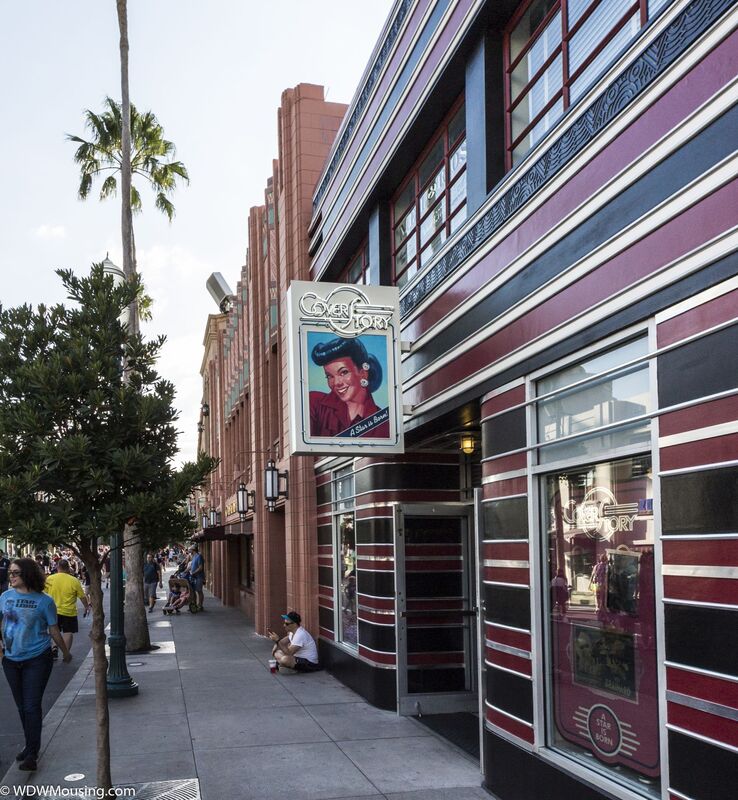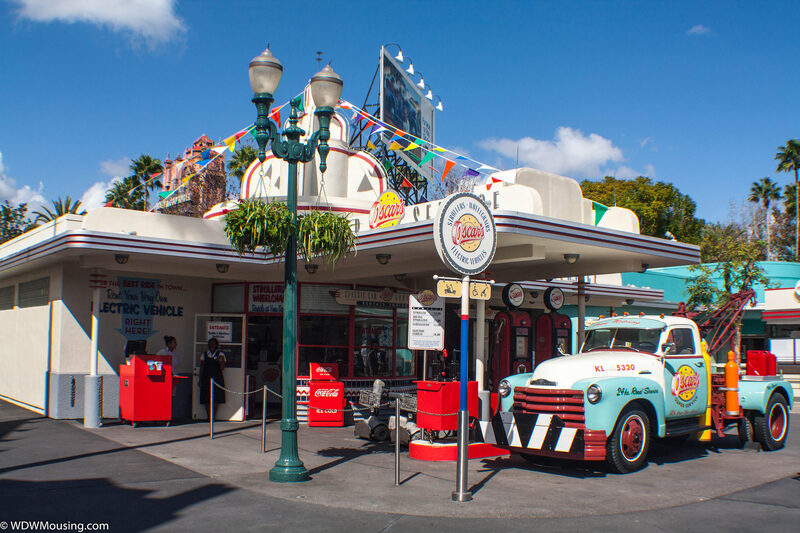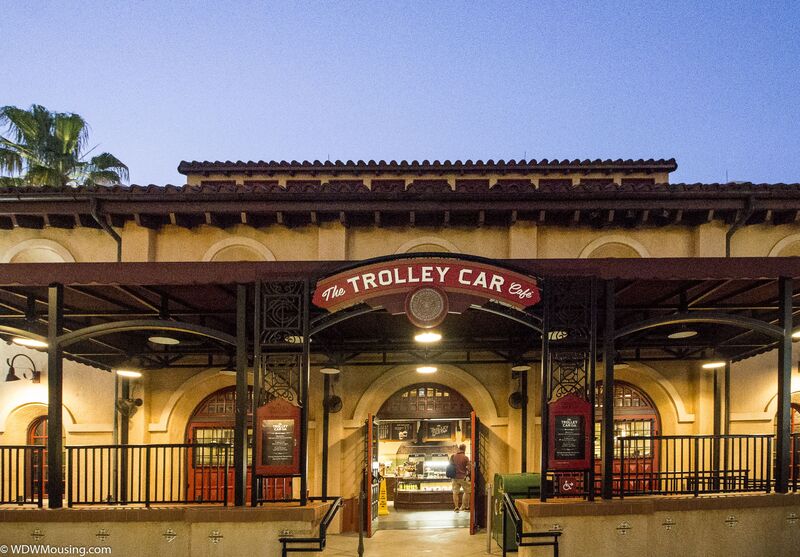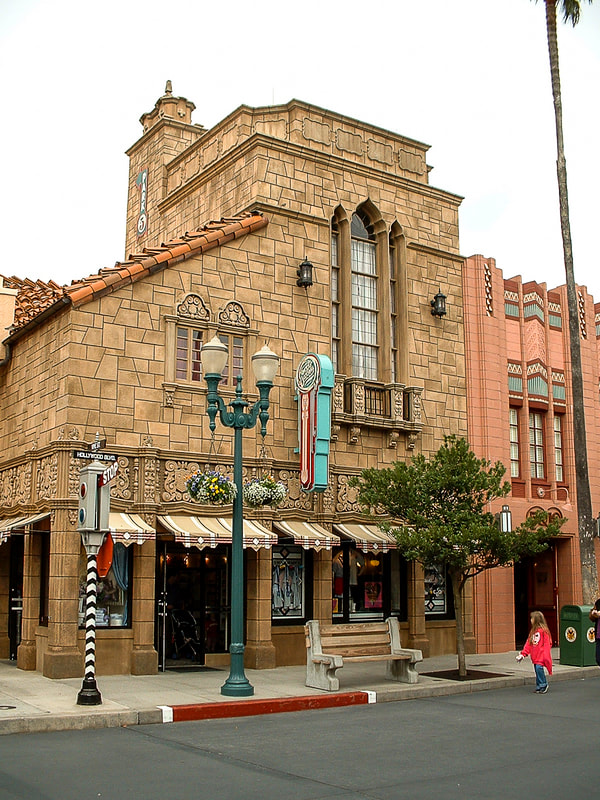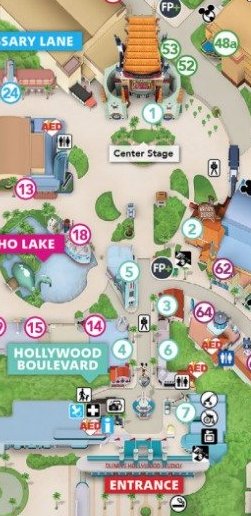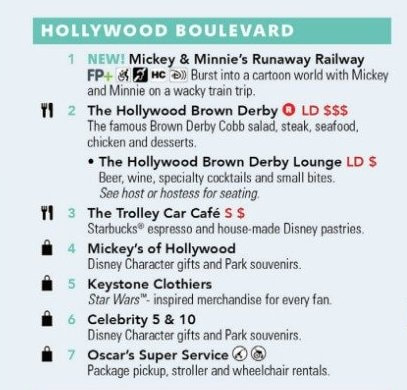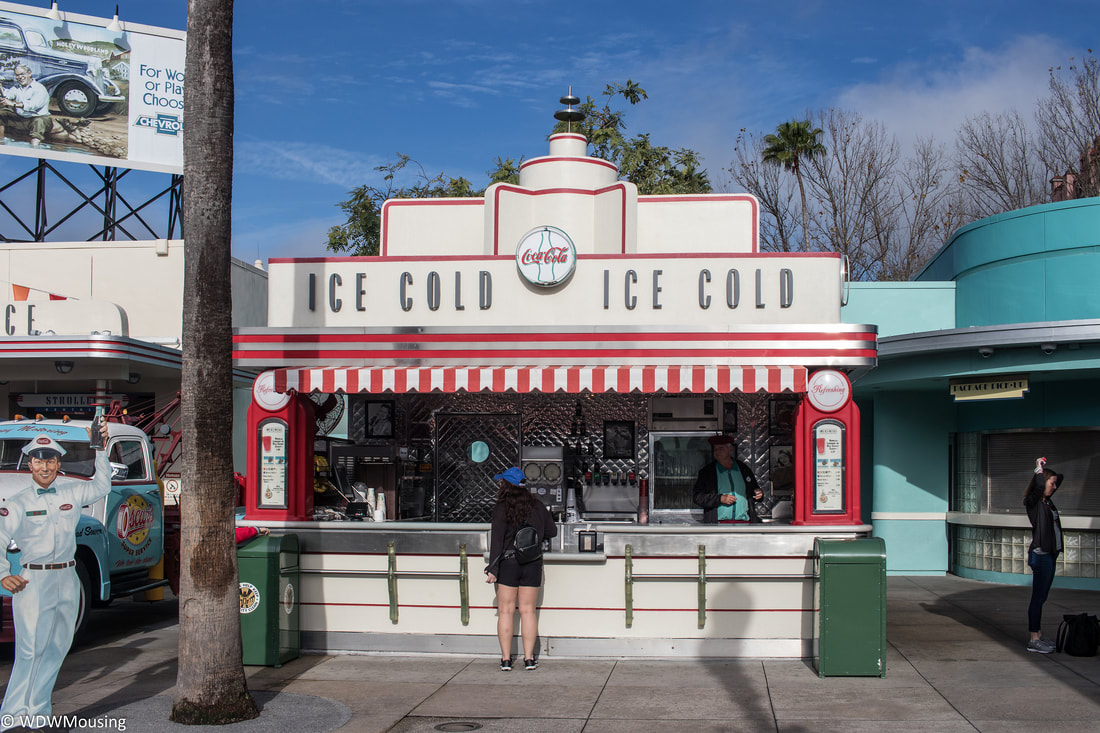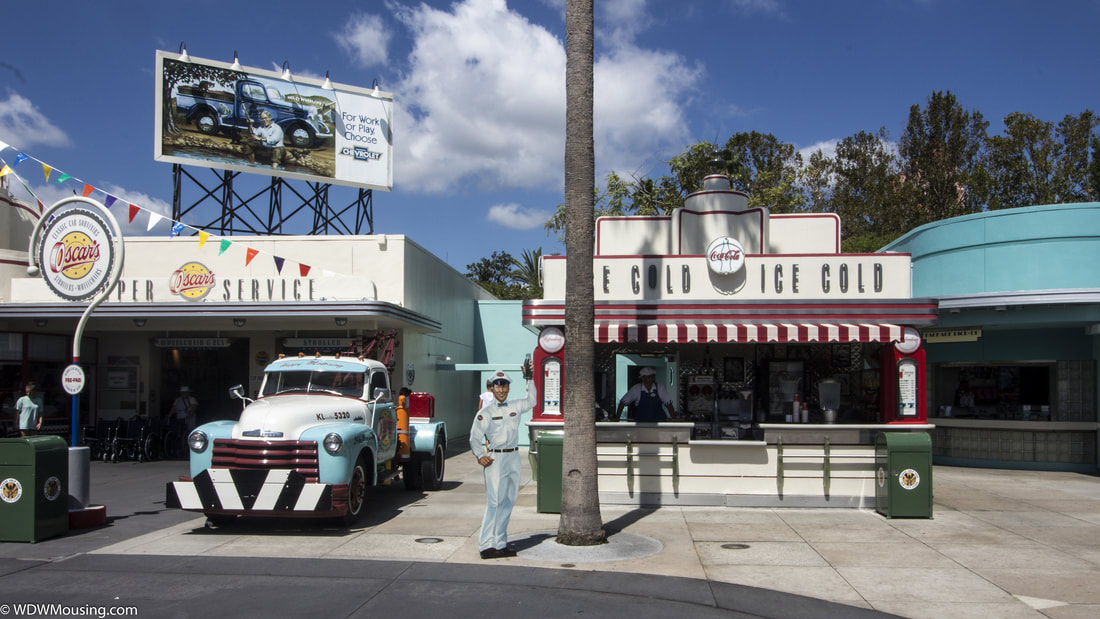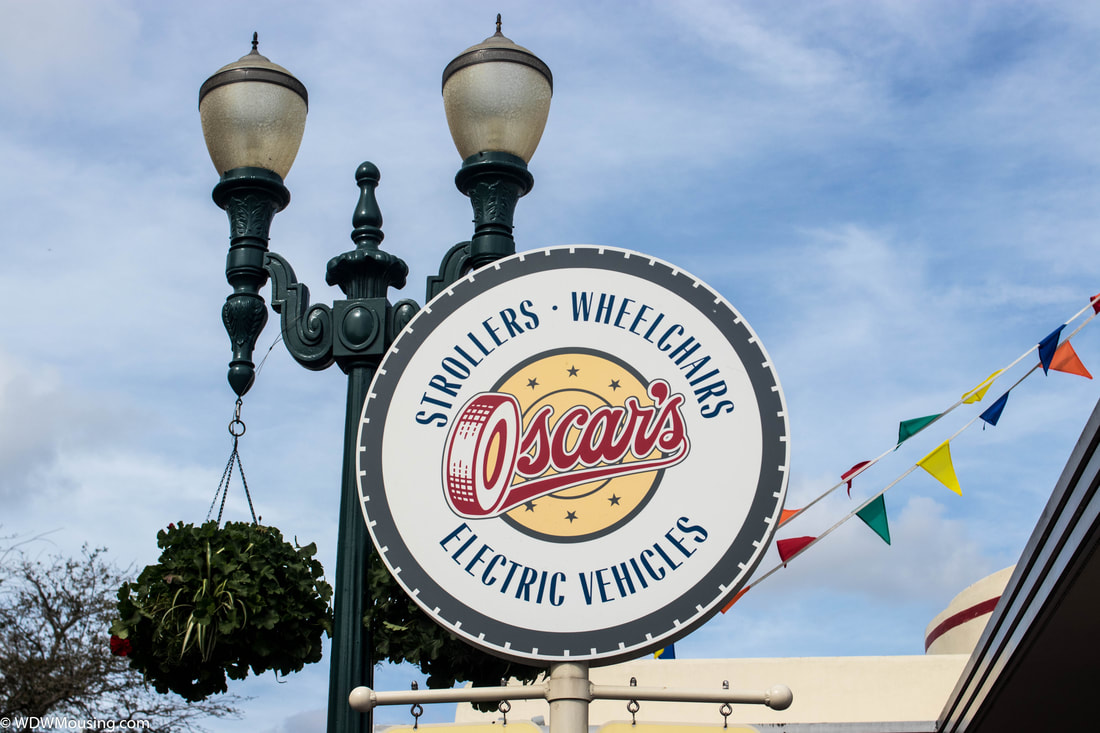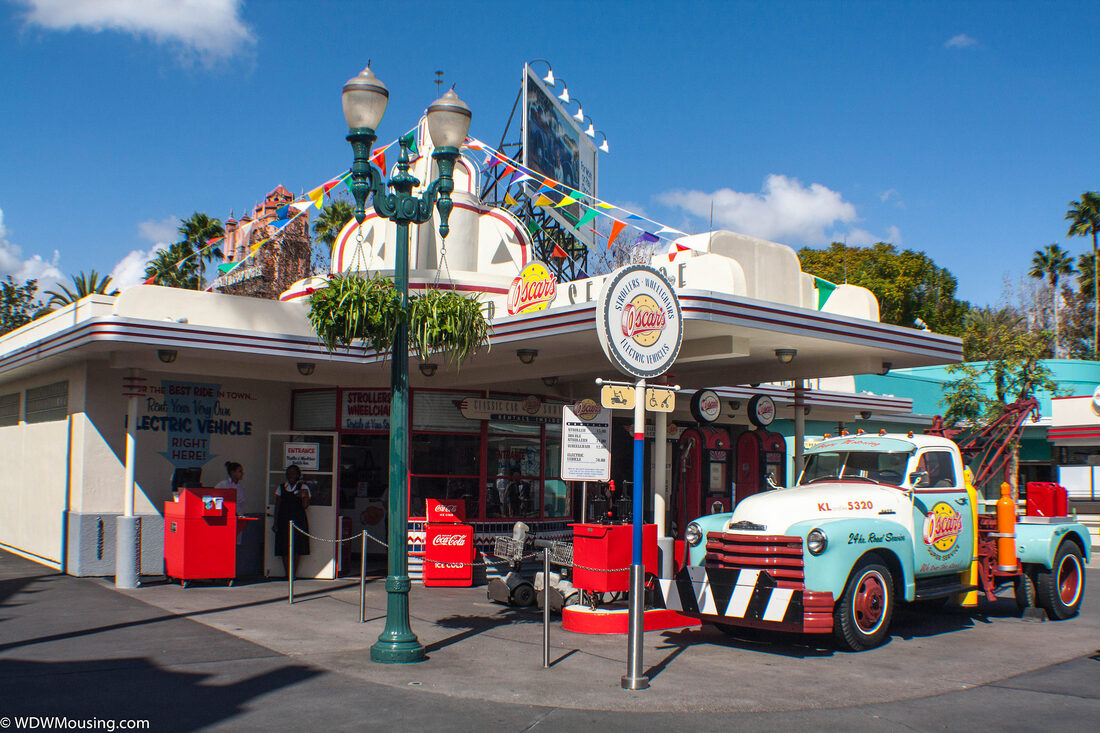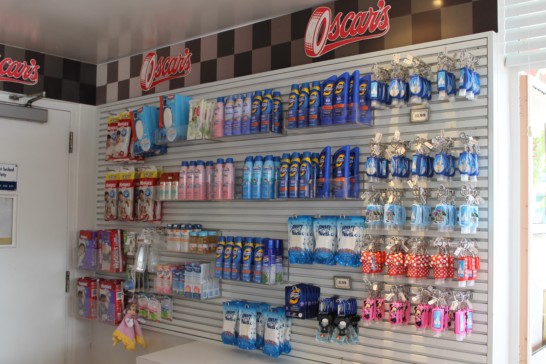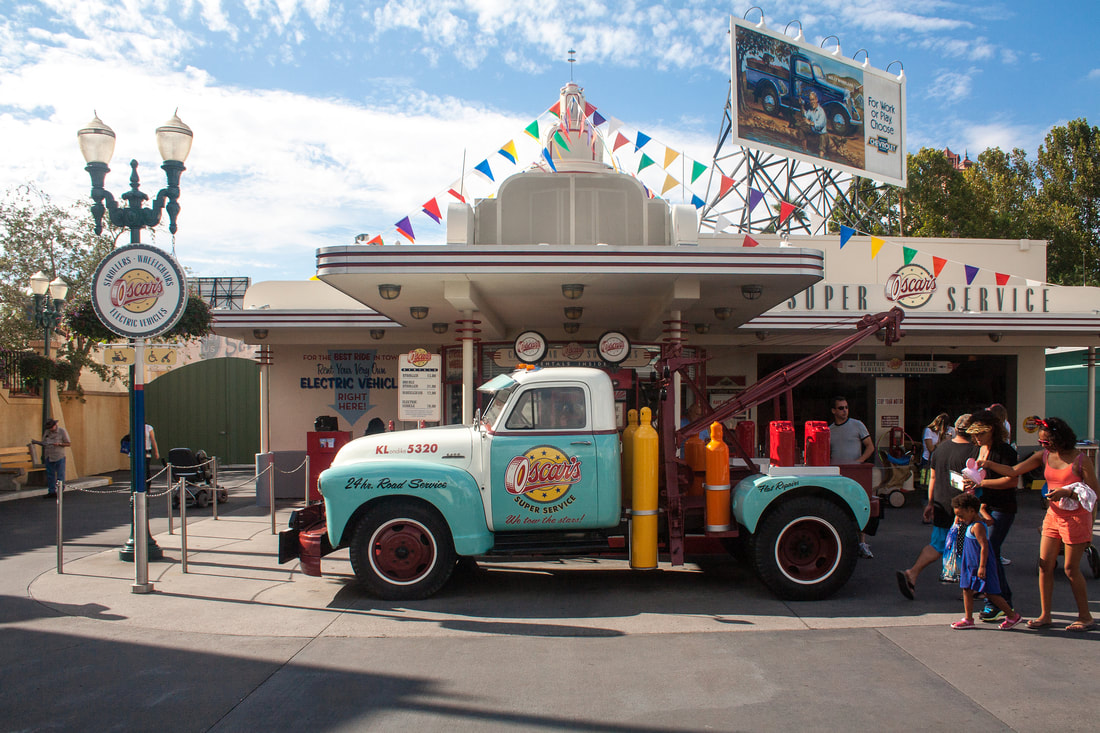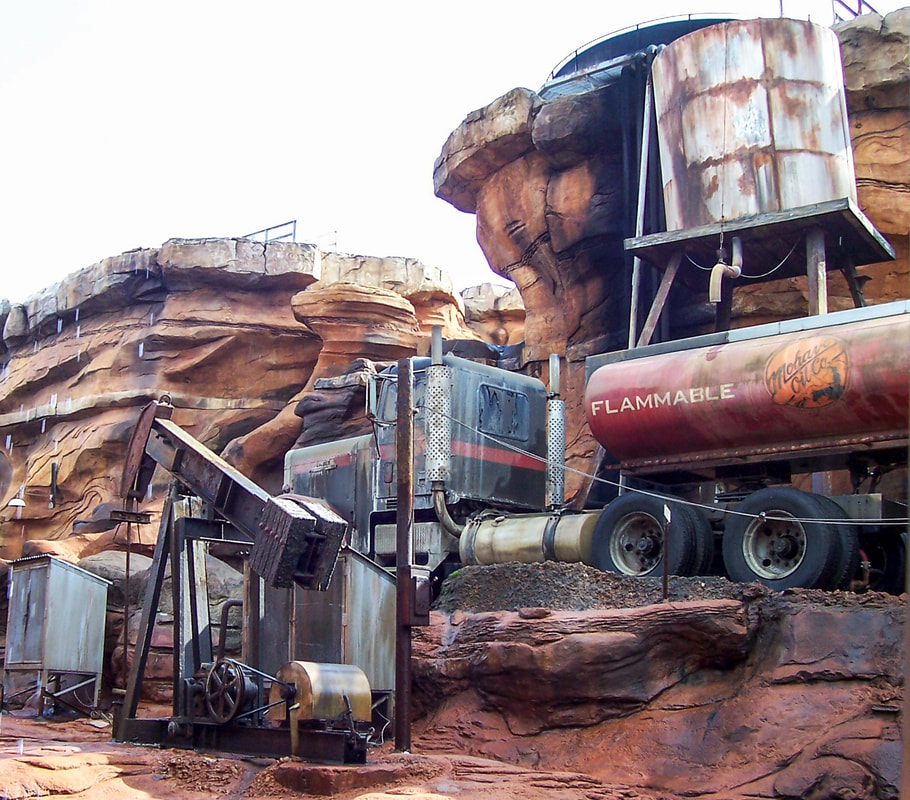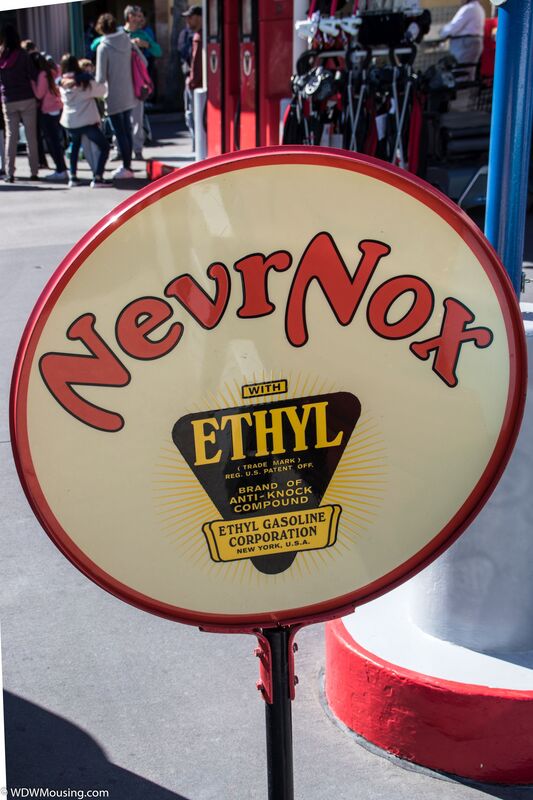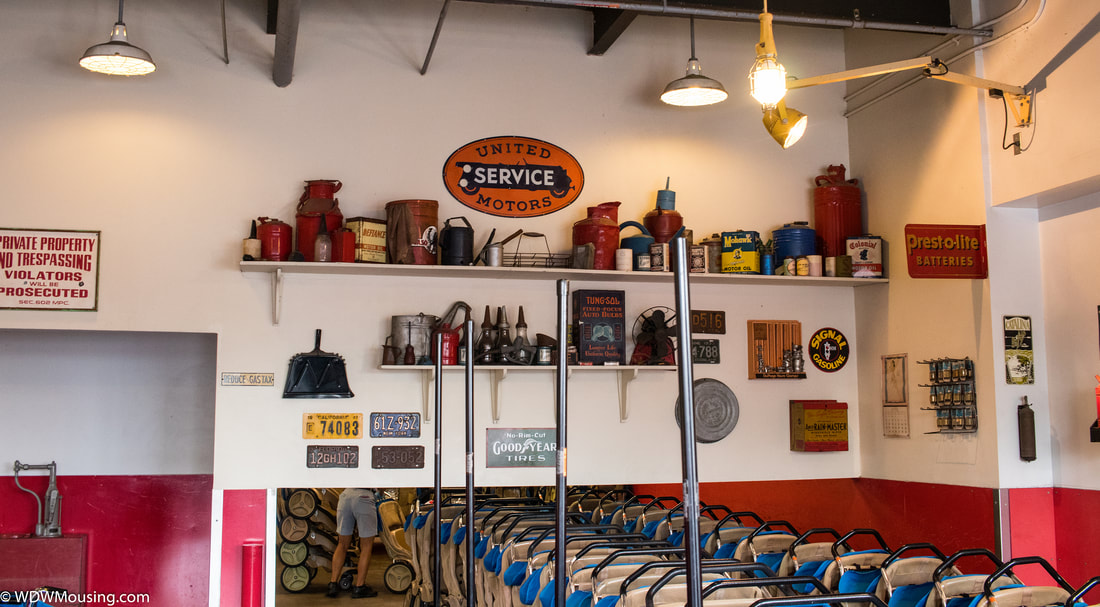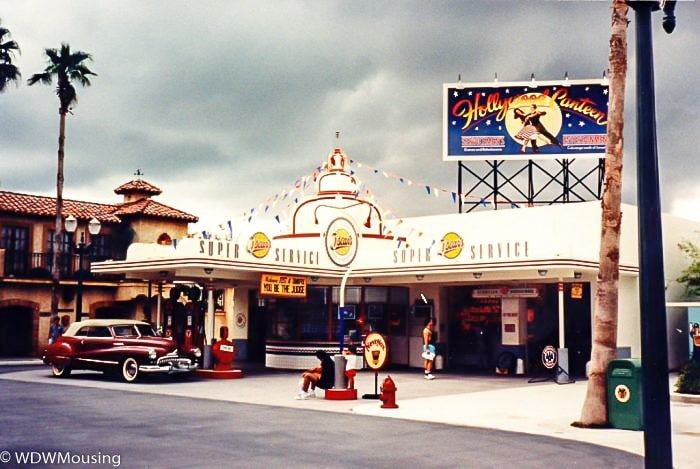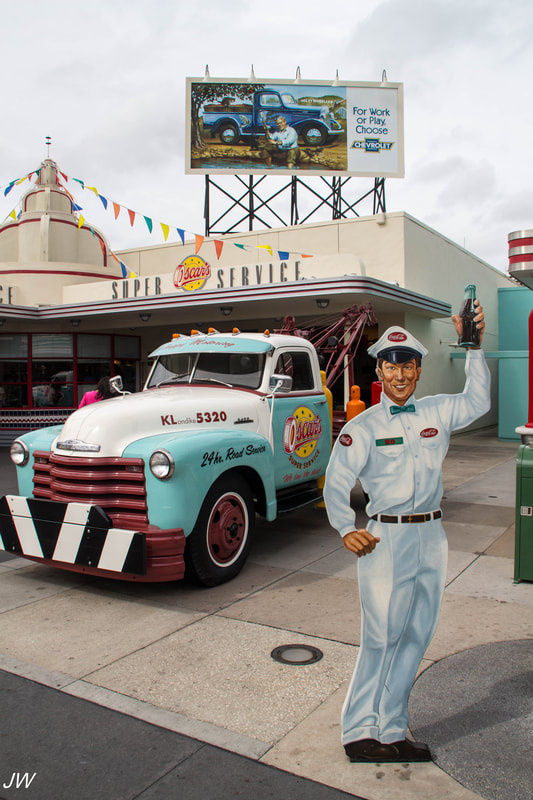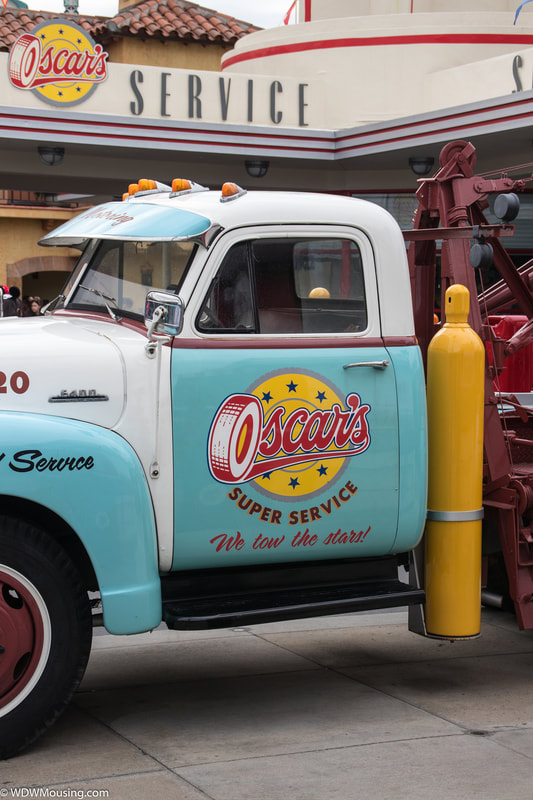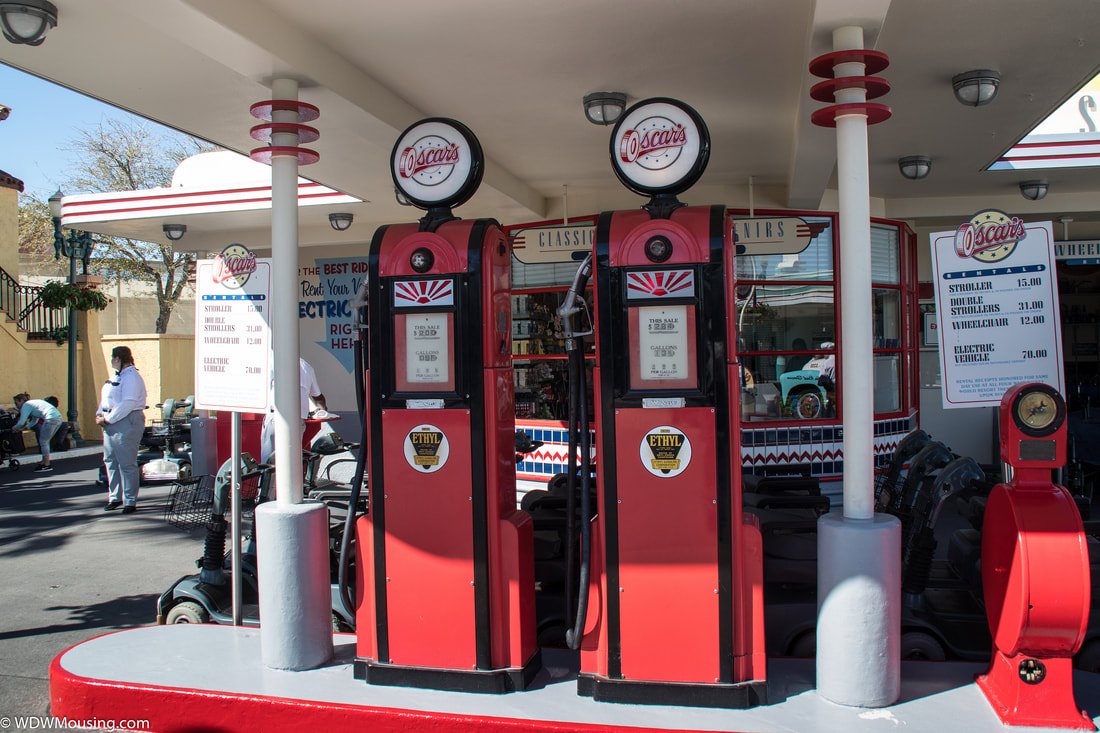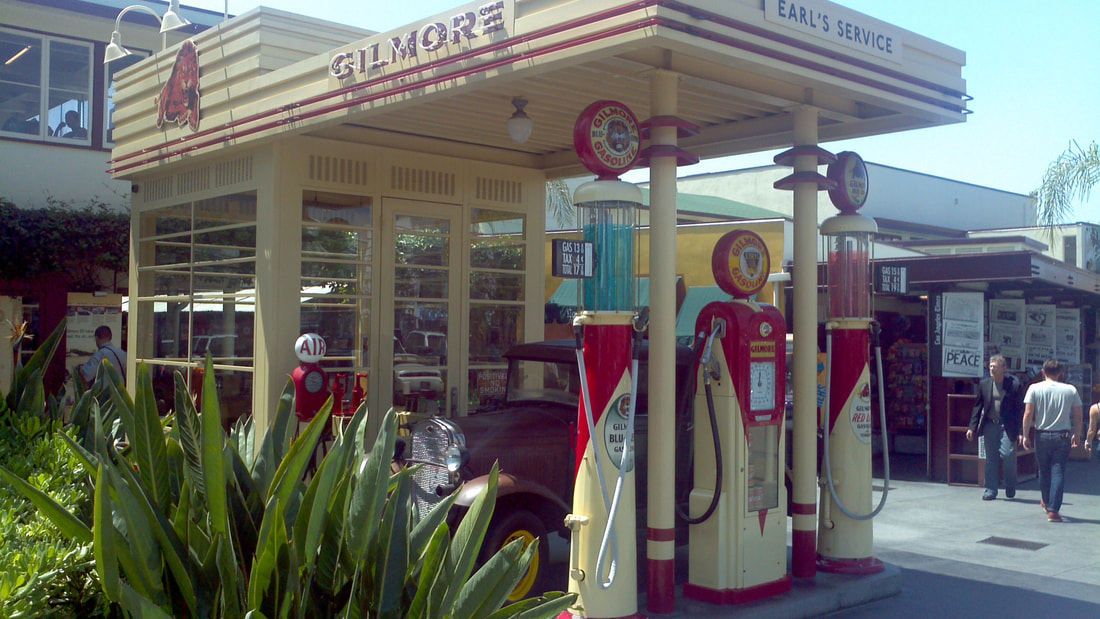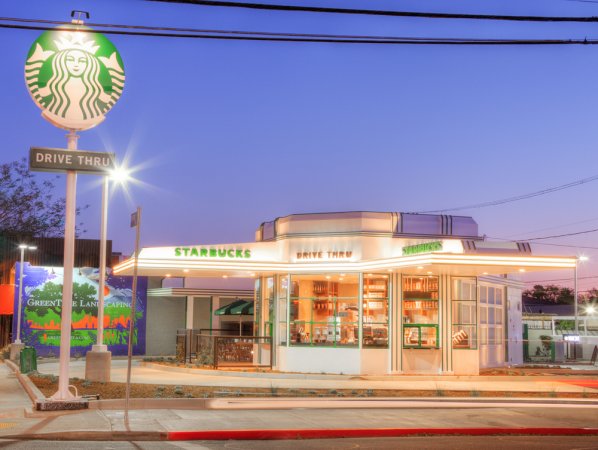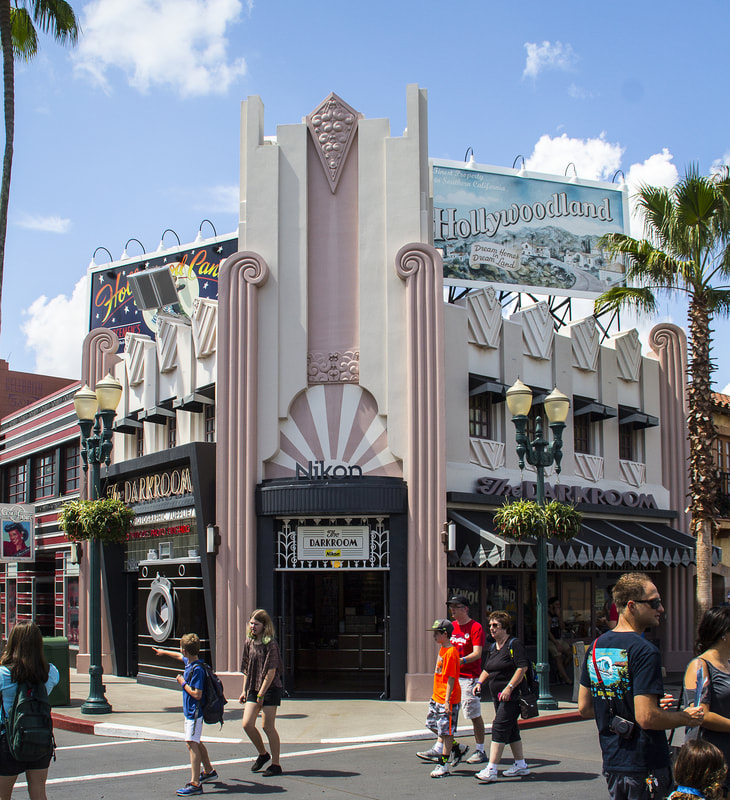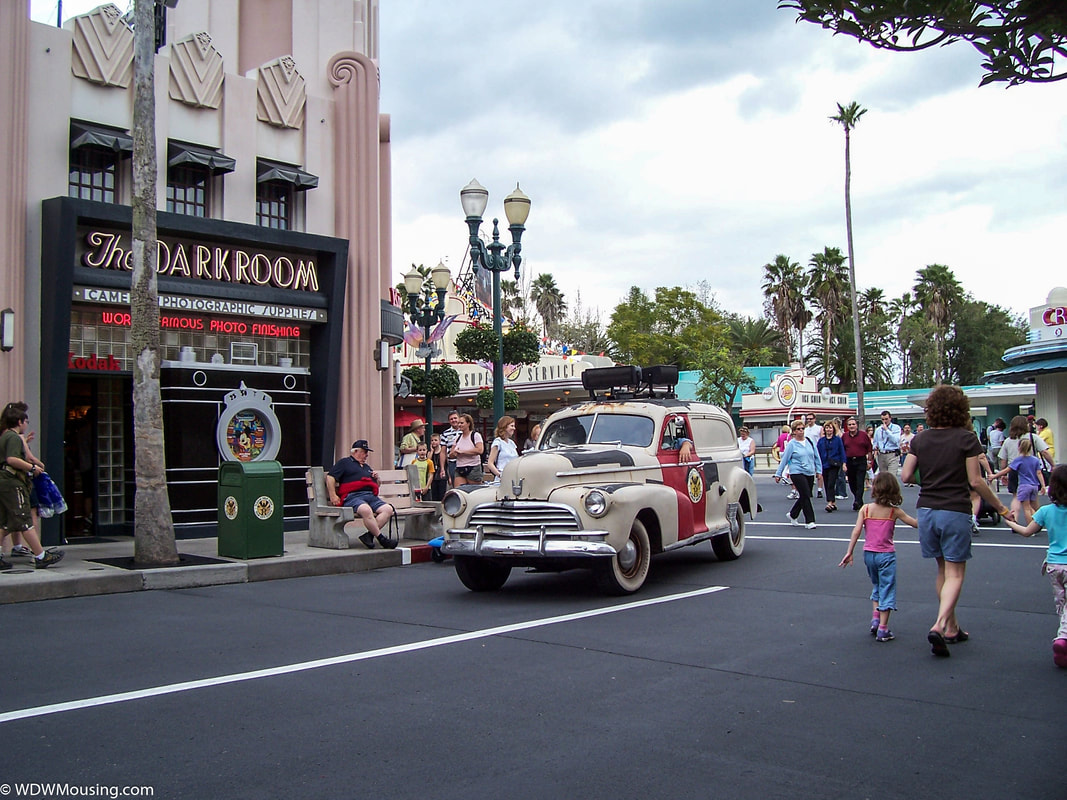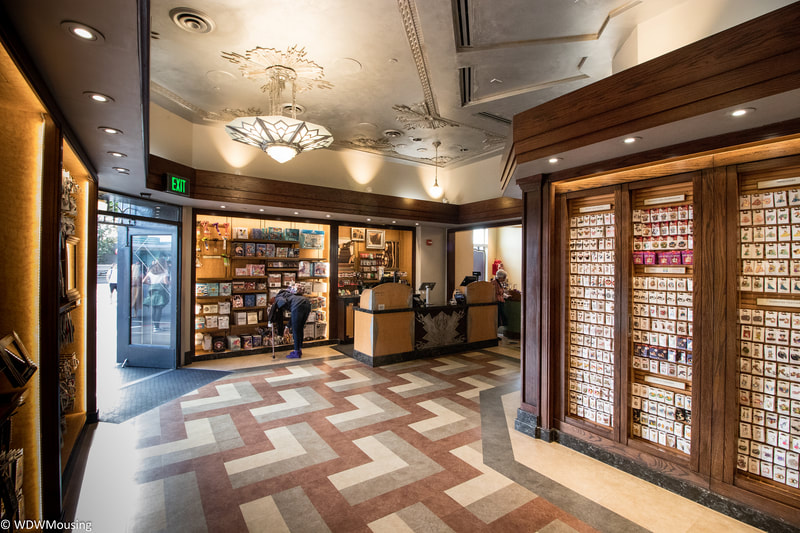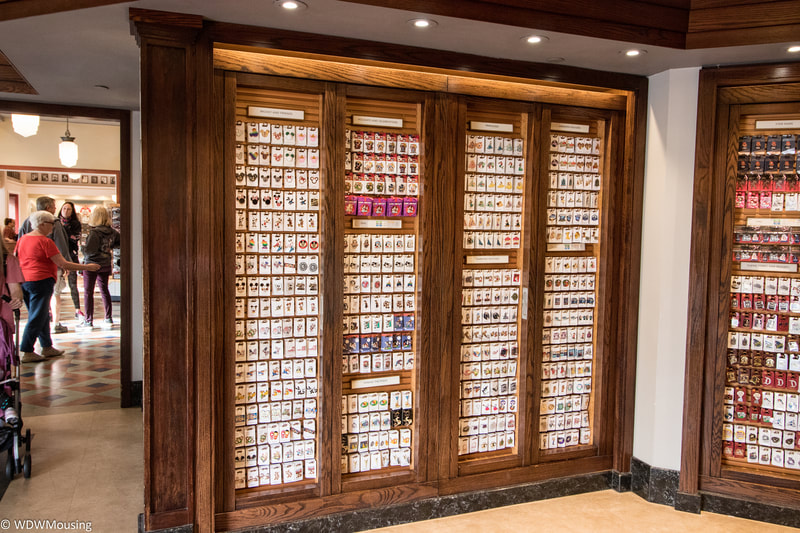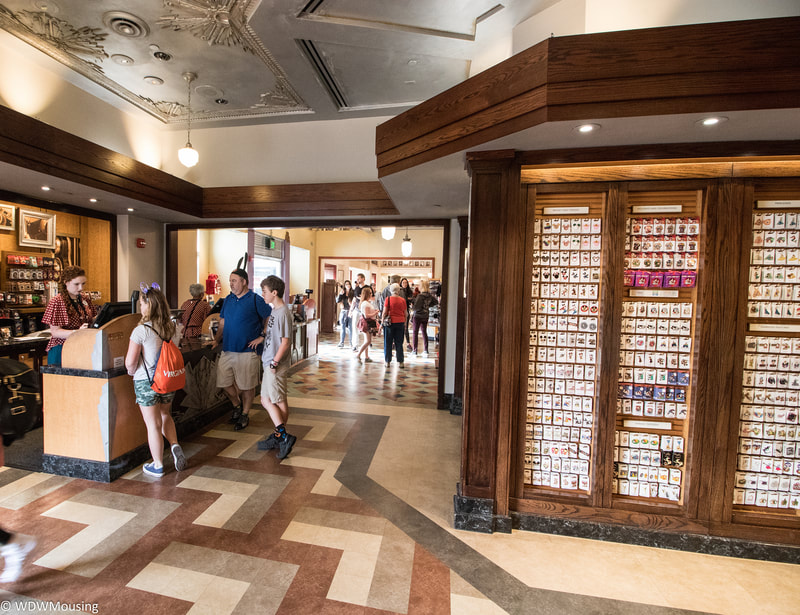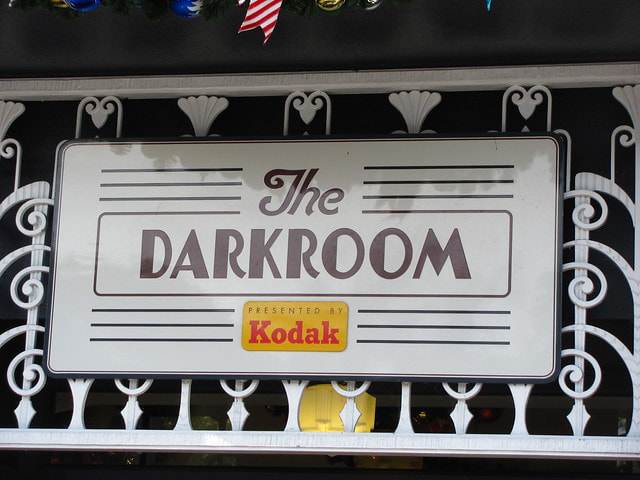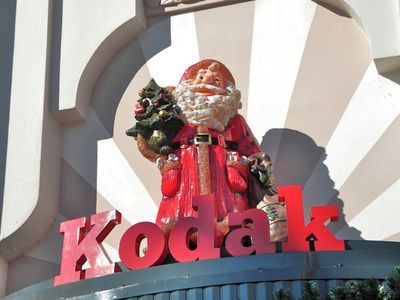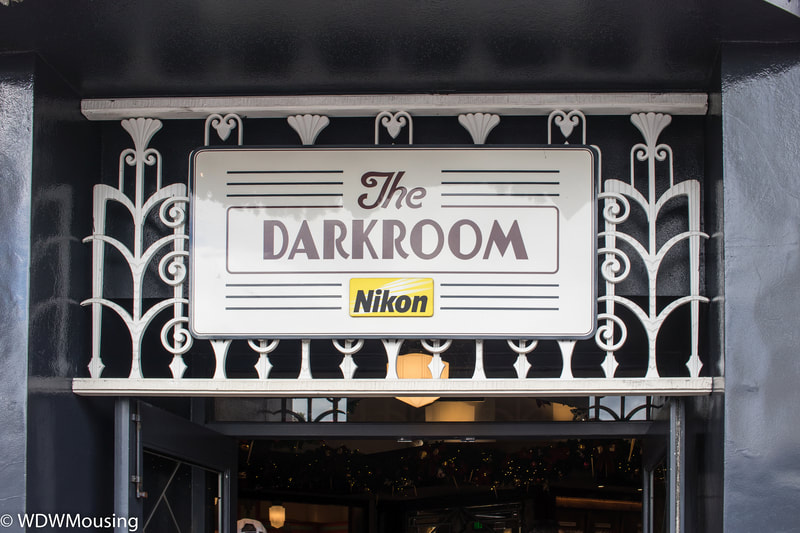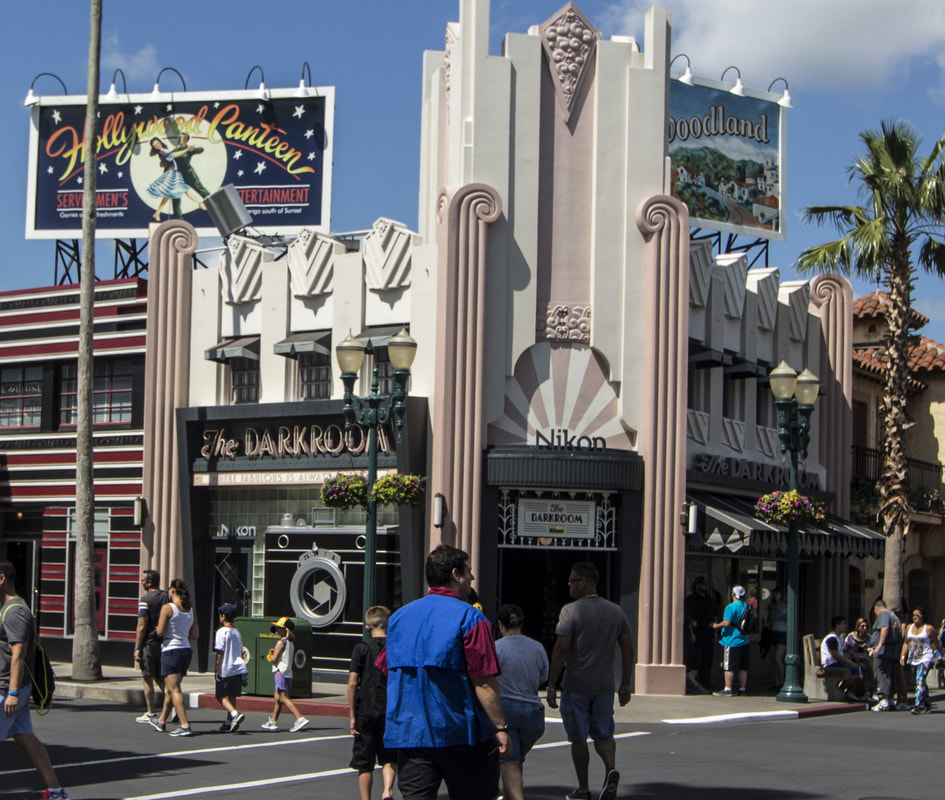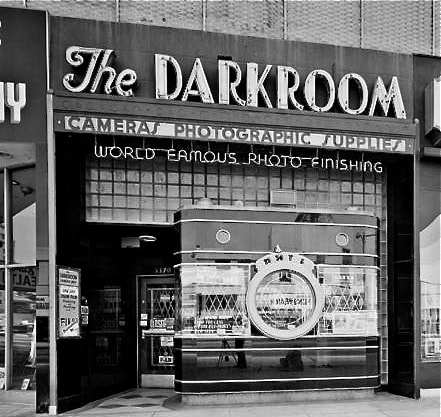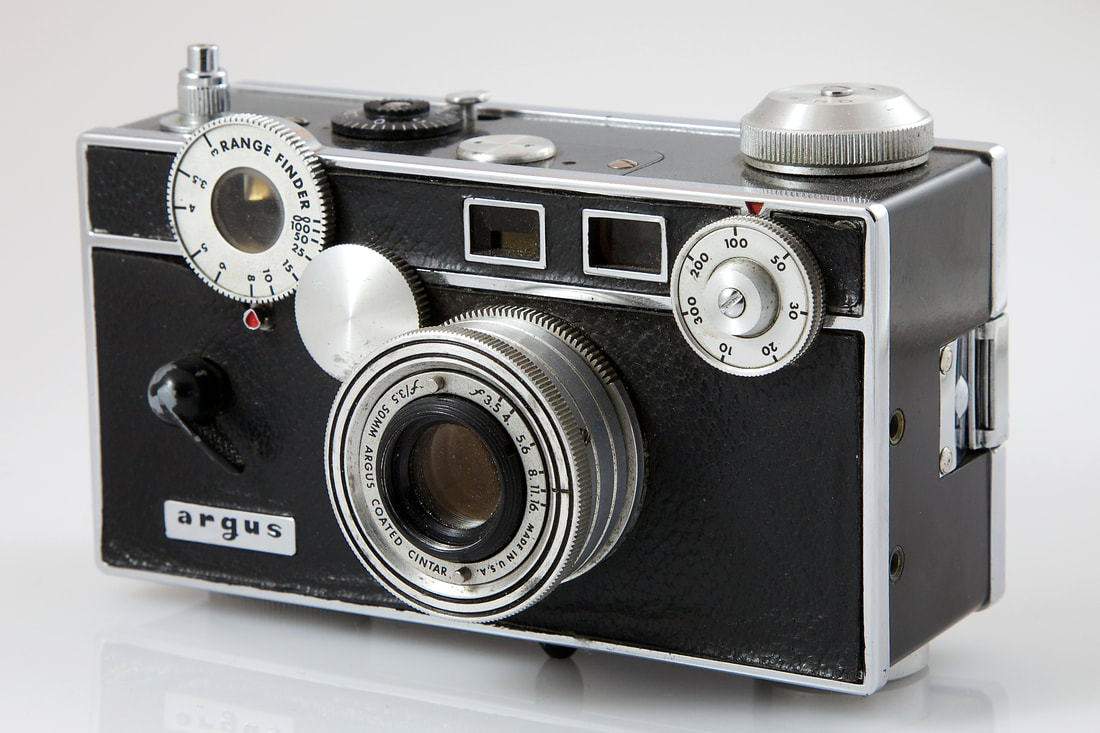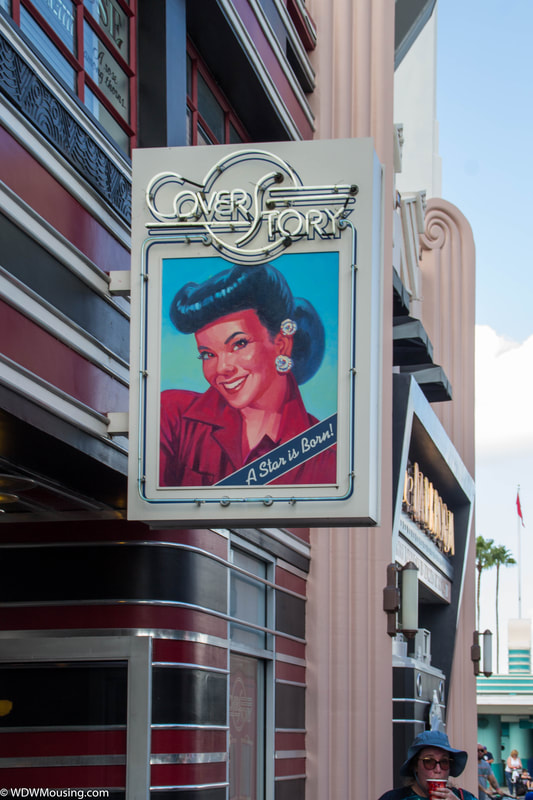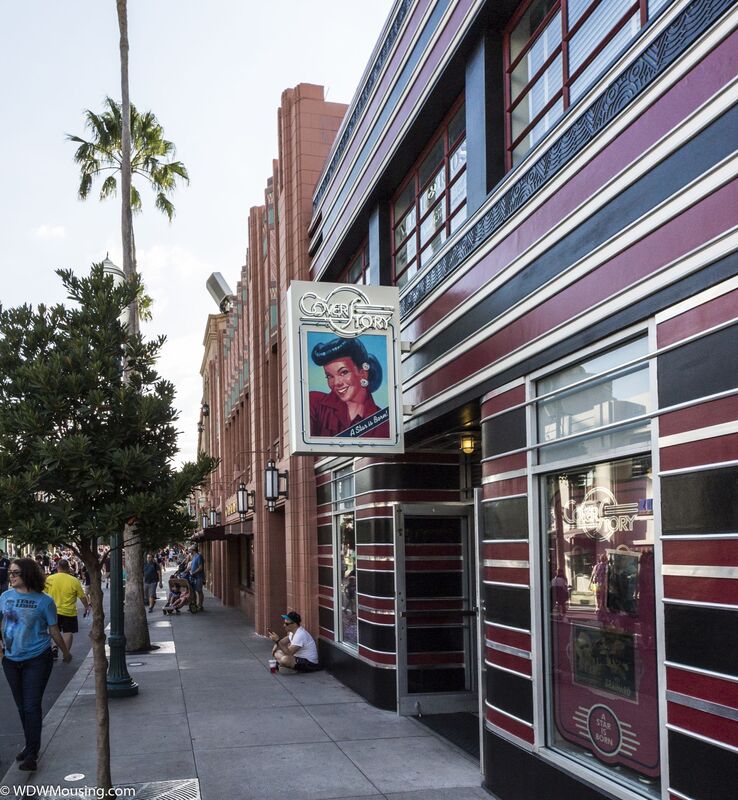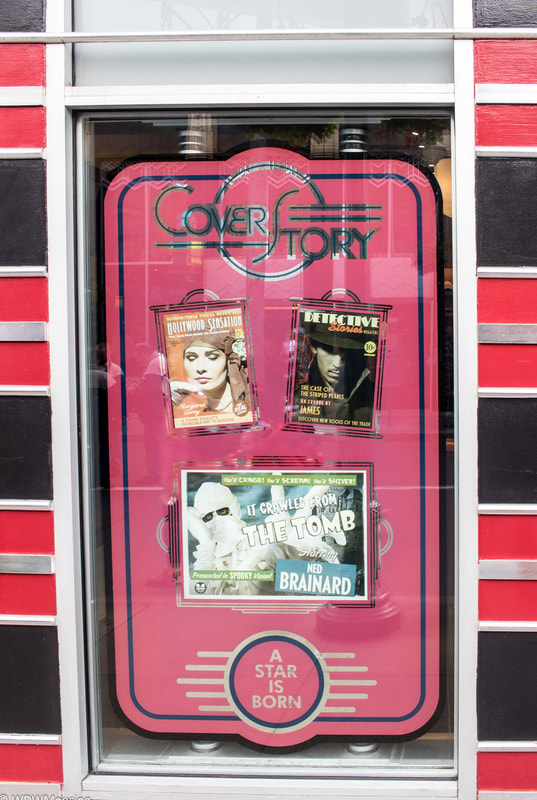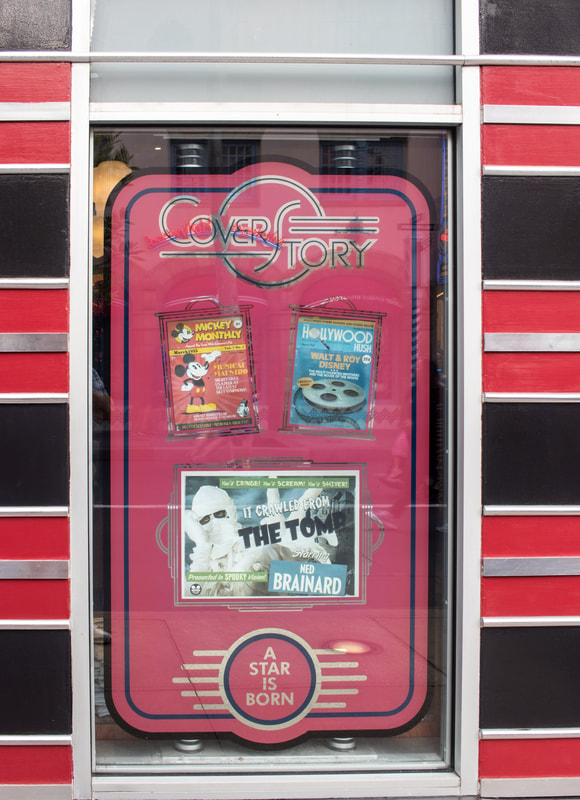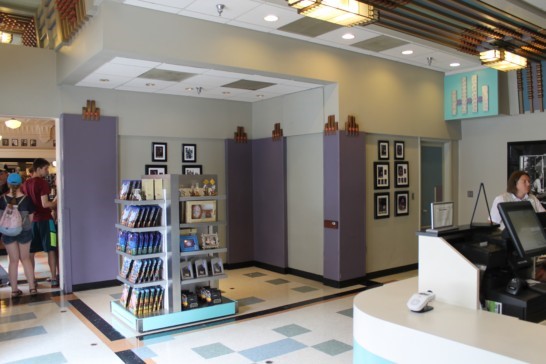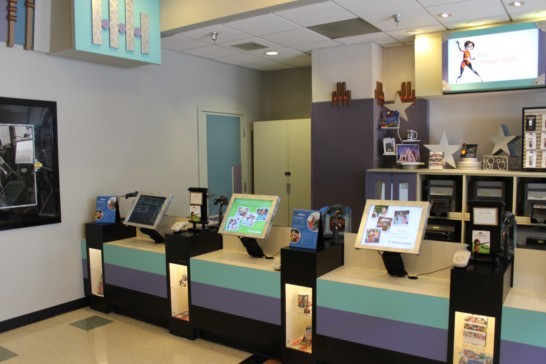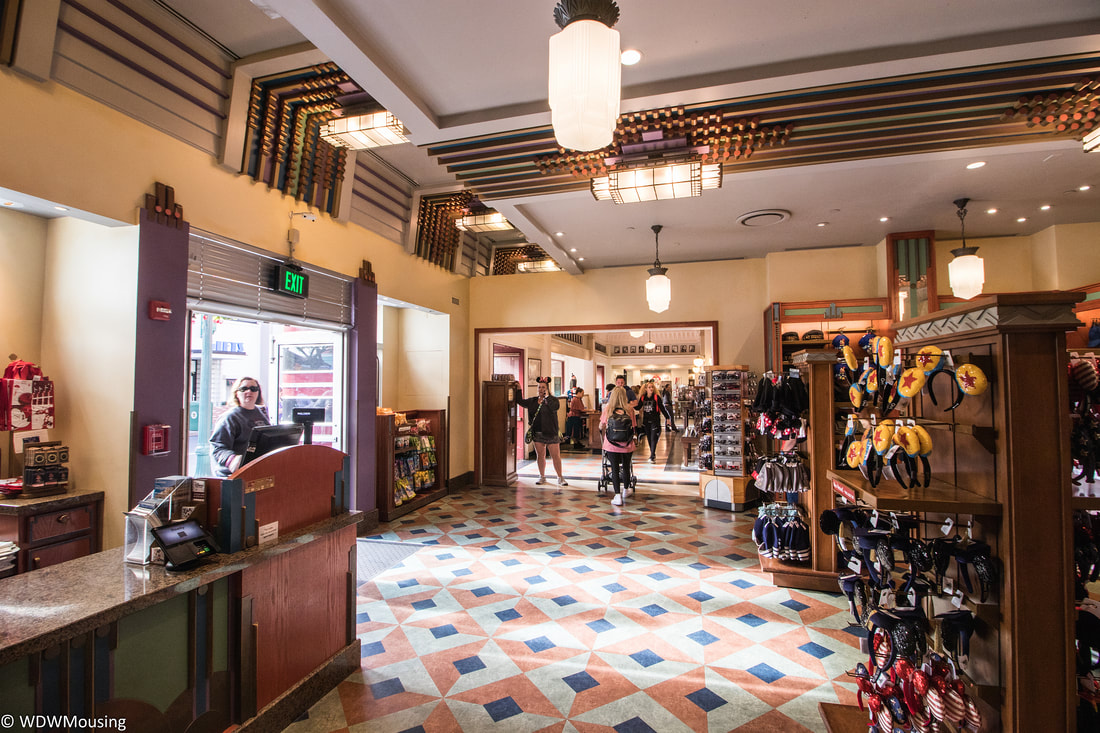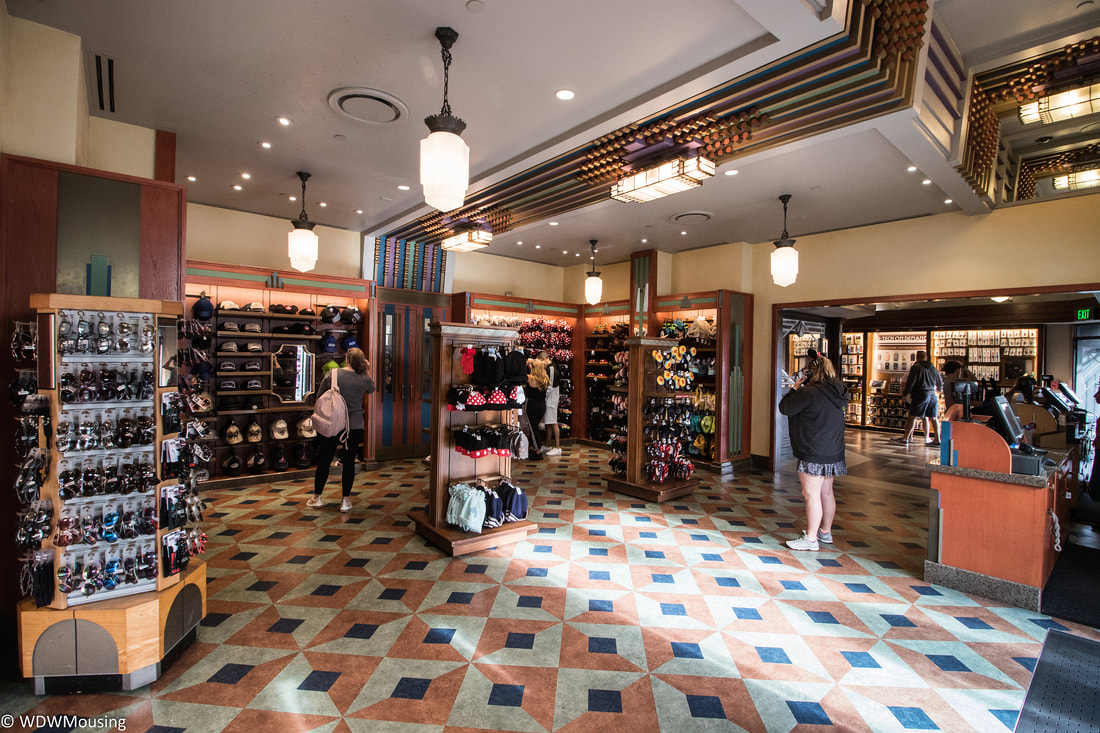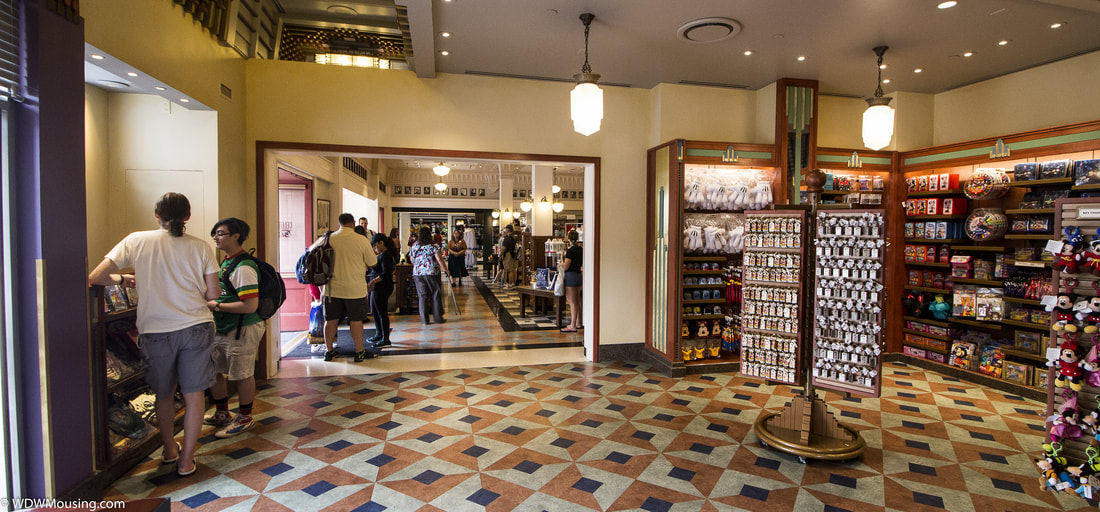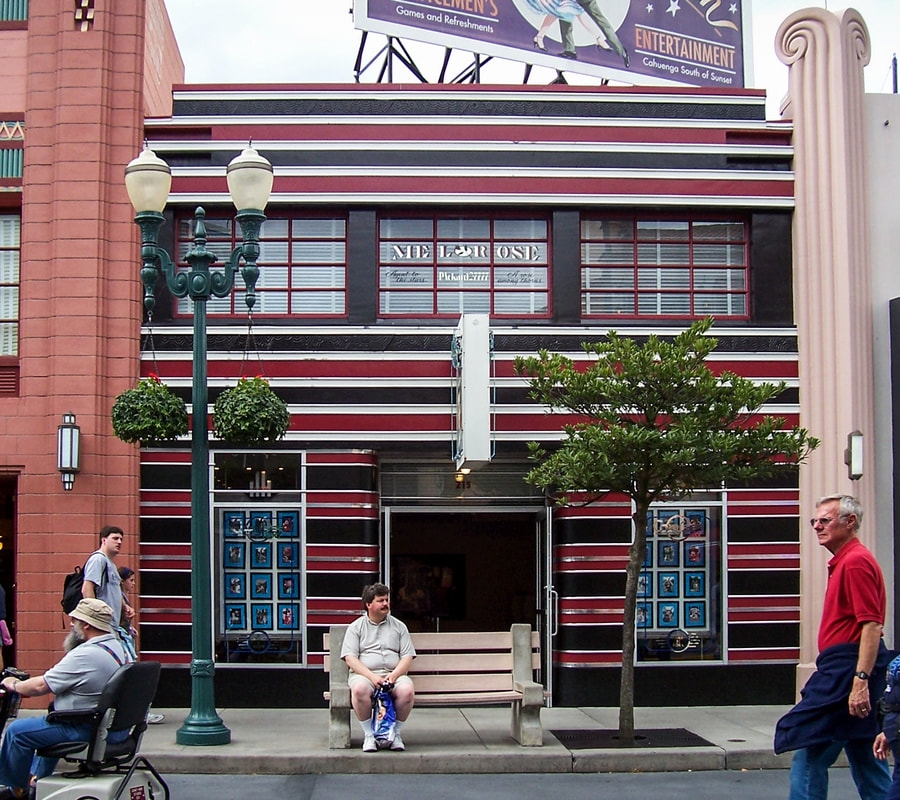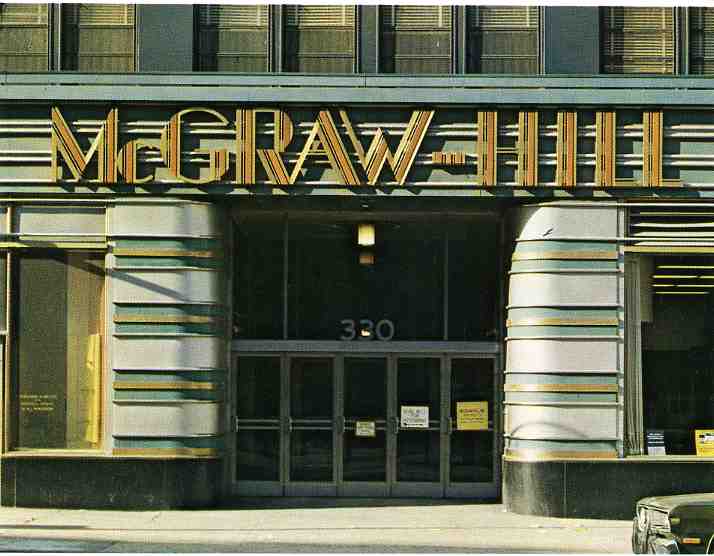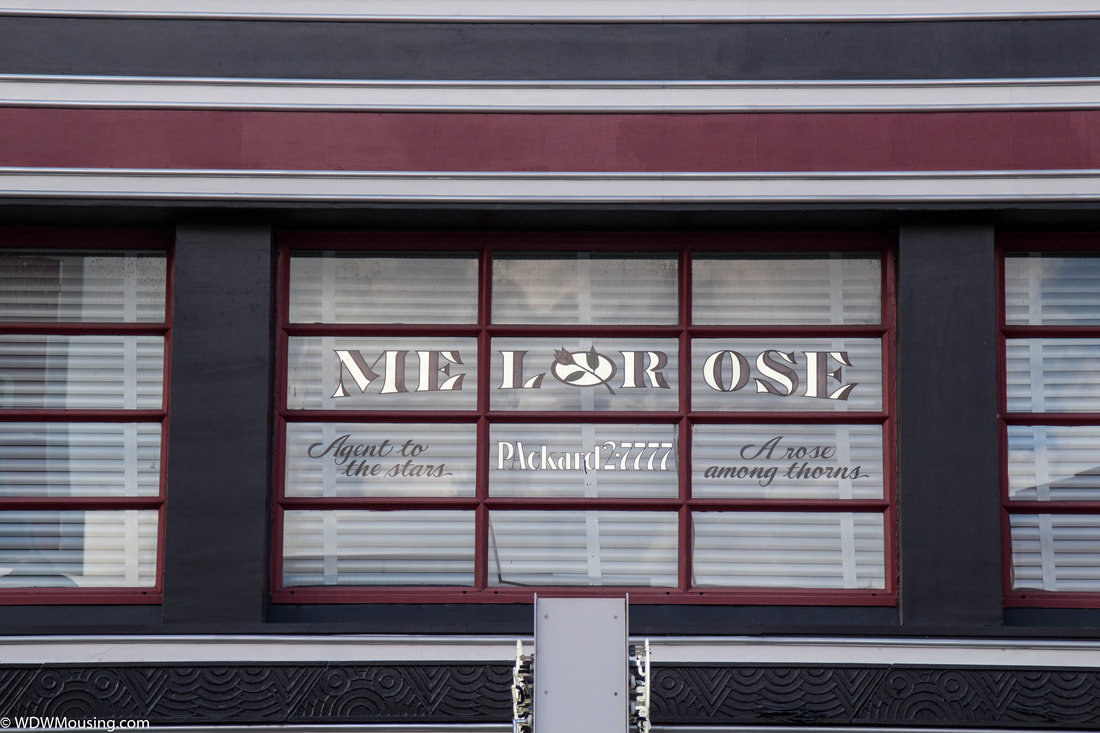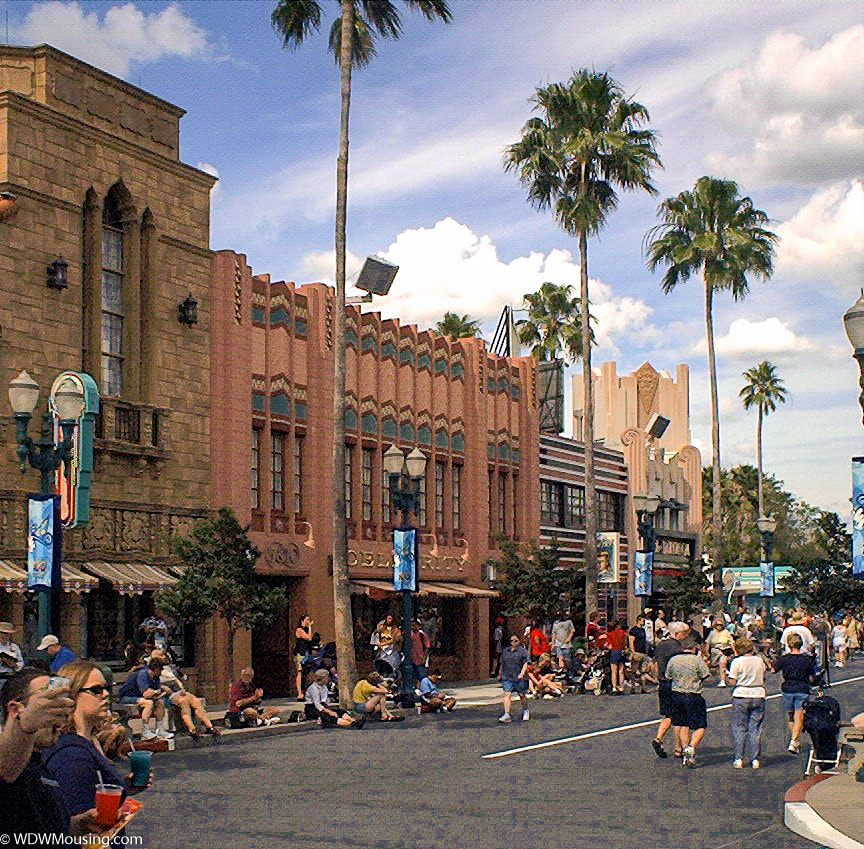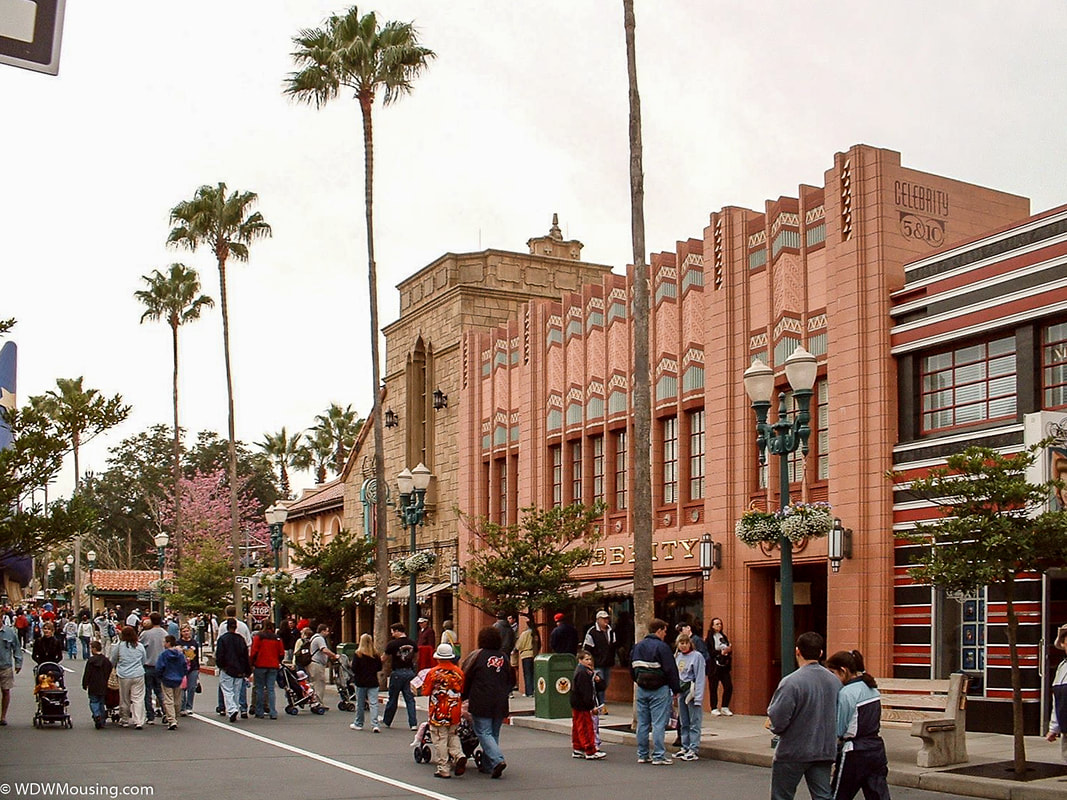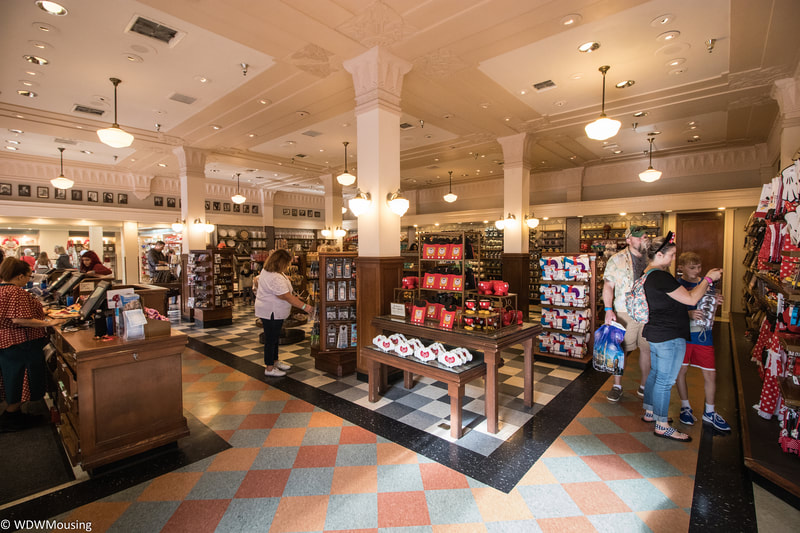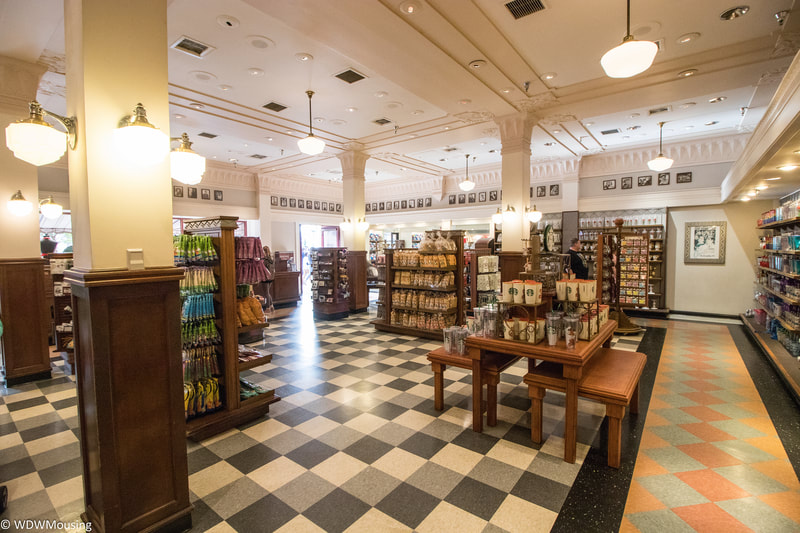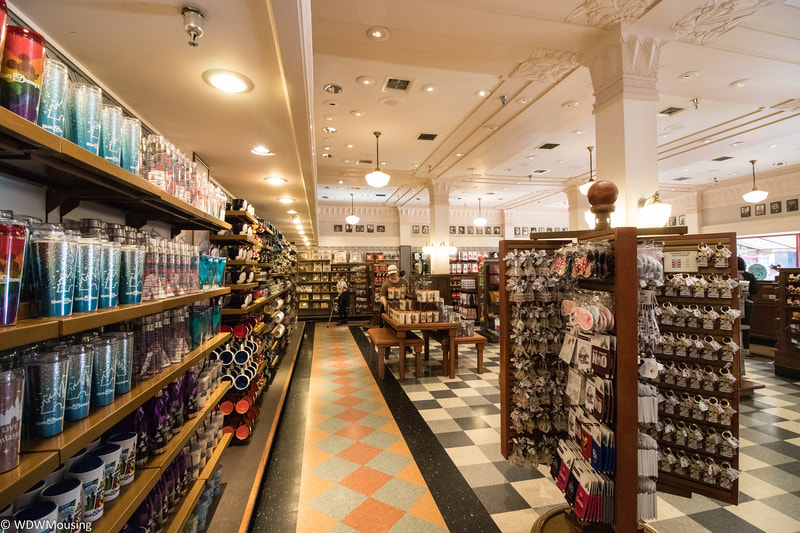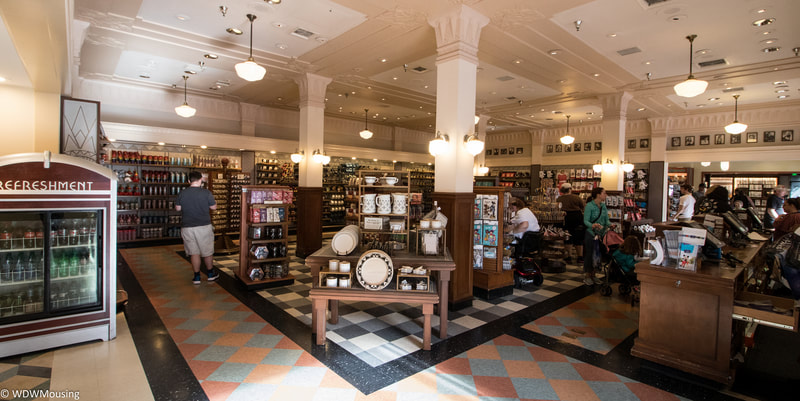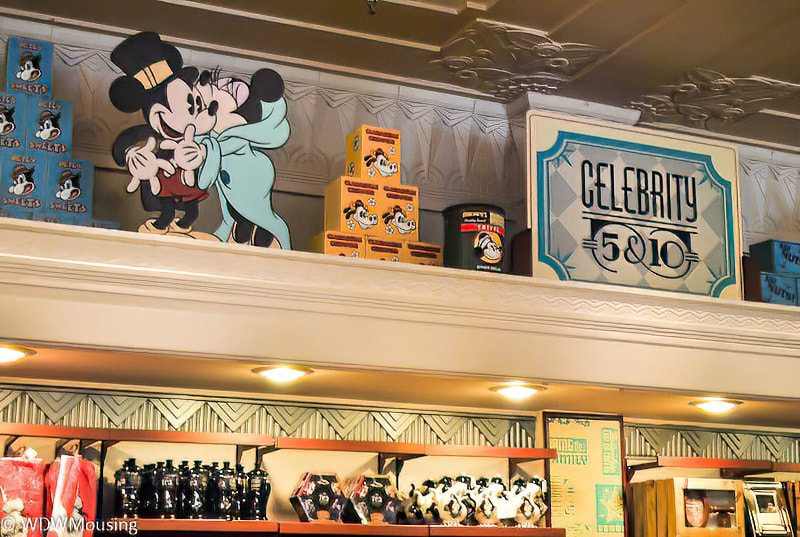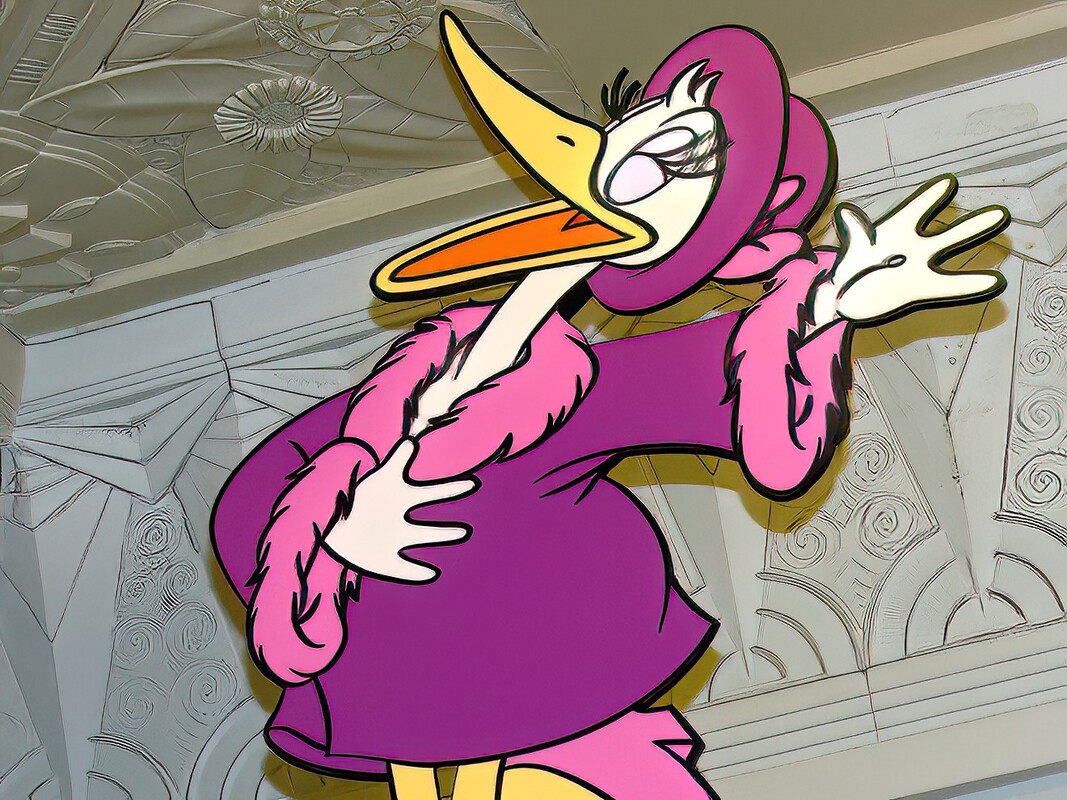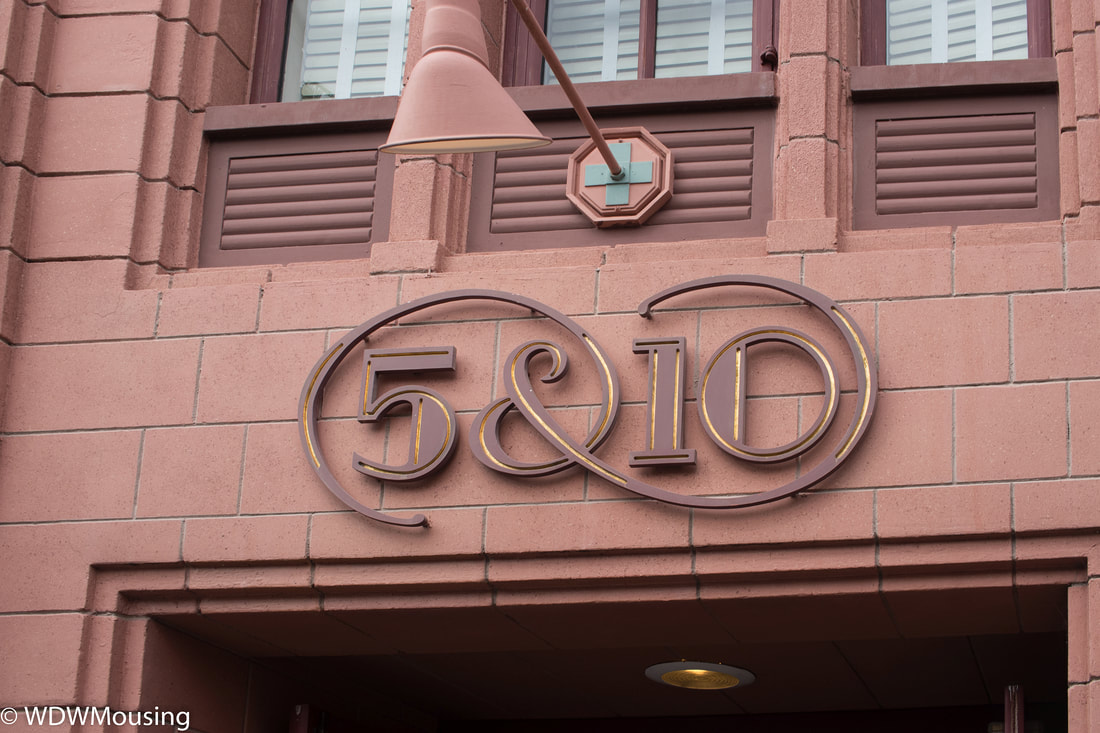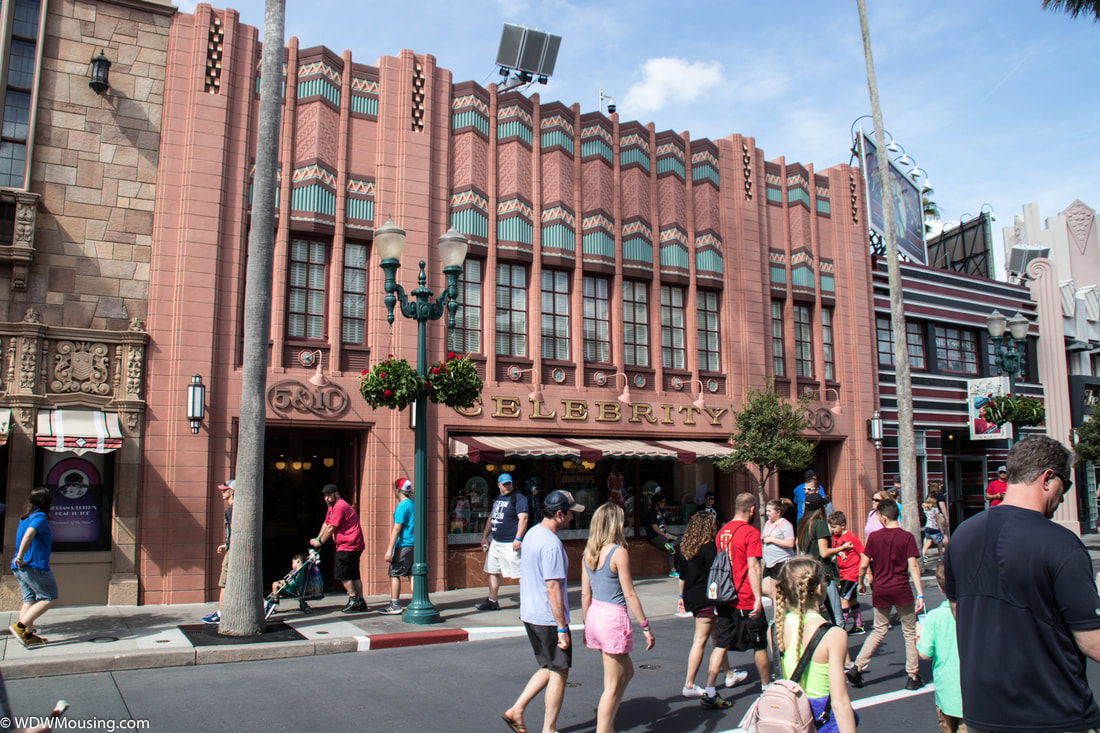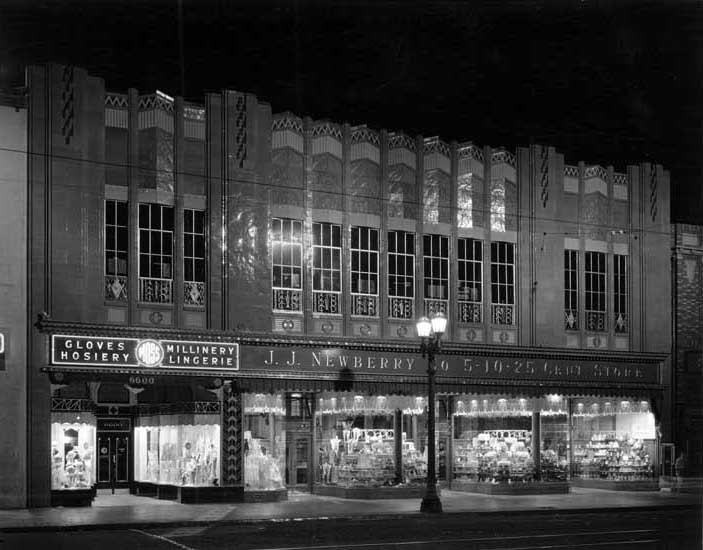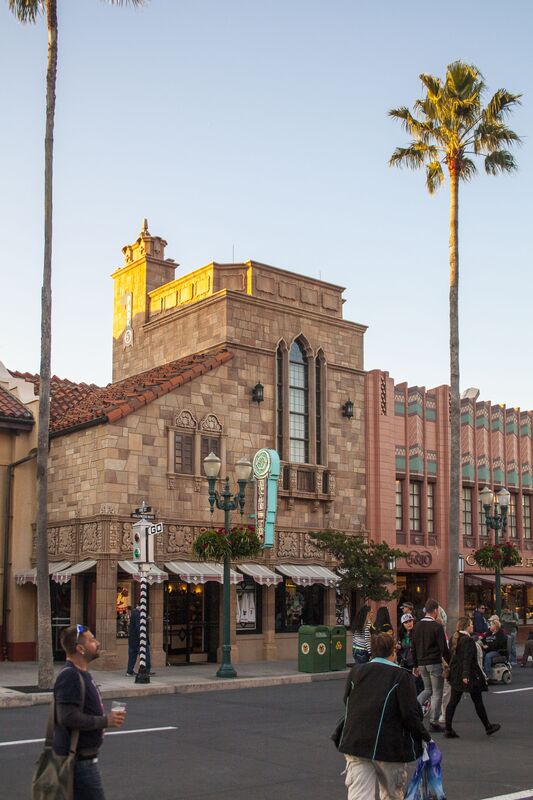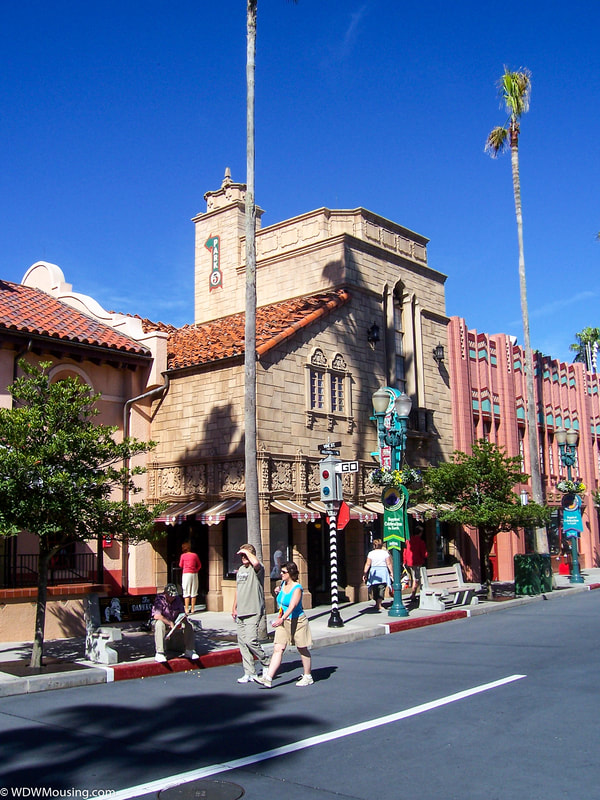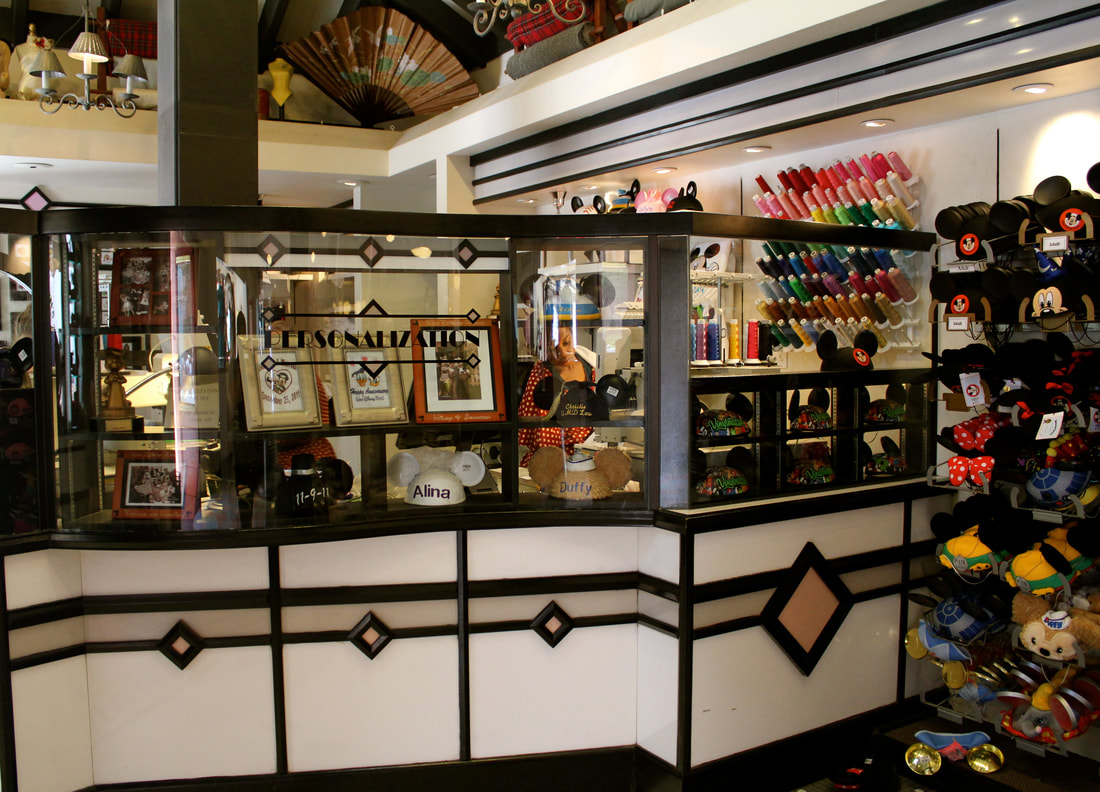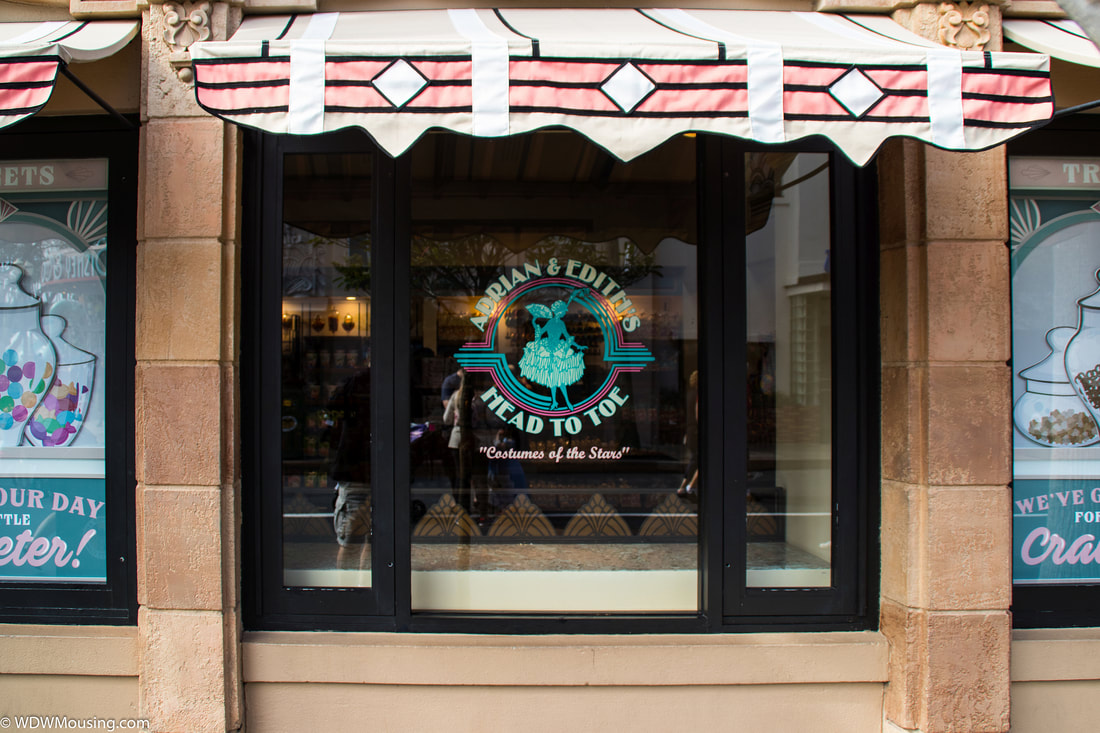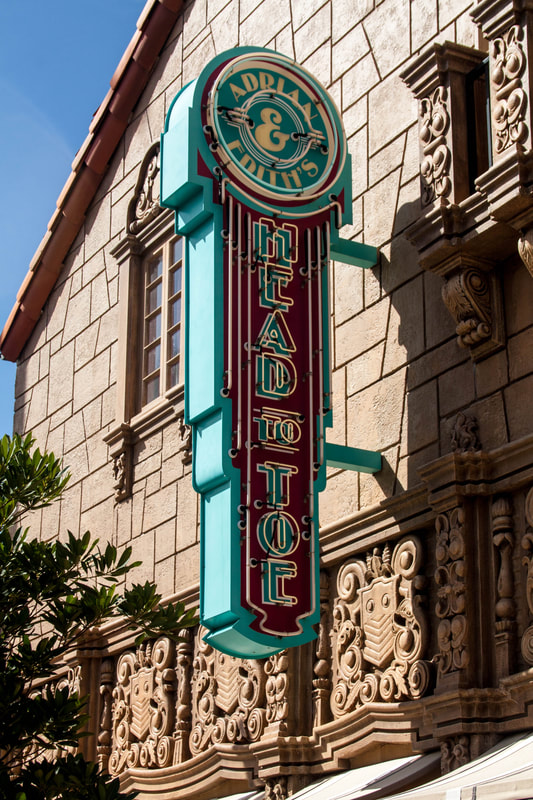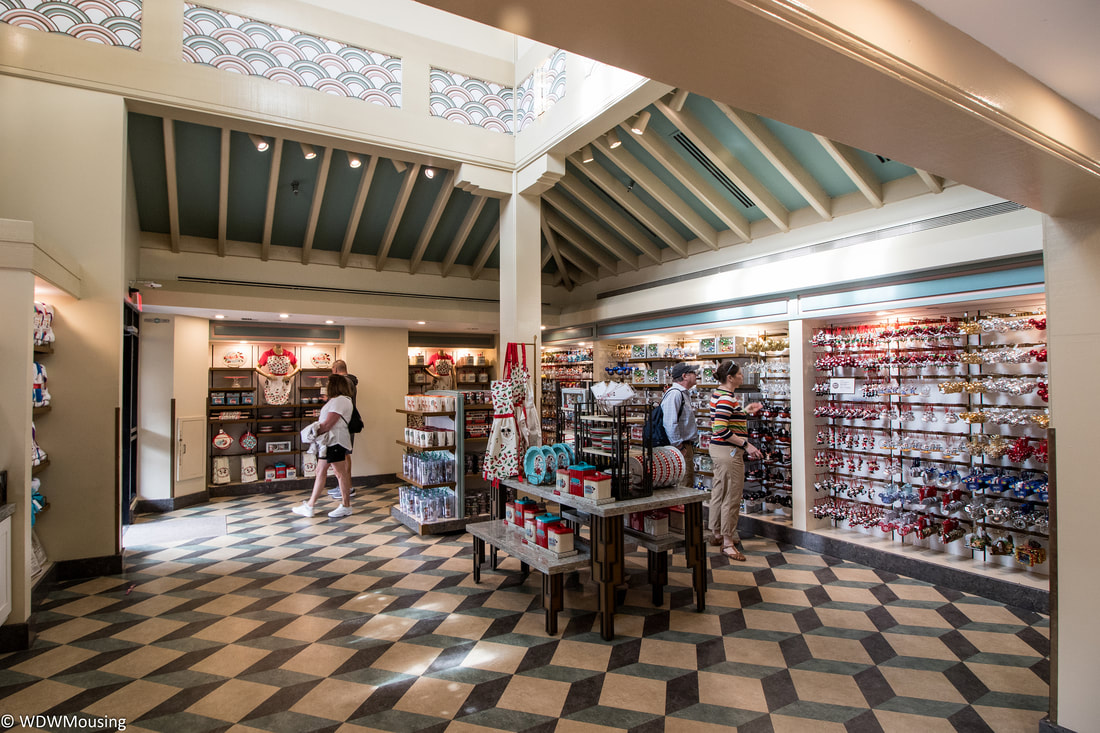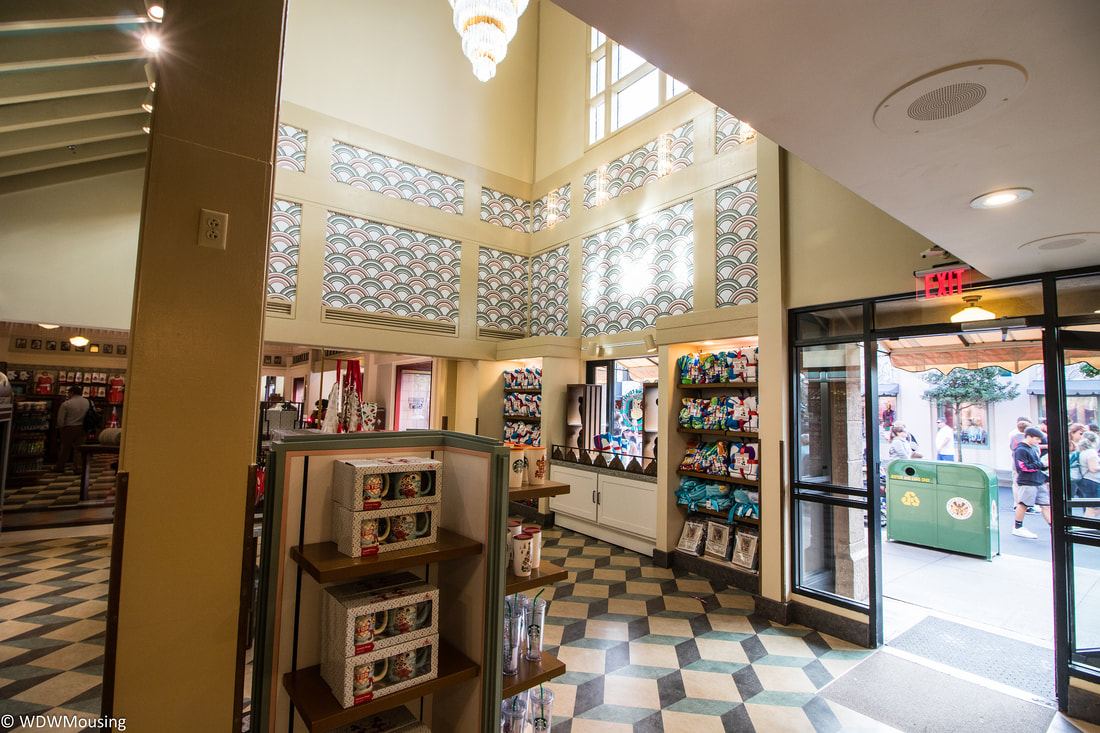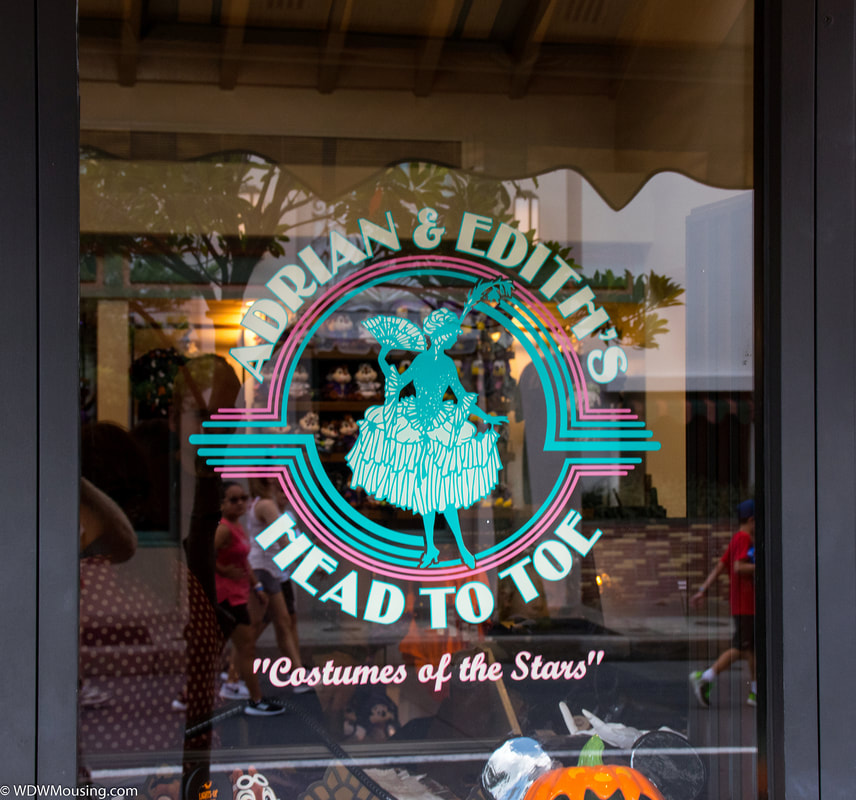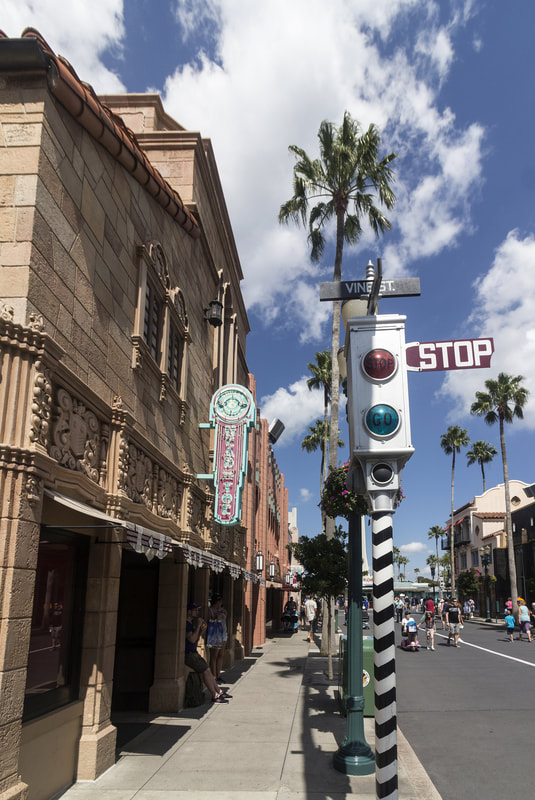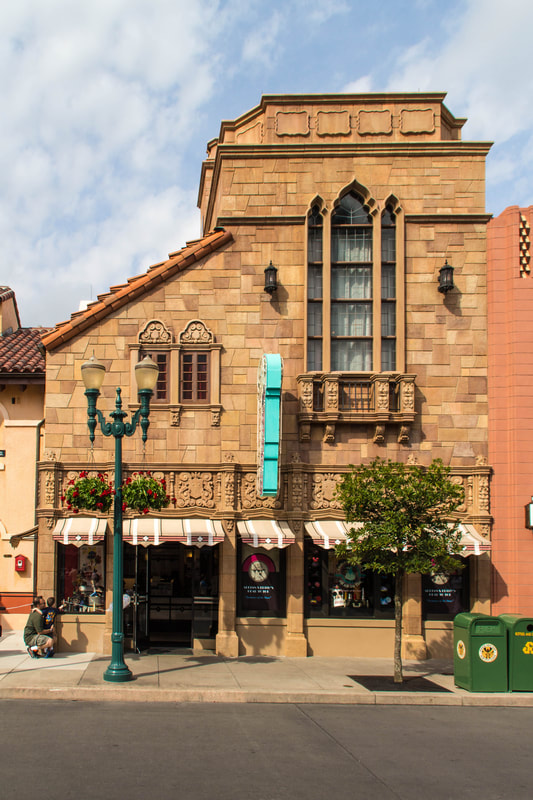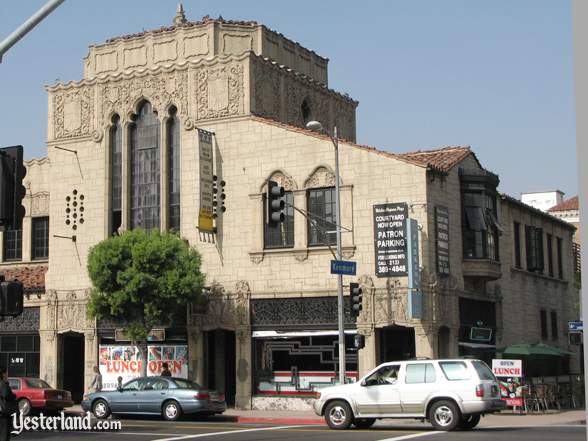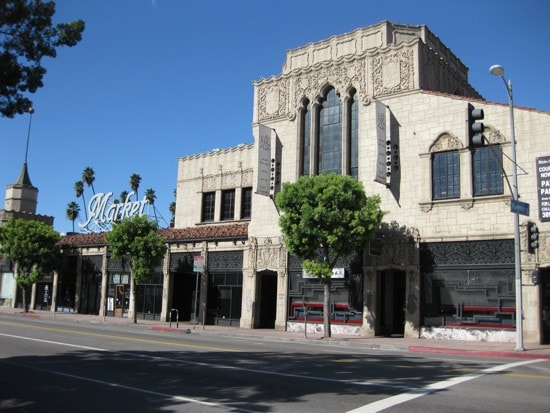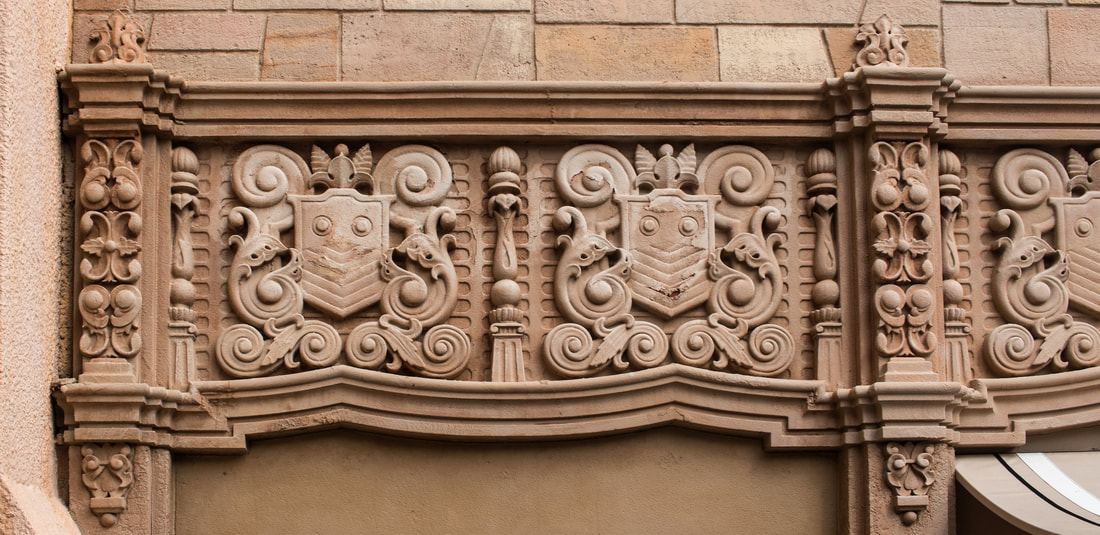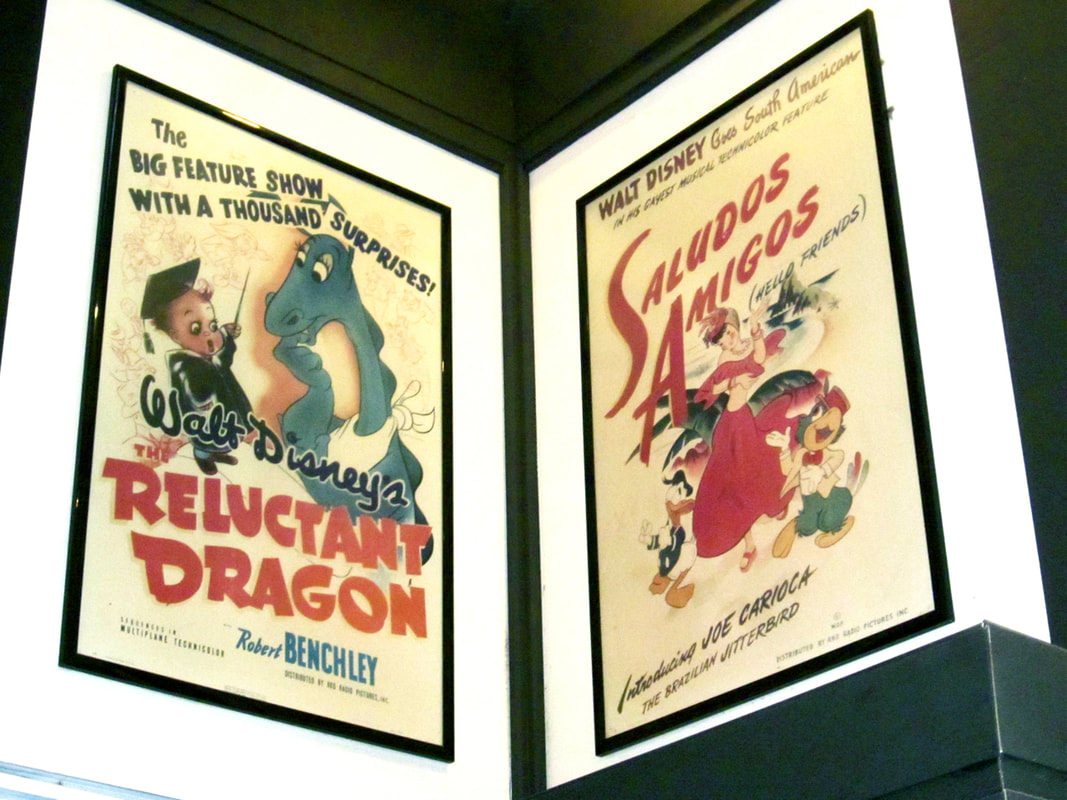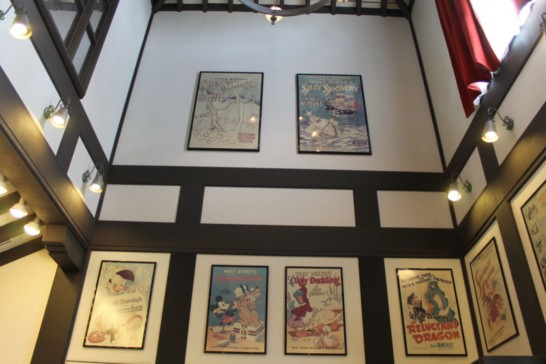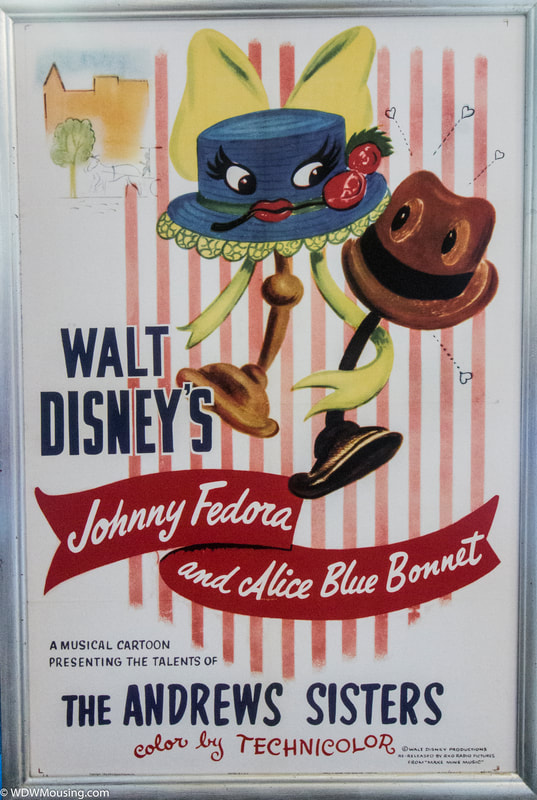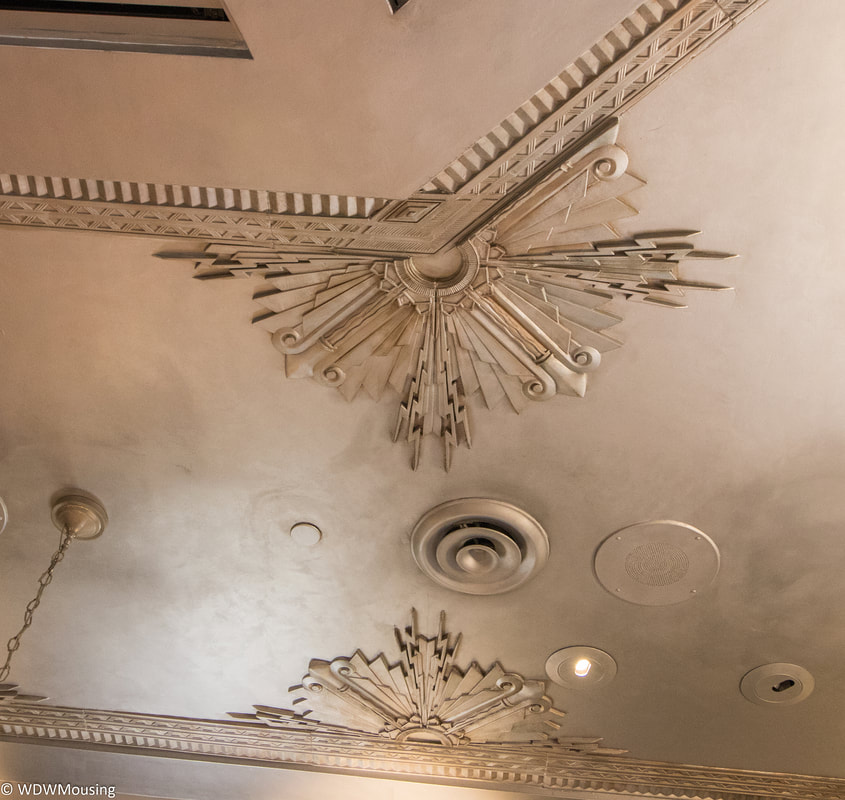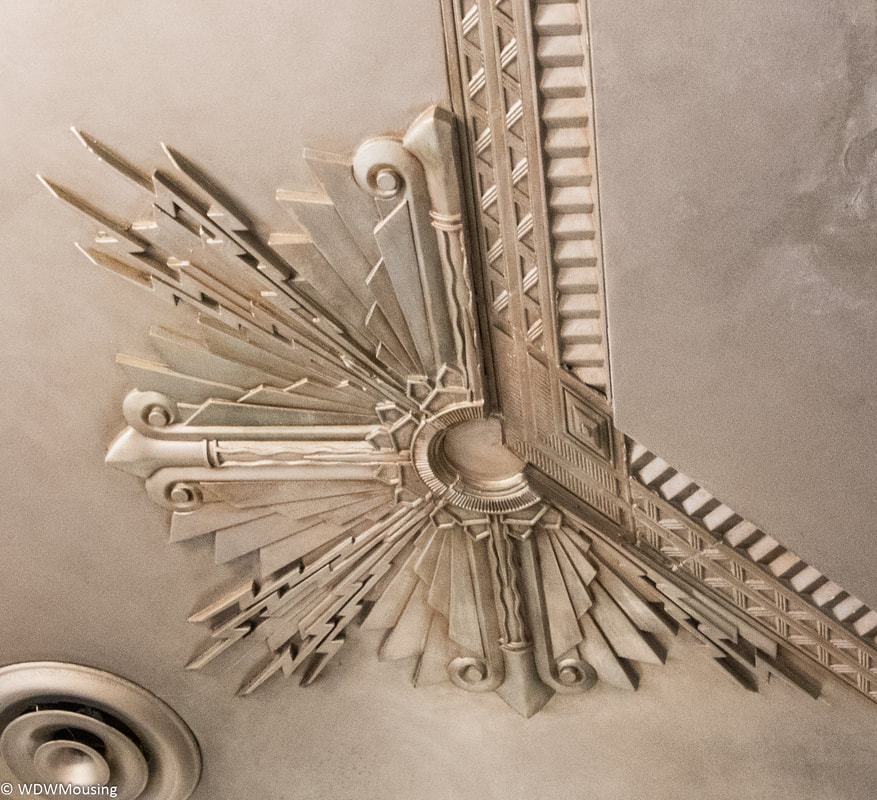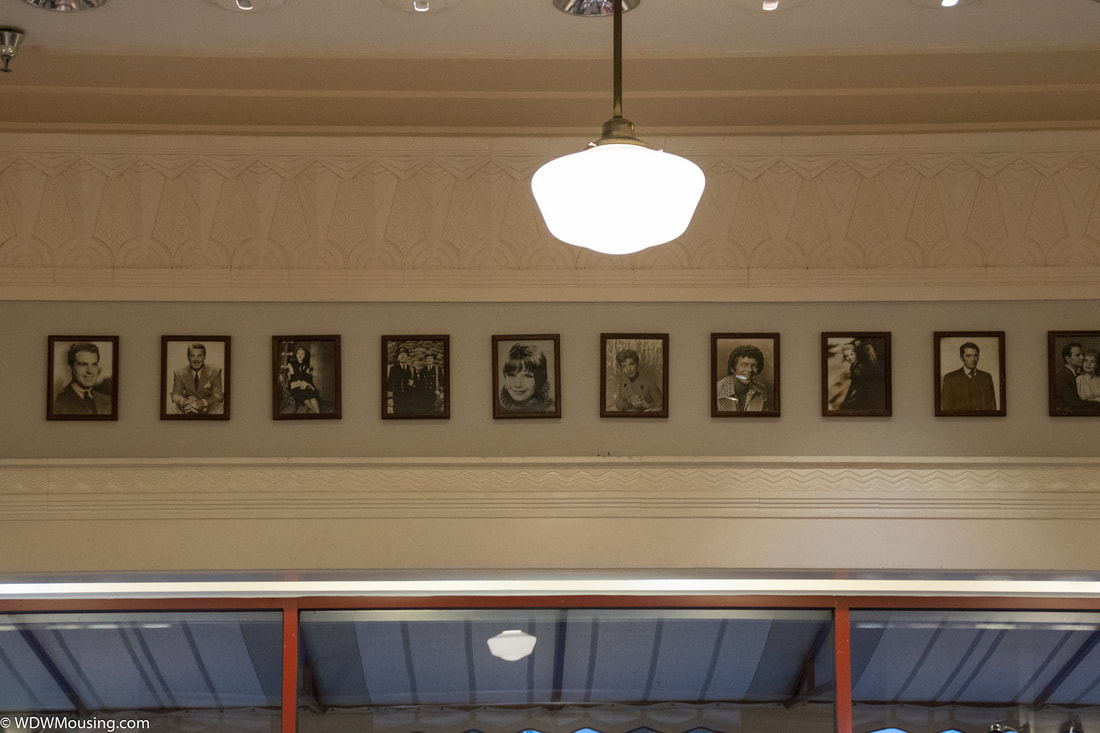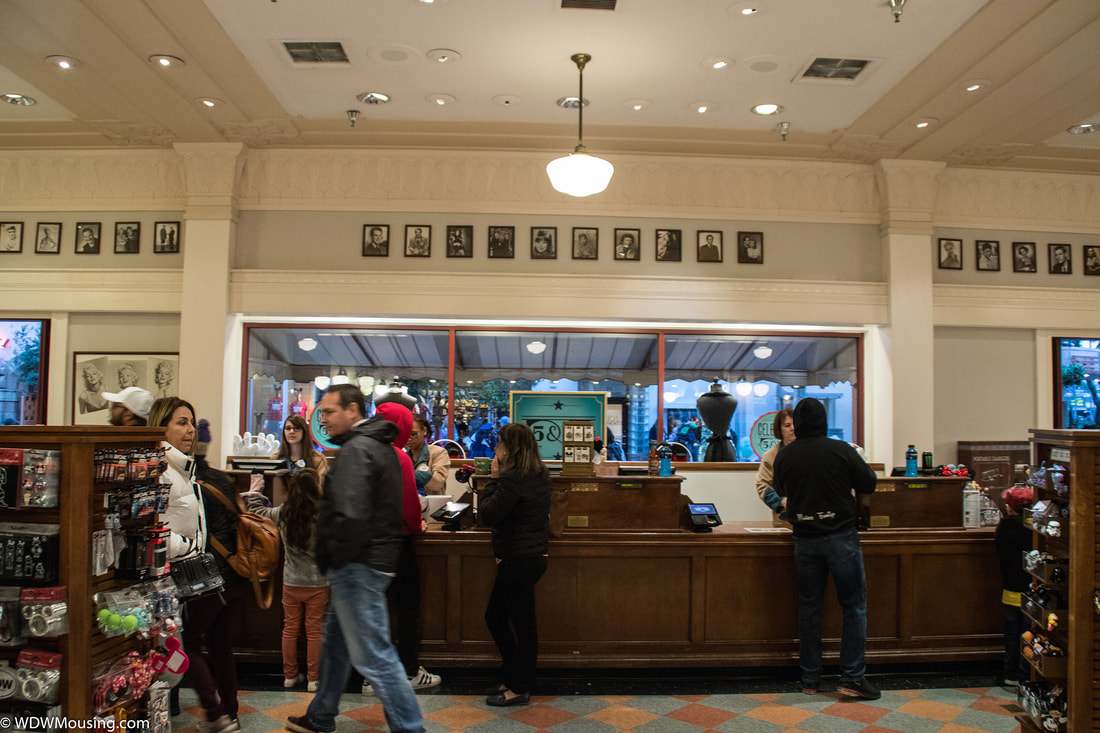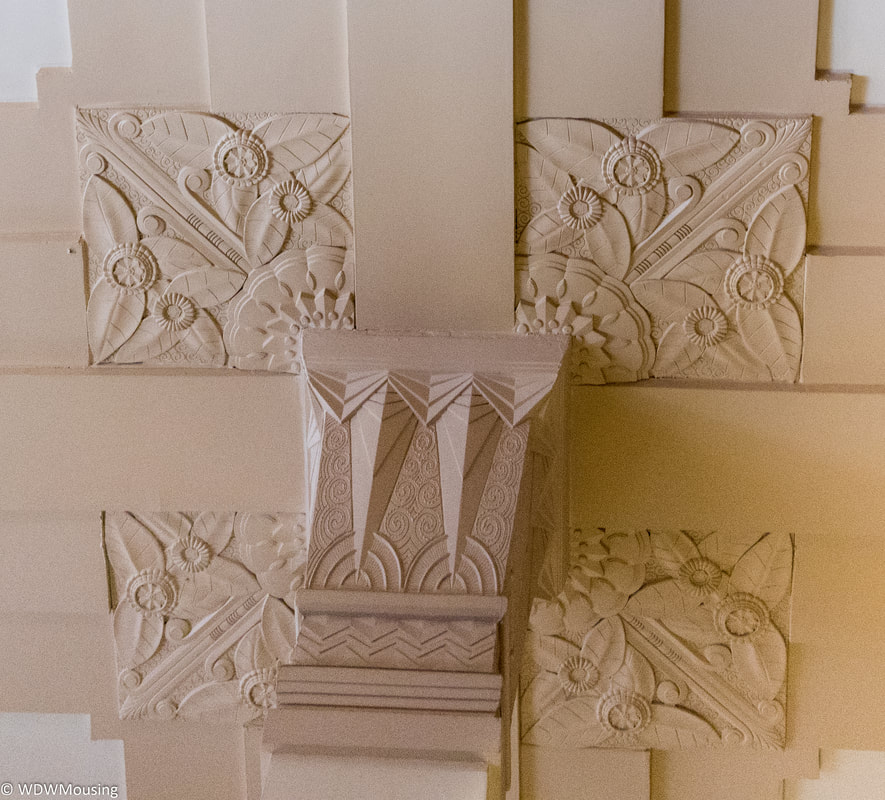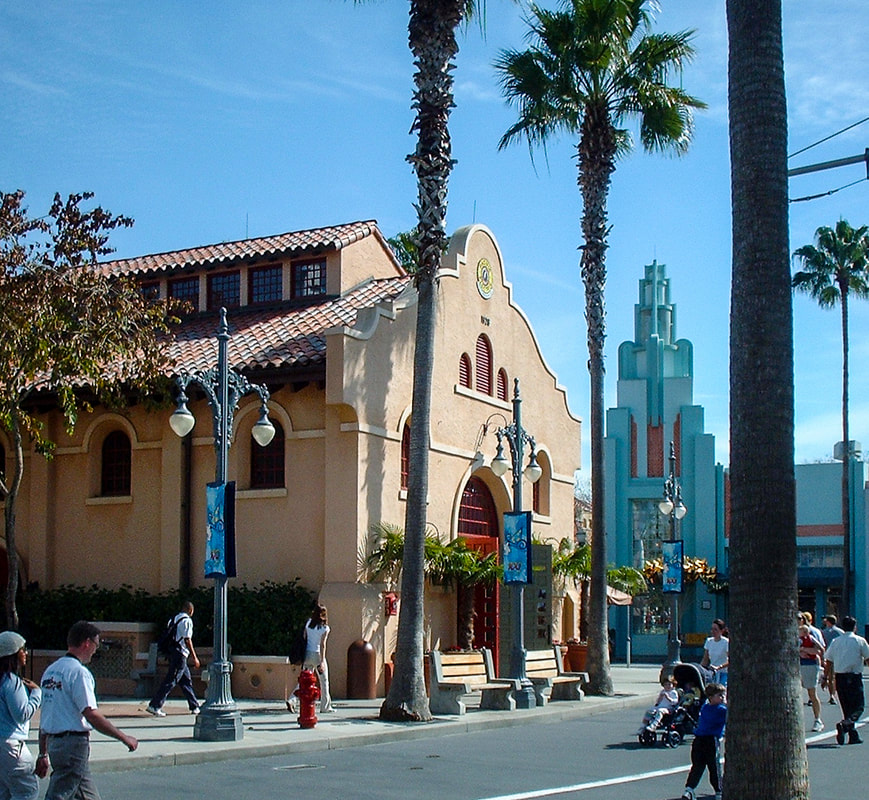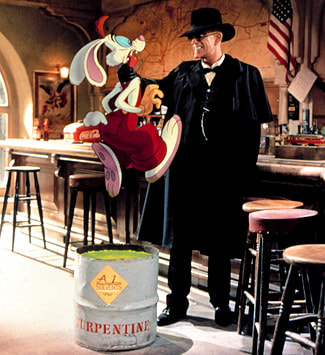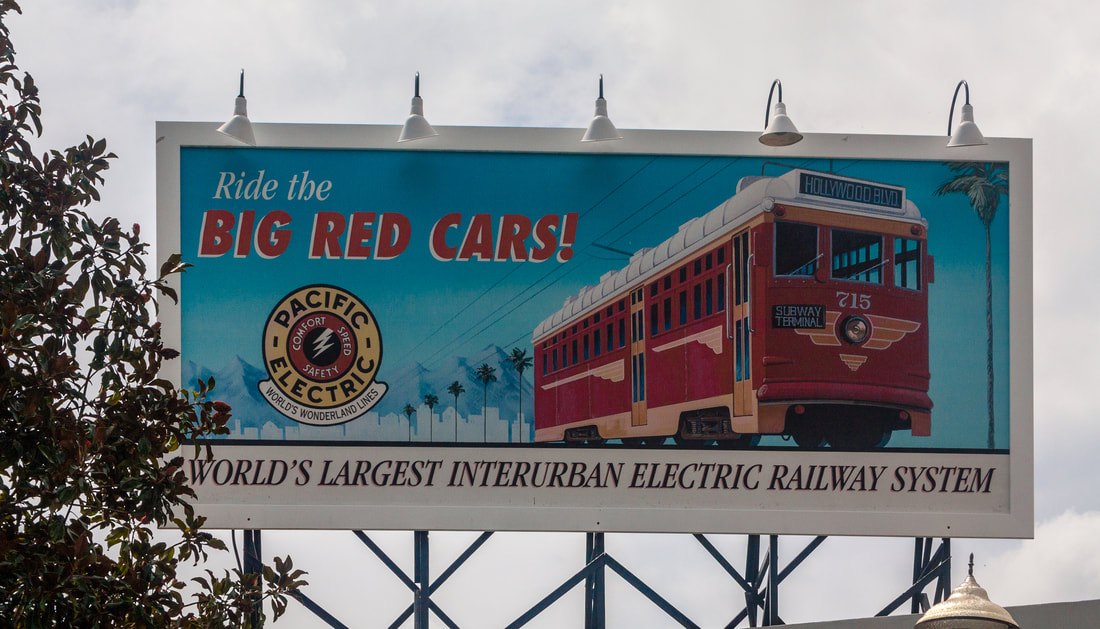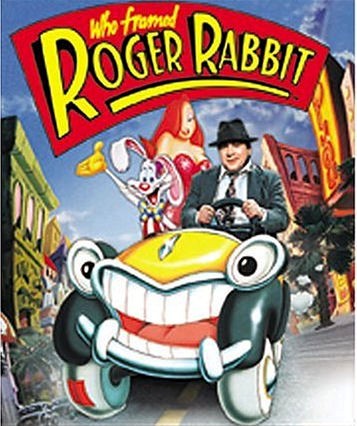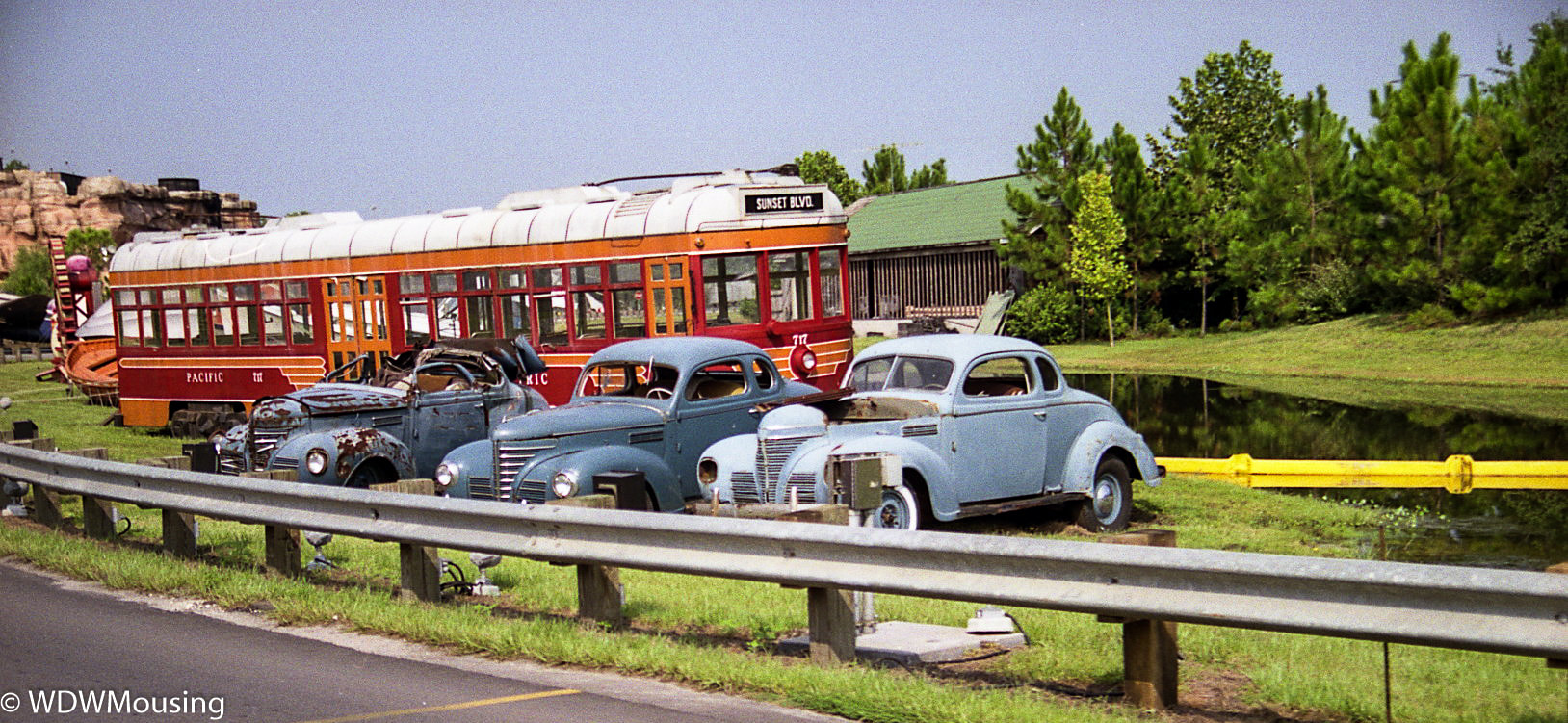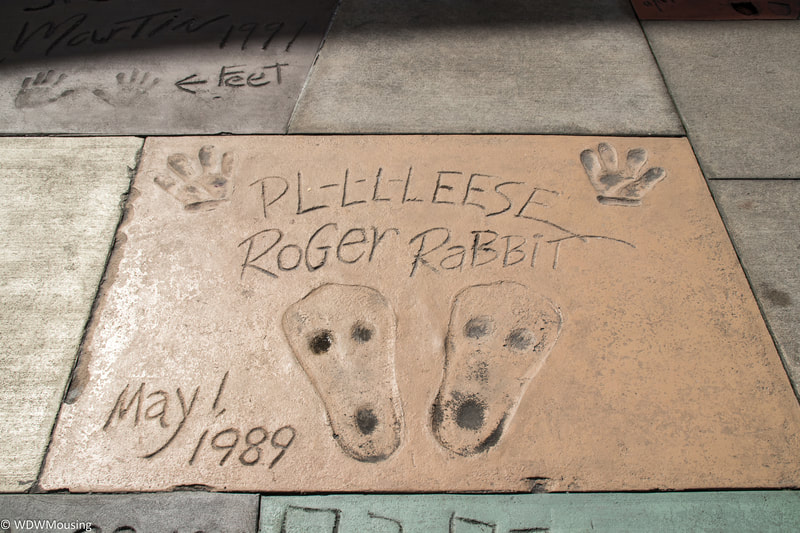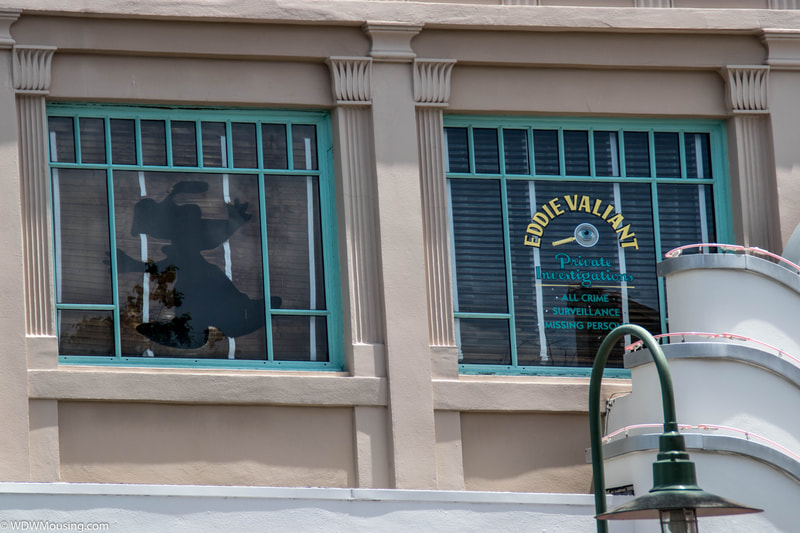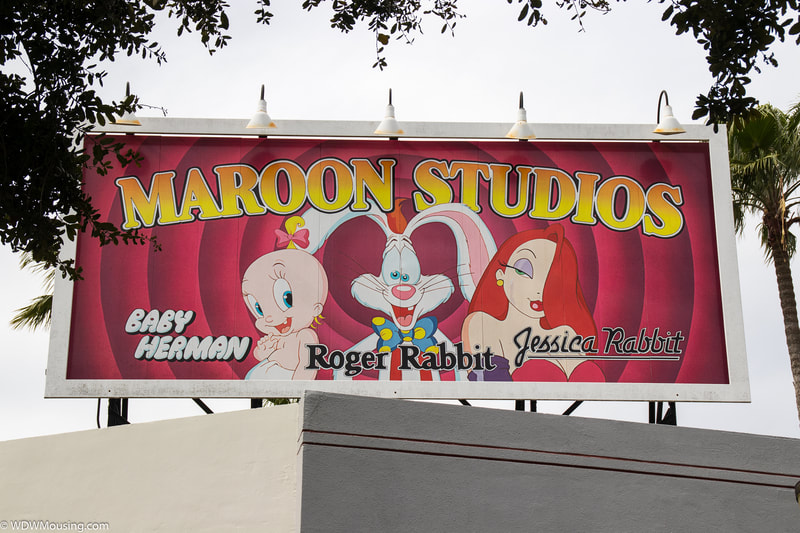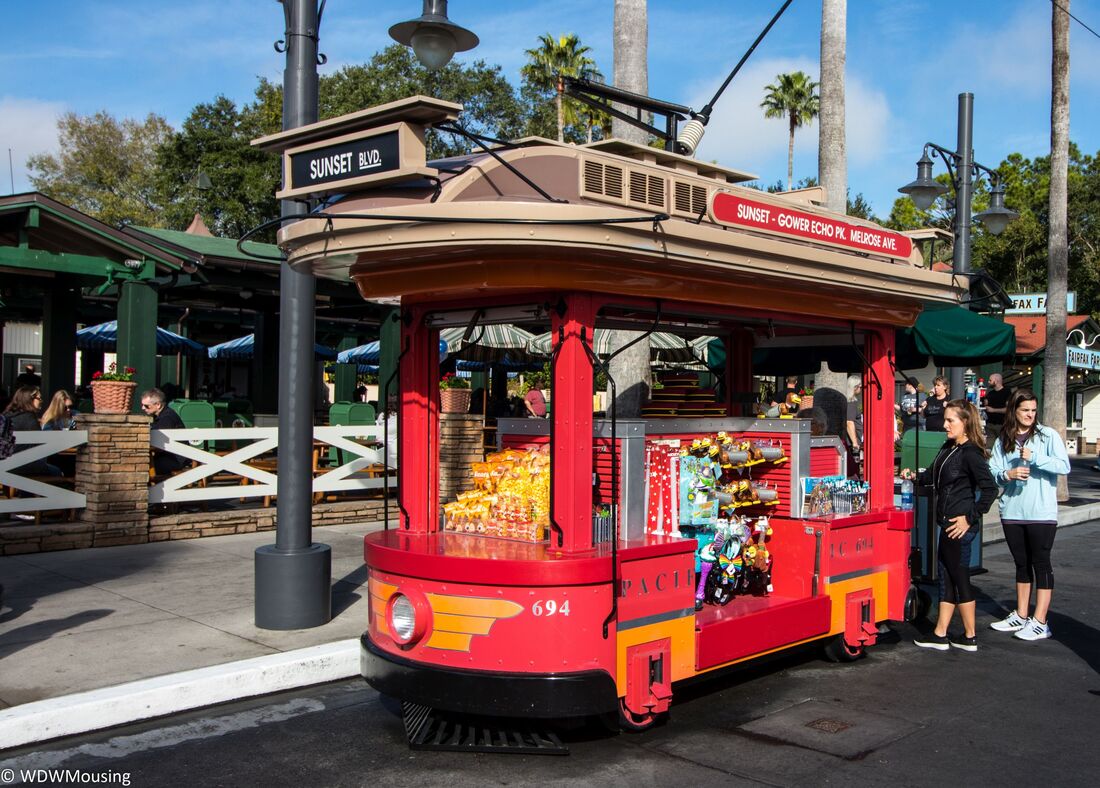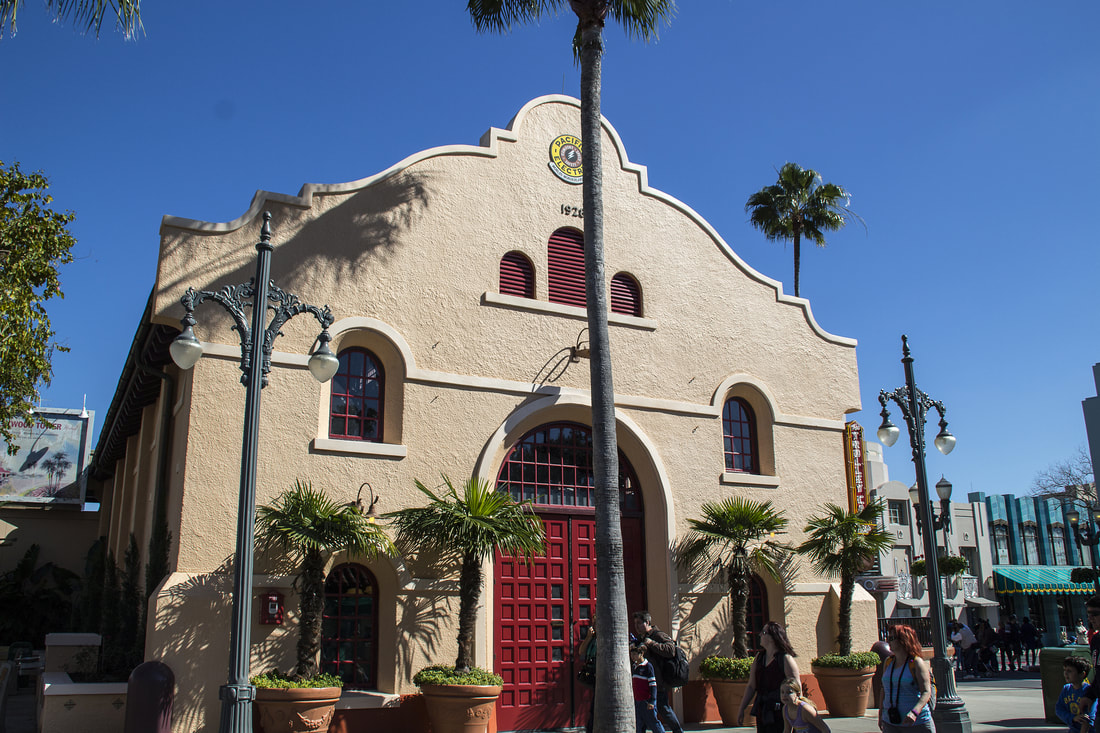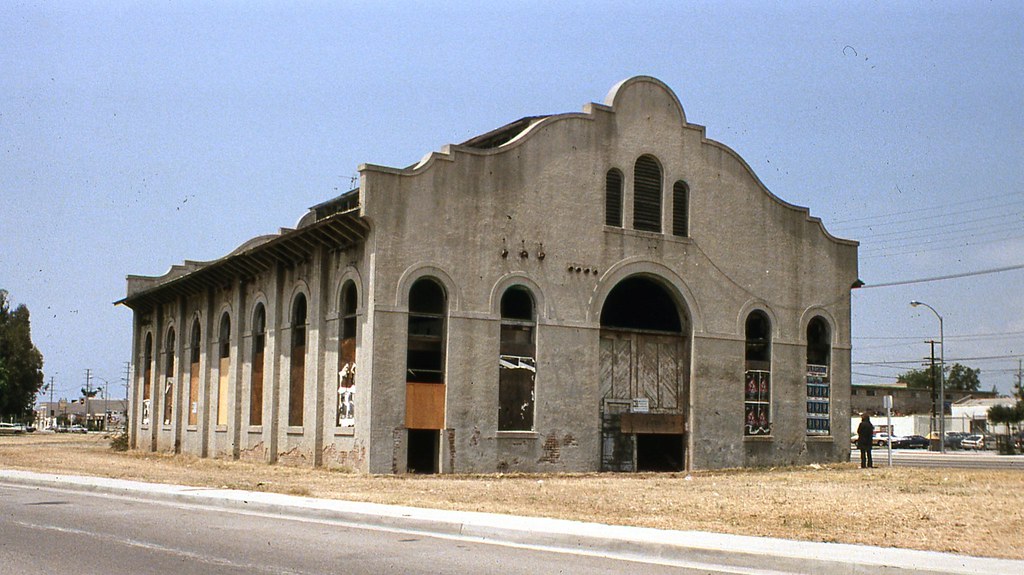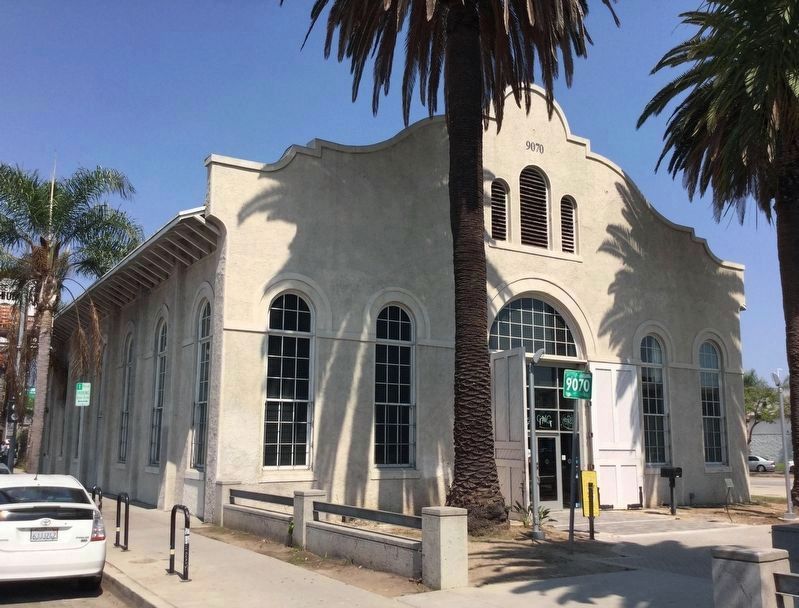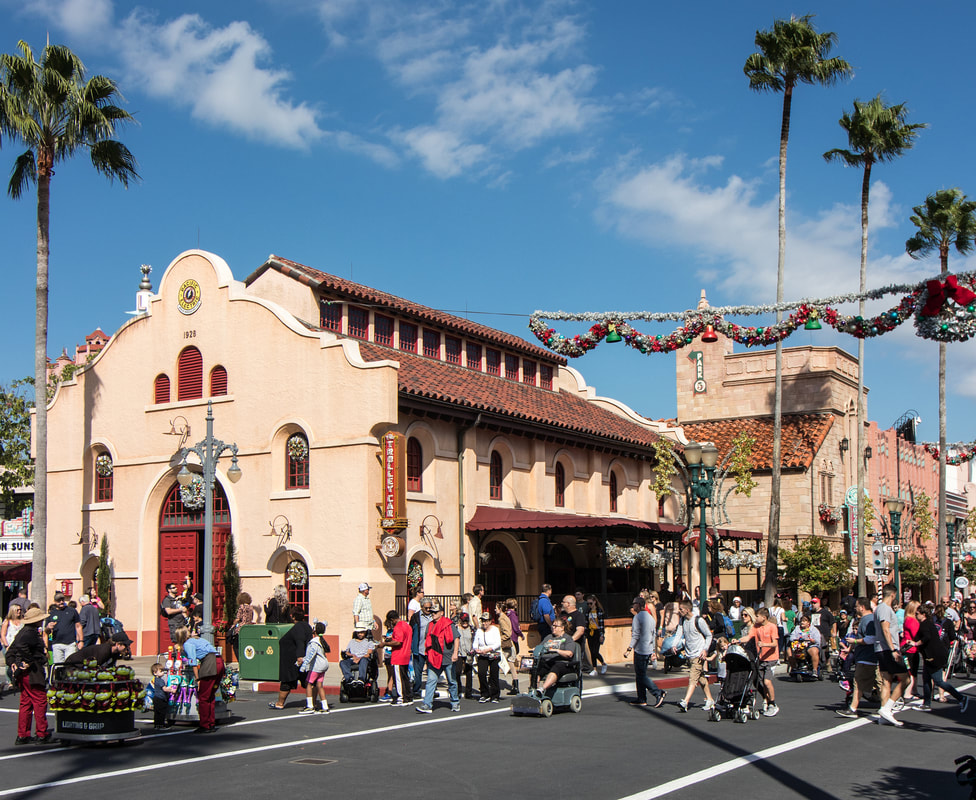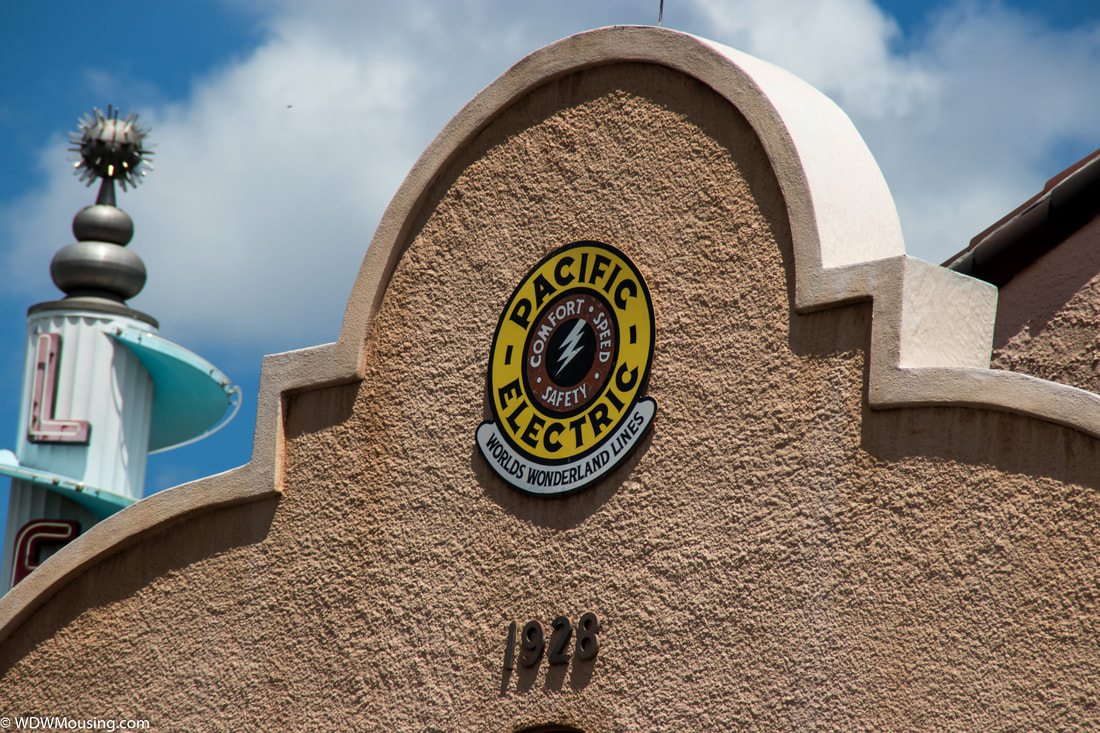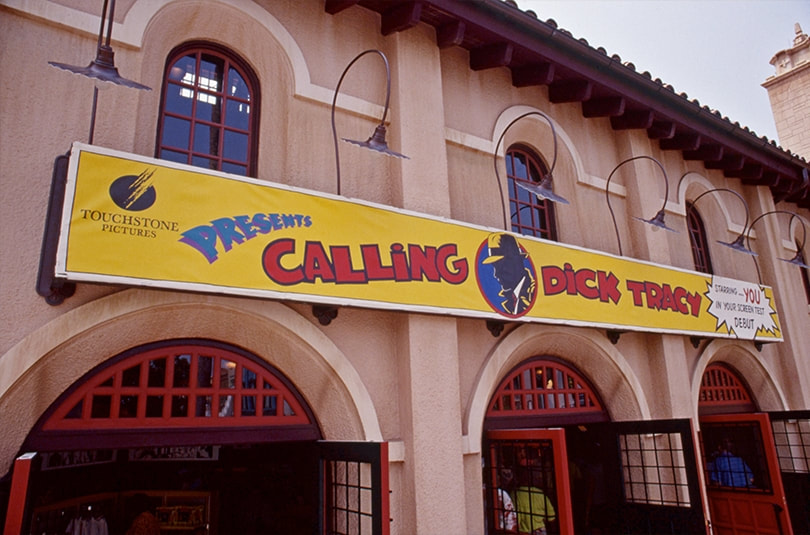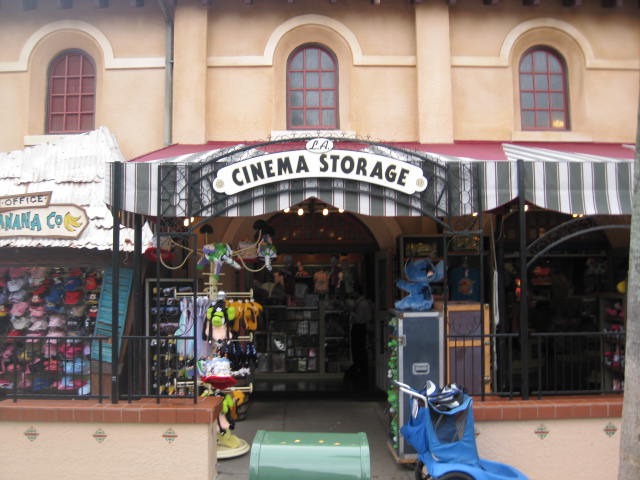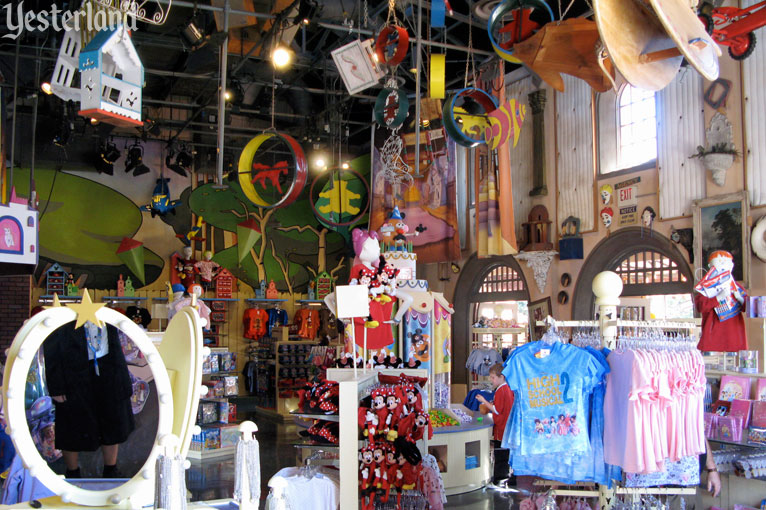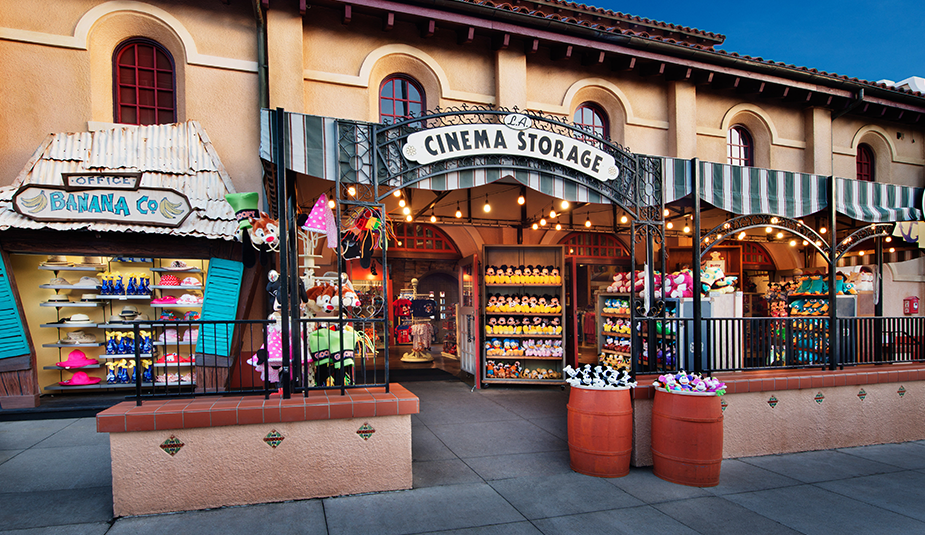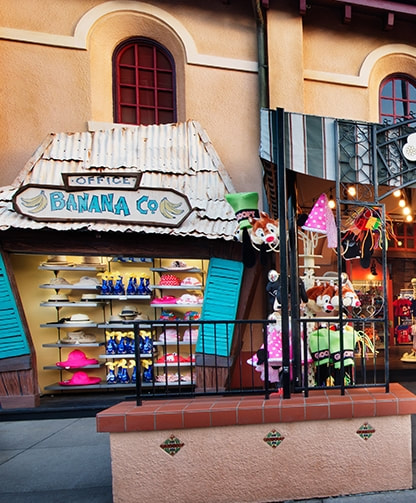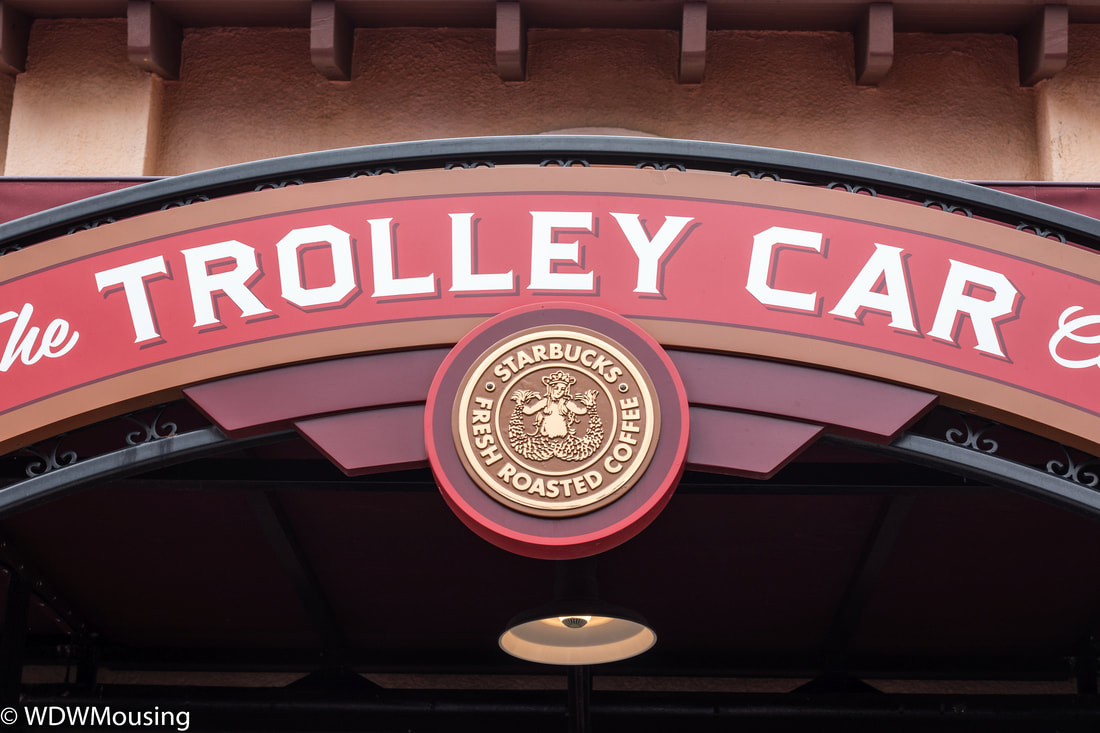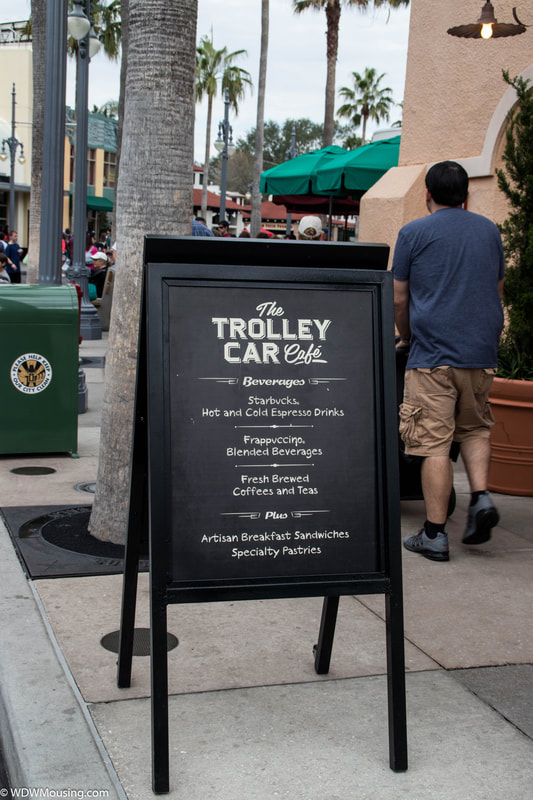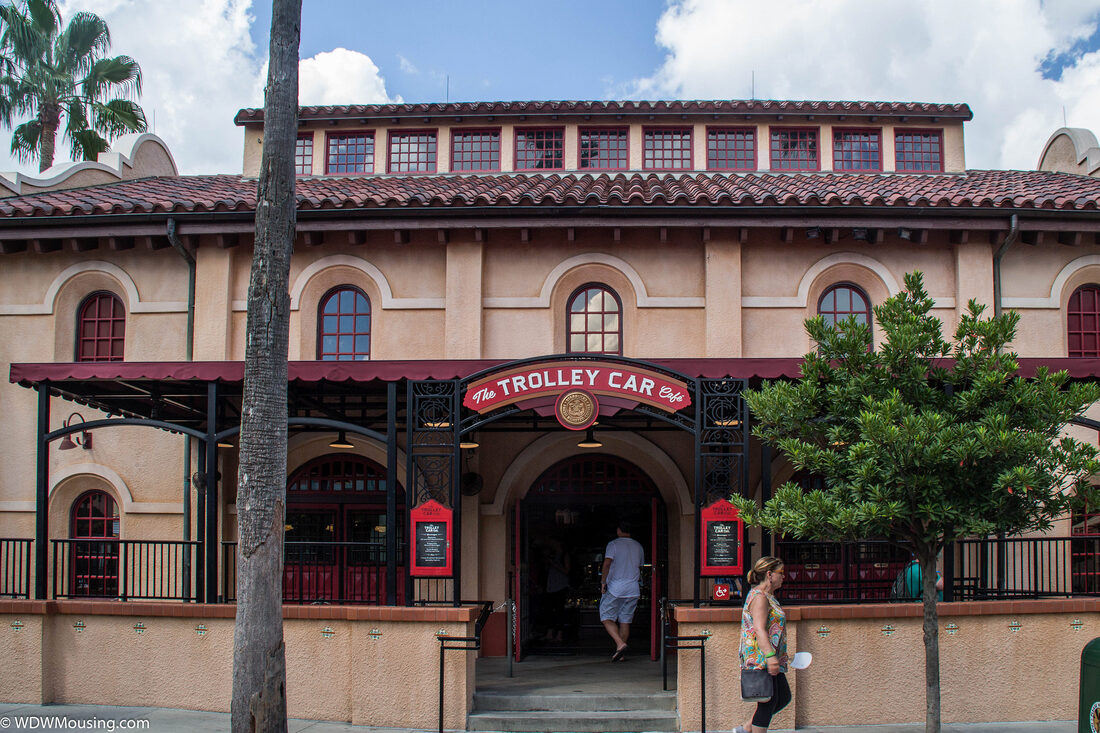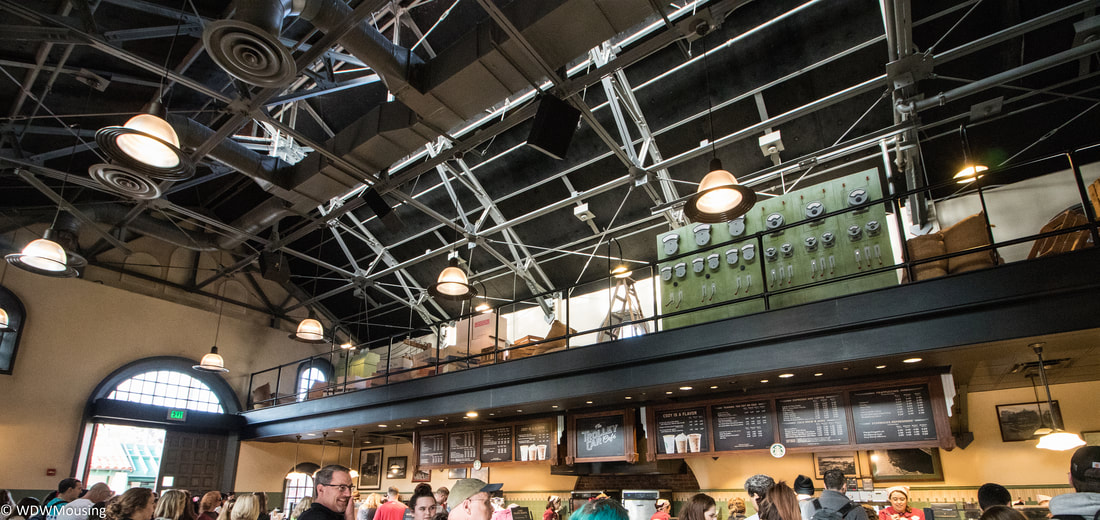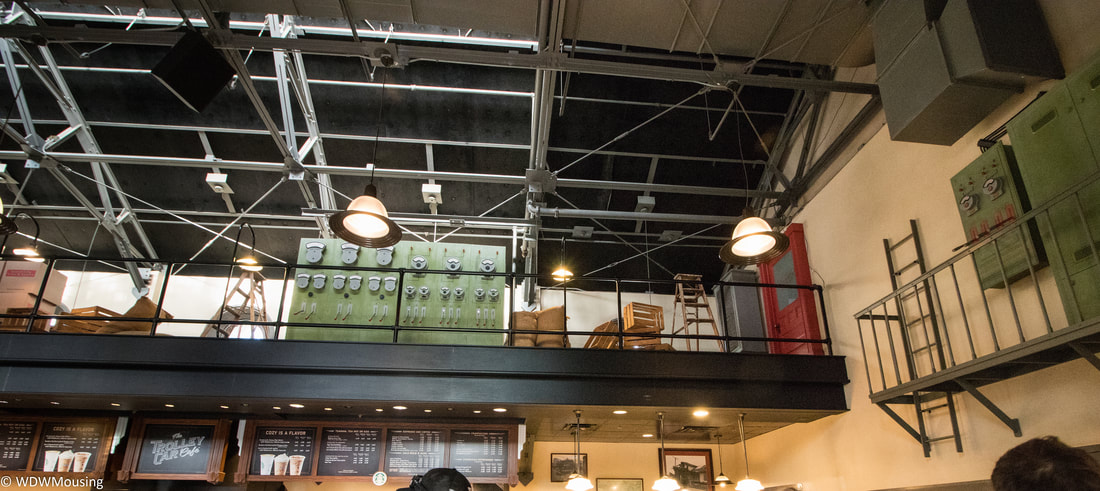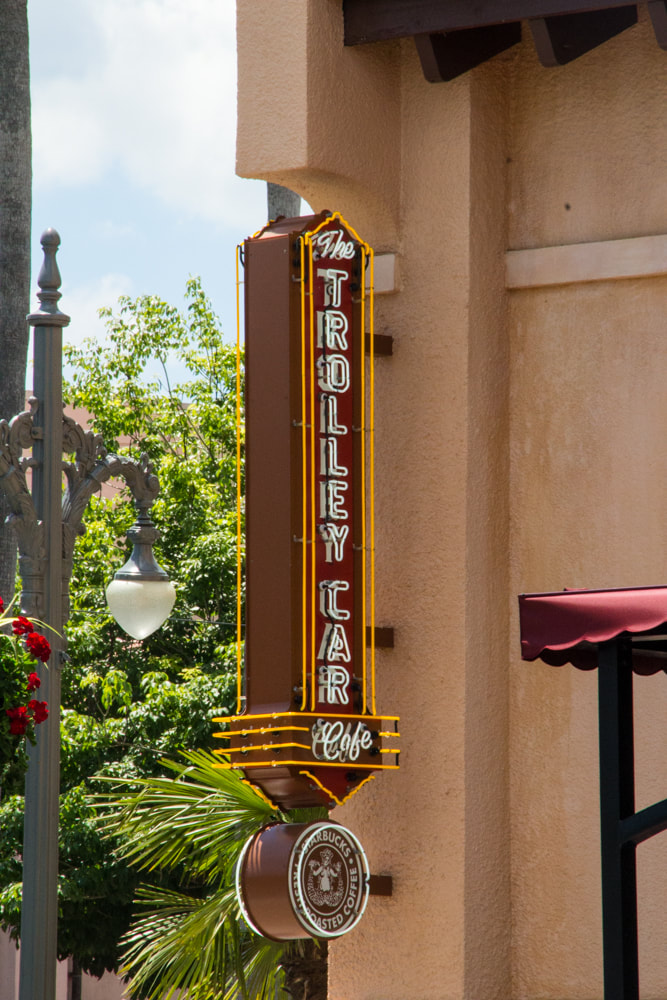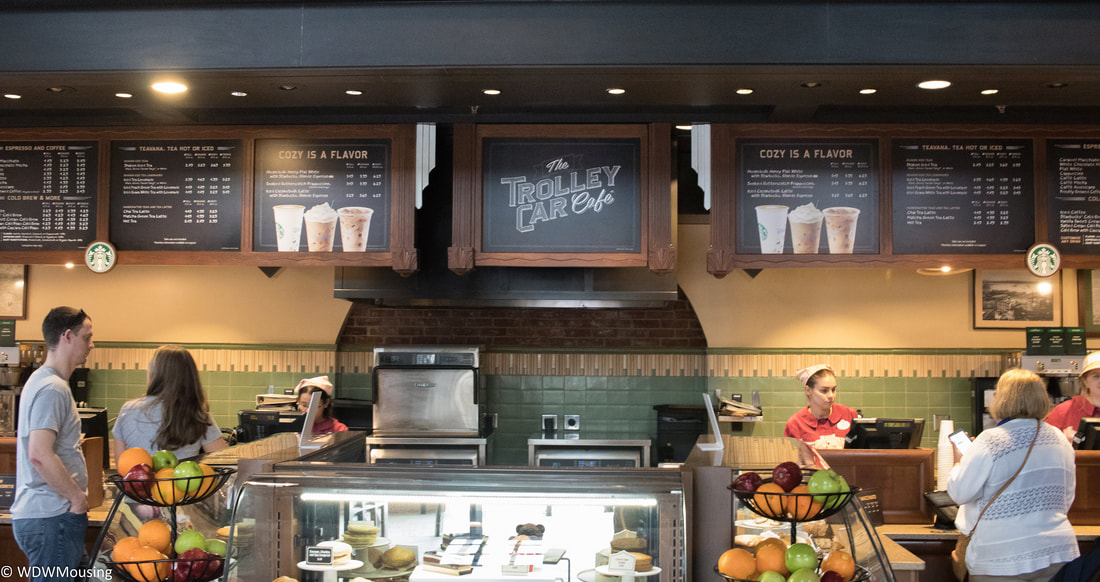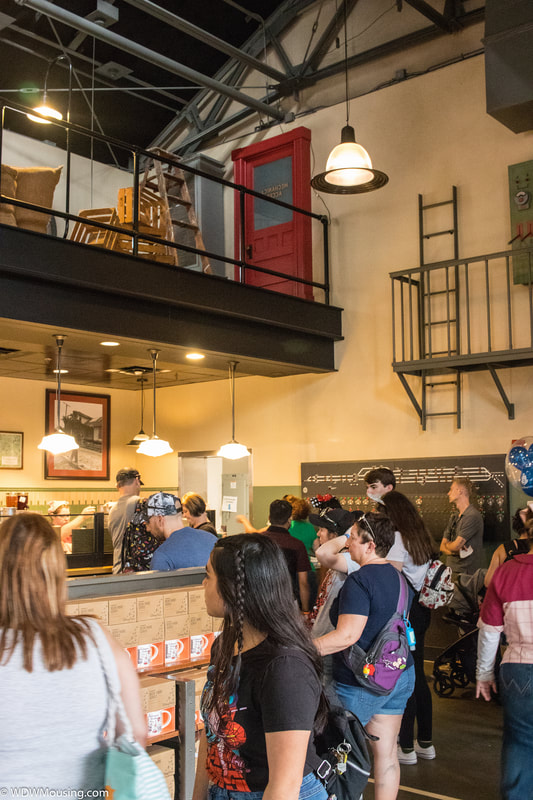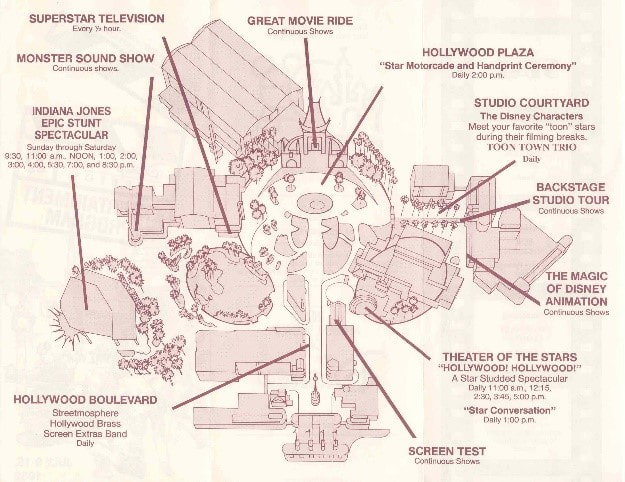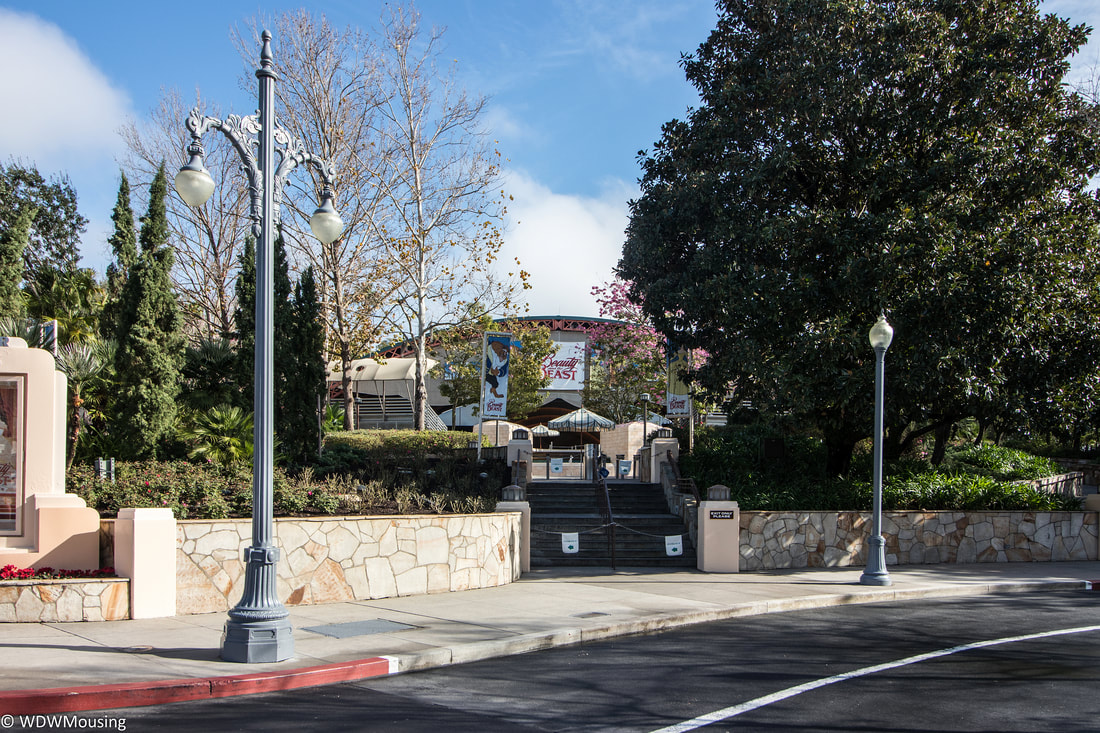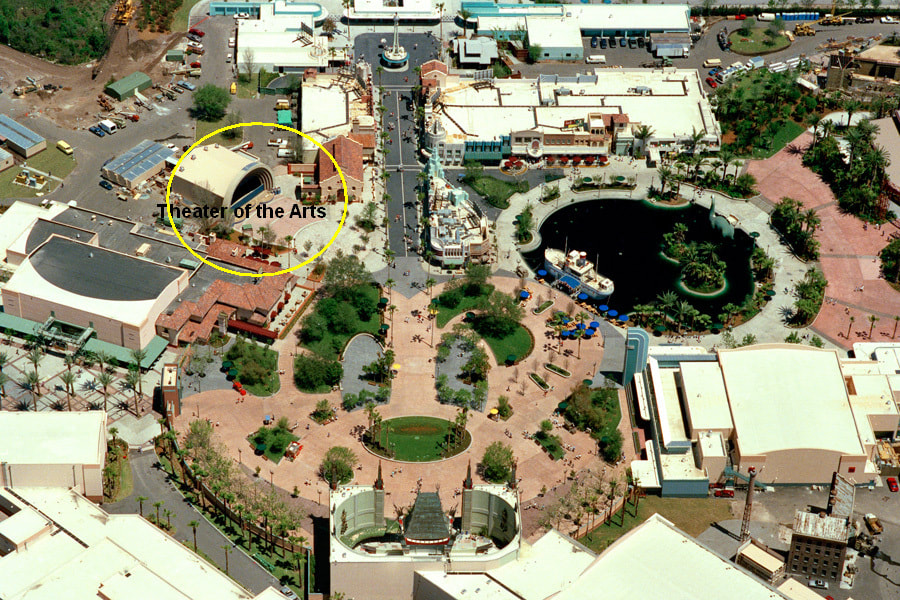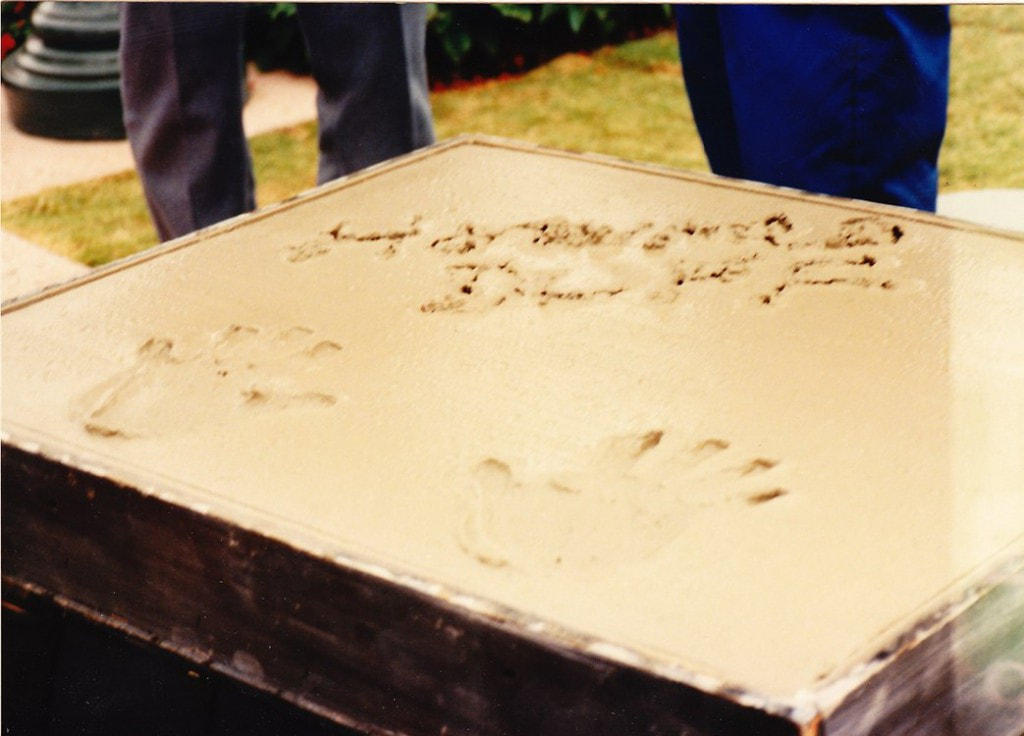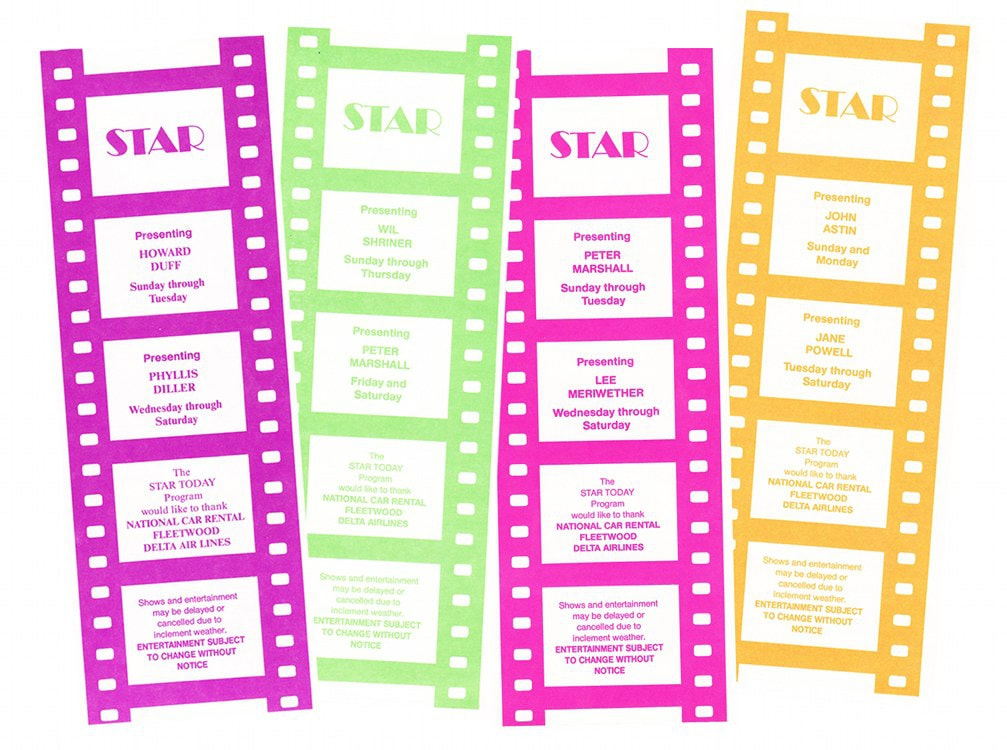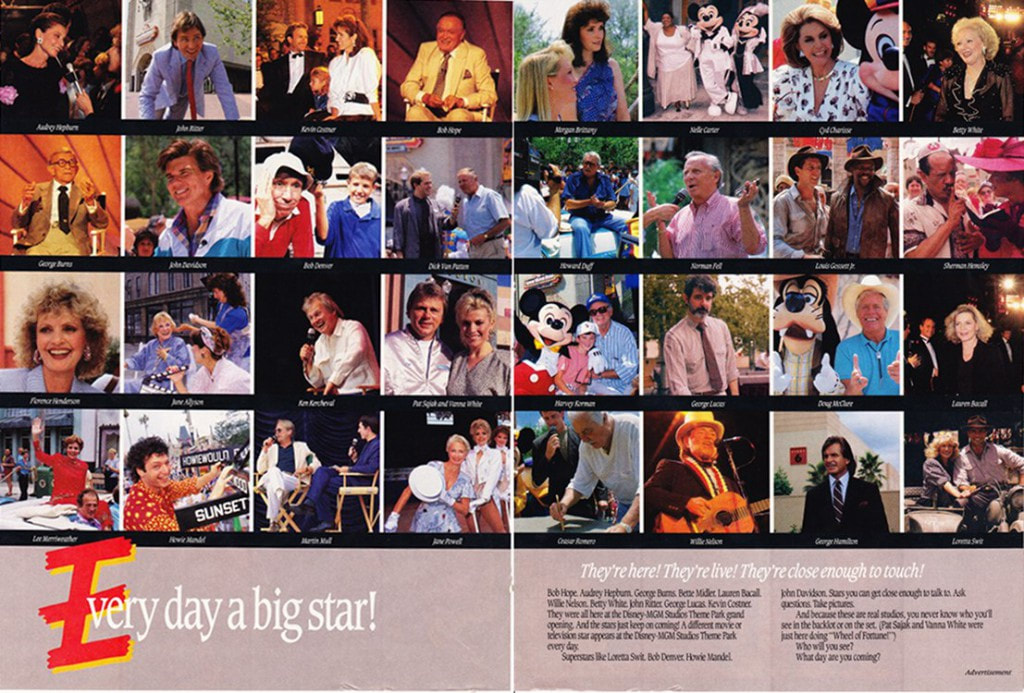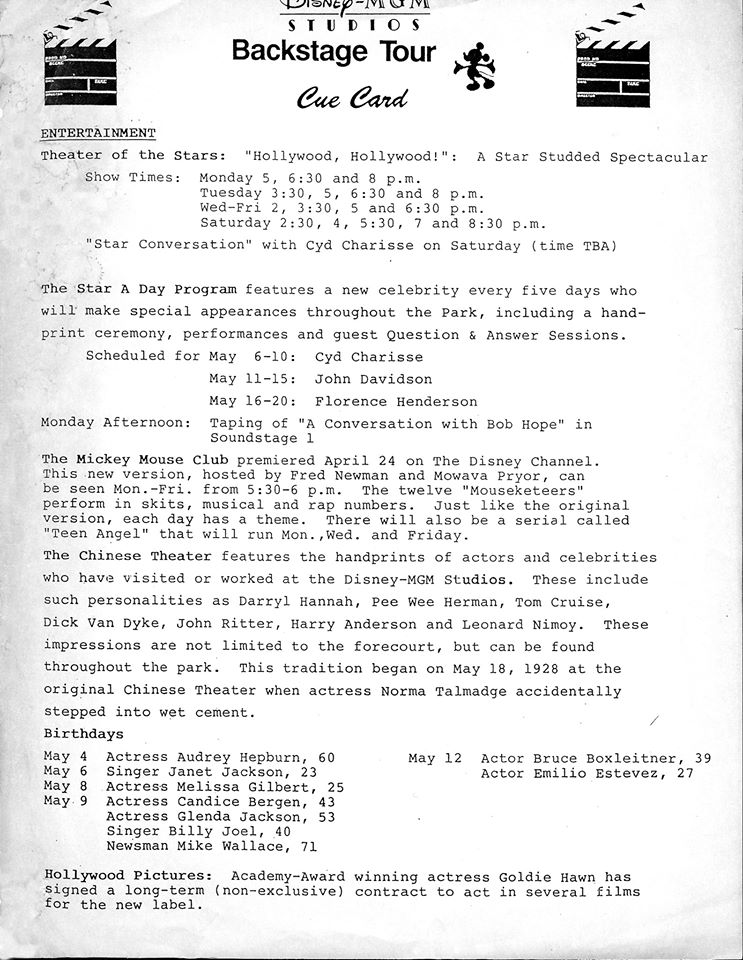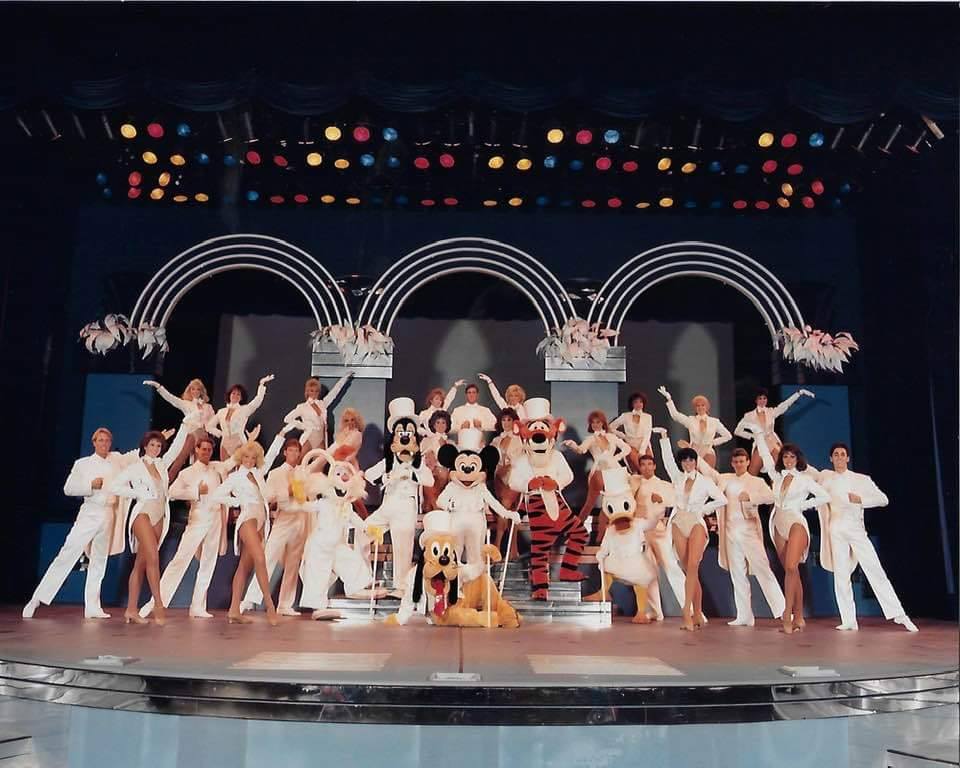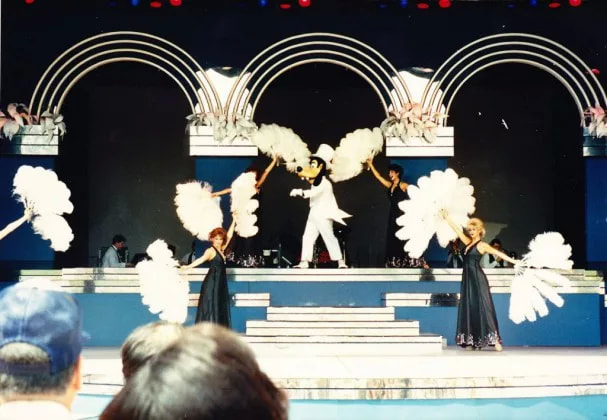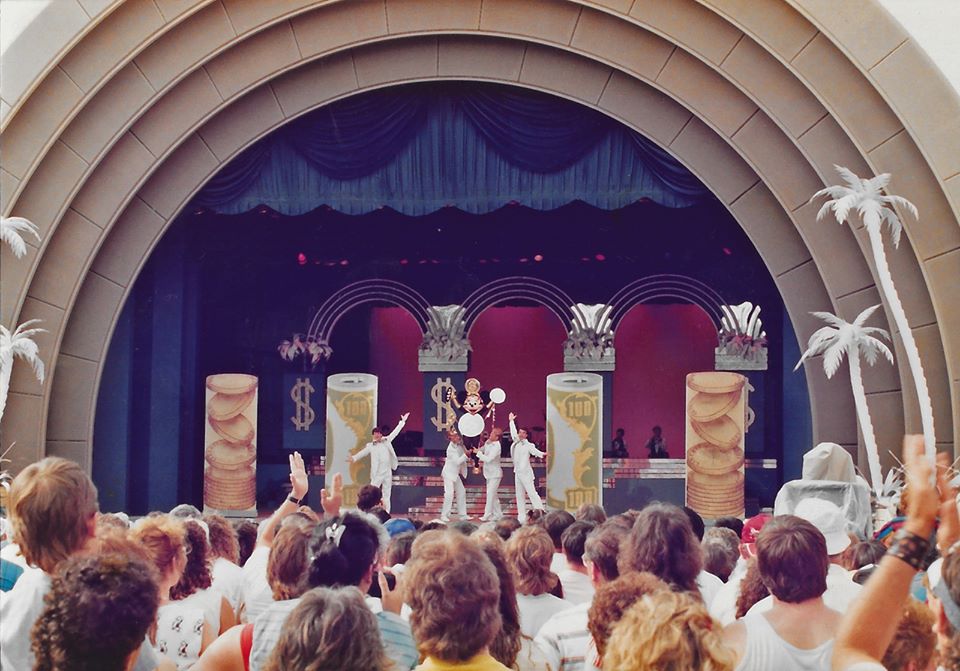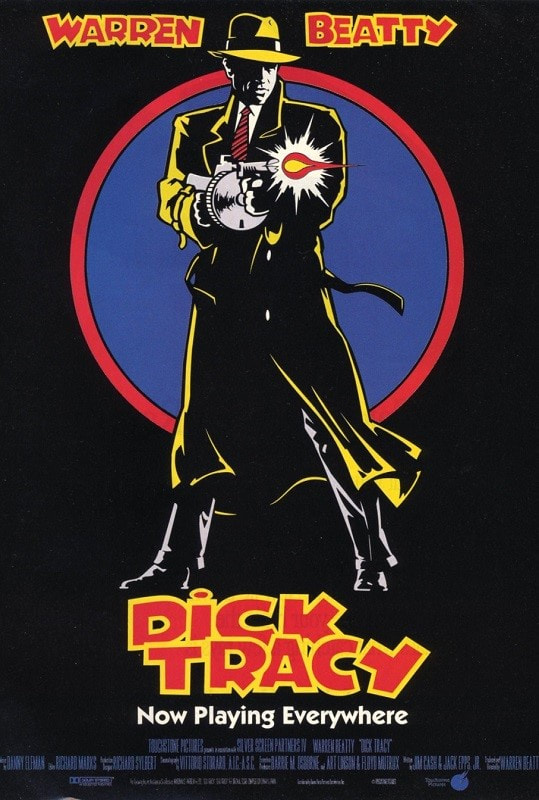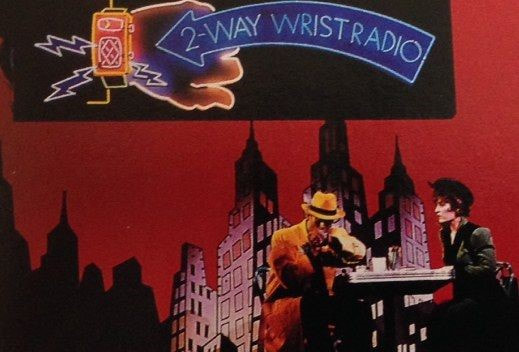Chapter 3 - Hollywood Studios – Hollywood Blvd – Part 2
updated Jun 2022
click on photos to enlarge
Our tour in the last Chapter took us up the left side of Hollywood Boulevard, with a look at Mickey’s of Hollywood, Keystone Clothiers, and all of the different facades portrayed from building of golden Hollywood age. Now we’ll return to the Crossroads Plaza and tour the right side of Hollywood Boulevard.
Ice Cold Snack Stand
Just inside Hollywood Studios entrance next to Oscar’s Super Service is the Ice Cold Snack Kiosk. It has limited menu and serves only cold soda, ice cream treats and a few snacks.
Oscar’s Super Service
Next to the Ice Cold Snack Stand is Oscar’s Super Service.
Oscar’s Super Service is a replica of a Streamline Moderne-style L.A. service station from the 1930’s and 40’s.
The service station, when the park opened in 1989, was originally known as Oscar's Classic Car Souvenirs which once contained NASCAR items.
Next to the Ice Cold Snack Stand is Oscar’s Super Service.
Oscar’s Super Service is a replica of a Streamline Moderne-style L.A. service station from the 1930’s and 40’s.
The service station, when the park opened in 1989, was originally known as Oscar's Classic Car Souvenirs which once contained NASCAR items.
Now it is the park’s location for renting wheelchairs, ECVs and strollers. Guests can also pick up their souvenir packages if they opted to have them sent to the front of the park. Inside the store there are sundries, snacks and other necessities sold.
|
Oscar’s was modeled after the Gilmore Gasoline Service Station that was located at Willoughby Ave. and N. Highland Ave. Although it lacks the roundness and crowning top of Oscar’s, there’s a distinct resemblance.
The double-canopied Gilmore Gasoline Service Station was designed in 1935 by an engineer named R.J. Kadow The Gilmore Oil Company was one of the largest oil producers and retailers in the country. Their “Red Lion” brand gas stations could be found throughout the West. It would later become a subsidiary of Mobil Gas. Reference:
|
Over the years, the gas station served as a backdrop for films, television commercials, and photo shoots, including the 1991 Steve Martin film L.A. Story, and the very first California State Lottery commercial filmed in Los Angeles.
In 2013, Starbucks converted the station into a drive-through/walk-up coffee shop. |
As in Mickey’s of Hollywood Shop on the left side of Hollywood Boulevard all of the shops behind the different facades (The Darkroom, Cover Story, Celebrity 5 and 10, and Adrian and Edith’s Head to Toe) are all connected.
The Darkroom
|
On the right hand side of Hollywood Boulevard the first store front guest see is The Darkroom.
The Darkroom, opened in 1989 was a former camera shop on Hollywood Boulevard at Hollywood Studios. The Darkroom, presented by Kodak, for film, camera rentals, camera repair service, accessories, and photo processing. During the 2017 renovations the shop had been transformed into a merchandise store selling pins and magic bands. |
click on photos to enlarge
The signage over the entrance showed from 1989 that Kodak was a sponsor of Walt Disney World which ended in 2012. In 2013 Nikon Becomes the Official Camera For Walt Disney World.
click photos to enlarge
Façade looks like an enormous camera.
|
The Darkroom was a real camera store on Wilshire Boulevard, Los Angeles. The original building was constructed in 1926, but the “camera” storefront was built in 1938. It was designed by architect Marus Miller. Its black vitrolite glass façade is one of the most famous examples of programmatic architecture in the world.
Since The Darkroom ceased being a camera store, it has been a series of restaurants. The remnants of the original storefront is protected as a Los Angeles historic cultural monument. The original building was constructed in 1926, but the “camera” storefront was built in 1938. It was designed by architect Marus Miller. Its black vitrolite glass façade is one of the most famous examples of roadside or programmatic architecture in the world. Reference:
|
Just above Oscar's Service Station, then it moved to above the Darkroom was the bulletin board for the Hollywood Canteen.
The original Hollywood Canteen was located on Cahuenga Boulevard in Hollywood. It operated during the war years from 1942 to 1945 and featured free food and entertainment for servicemen and servicewomen. The Canteen was the brainchild of stars Bette Davis and John Garfield, and they enlisted the entire entertainment industry to donate labor, materials and services to construct and operate the venue.
By the time it closed on Thanksgiving Day 1945, it had served nearly three million military personnel. In 1944, Warner Bros. released the film Hollywood Canteen which drew inspiration from the actual nightclub.
The original Hollywood Canteen was located on Cahuenga Boulevard in Hollywood. It operated during the war years from 1942 to 1945 and featured free food and entertainment for servicemen and servicewomen. The Canteen was the brainchild of stars Bette Davis and John Garfield, and they enlisted the entire entertainment industry to donate labor, materials and services to construct and operate the venue.
By the time it closed on Thanksgiving Day 1945, it had served nearly three million military personnel. In 1944, Warner Bros. released the film Hollywood Canteen which drew inspiration from the actual nightclub.
Cover Story
Cover Story window display still exhibits examples of the type of magazine photos that guests could have chosen.
This was the shop appearance during that time.
This was the shop appearance during that time.
In 2017 the shops on this side of Hollywood Boulevard were refurbished.
Cover Story now no longer transposes guests’ faces onto the covers of major magazines and PhotoPass/Memory Maker pickup had been moved to Sid Caheunga’s One-of-a-Kind shop.
Cover Story now offers home goods, stationary, toys and plush merchandise, and small souvenirs.
Cover Story now no longer transposes guests’ faces onto the covers of major magazines and PhotoPass/Memory Maker pickup had been moved to Sid Caheunga’s One-of-a-Kind shop.
Cover Story now offers home goods, stationary, toys and plush merchandise, and small souvenirs.
During the same refurbishment, The Darkroom was expanded into a Disney Pin and phone case store.
The other façades on Disney’s Hollywood Blvd. had counterparts somewhere in the Los Angeles area. But Cover Story’s striped façade was inspired by the McGraw-Hill Building located on West 42nd Street, in New York City in the early 1930’s. In 1989, the McGraw-Hill Building was designated a National Historic Landmark by the National Park Service.
The other façades on Disney’s Hollywood Blvd. had counterparts somewhere in the Los Angeles area. But Cover Story’s striped façade was inspired by the McGraw-Hill Building located on West 42nd Street, in New York City in the early 1930’s. In 1989, the McGraw-Hill Building was designated a National Historic Landmark by the National Park Service.
The Imagineers probably decided on this New York City building because the façade fit in well with the other Hollywood Boulevard façades and perhaps because Cover Story Shop fit into a building based on the headquarters of a major magazine publisher.
Reference
Reference
- https://www.laughingplace.com/w/articles/2017/03/27/disneys-hollywood-studios-photo-update/
- https://www.couponingtodisney.com/cover-story-hollywood-studios/
- https://orlandoparkstop.com/news/construction-update/hollywood-studios-update-star-wars-land-toy-story-land-construction-the-darkroom-open-and-more/
- https://nyc-architecture.com/MID/MID130.htm
- https://en.wikipedia.org/wiki/Raymond_Hood
|
Above the entrance to the Cover Story are windows with the name Mel Rose – Agent to the Stars. This is in reference to the Streetmosphere entertainer’s.
One of the greatest forms of entertainment of Disney’s Hollywood Studios are the Streetmoshere Characters. These street performers show up on Hollywood and Sunset Boulevard to complete the illusion that guests have traveled to Hollywood of the 30’s and 40’s. Reference: |
Celebrity 5 & 10
Celebrity 5 & 10 is located next to Cover Story. Inside Celebrity 5 & 10 guests will find Disney merchandise for the home such as kitchen items, tableware, pillow, mugs, Disney character items and more. The Celebrity 5 & 10 products has been mostly the similar since the shop open in 1989.
Celebrity 5 & 10 is located next to Cover Story. Inside Celebrity 5 & 10 guests will find Disney merchandise for the home such as kitchen items, tableware, pillow, mugs, Disney character items and more. The Celebrity 5 & 10 products has been mostly the similar since the shop open in 1989.
click on photos to enlarge
Characters on display at the Celebrity 5 & 10
Disney character cutouts were originally created for a window display at the nearby “Darkroom” store that celebrated the 25th anniversary of Disney’s Hollywood Studios in 2014 , but were added to the Celebrity 5 & 10 store. Guests could spot cutouts of Mickey Mouse and some of his friends, including the stylish Daisy Duck seen above, incorporated into its decor.
These cutouts were made in the style they appeared in during the 1930s. Although Mickey’s 1930s look is iconic, Daisy Duck only appeared in this vintage form during her film debut in 1937’s “Don Donald.” By her second big screen role in 1940s “Mr. Duck Steps Out,” she had already received a makeover more in line with how we know her today. Daisy may not have gotten as much experience being a 1930s movie star as some of her Disney costars, but her appearance at “Celebrity 5 & 10” certainly shows that she can be just as glamorous as any other Hollywood starlet of that era.
As of 2019, the cutouts were no longer used as part of the decoration for “Celebrity 5 & 10,” nor are any of the other Disney character cutouts that appeared alongside her.
Info Source:
Disney character cutouts were originally created for a window display at the nearby “Darkroom” store that celebrated the 25th anniversary of Disney’s Hollywood Studios in 2014 , but were added to the Celebrity 5 & 10 store. Guests could spot cutouts of Mickey Mouse and some of his friends, including the stylish Daisy Duck seen above, incorporated into its decor.
These cutouts were made in the style they appeared in during the 1930s. Although Mickey’s 1930s look is iconic, Daisy Duck only appeared in this vintage form during her film debut in 1937’s “Don Donald.” By her second big screen role in 1940s “Mr. Duck Steps Out,” she had already received a makeover more in line with how we know her today. Daisy may not have gotten as much experience being a 1930s movie star as some of her Disney costars, but her appearance at “Celebrity 5 & 10” certainly shows that she can be just as glamorous as any other Hollywood starlet of that era.
As of 2019, the cutouts were no longer used as part of the decoration for “Celebrity 5 & 10,” nor are any of the other Disney character cutouts that appeared alongside her.
Info Source:
The term “5 & 10” goes back to the time when retail department stores such as S.H. Kress, J.J. Newberry, and F.W. Woolworth were the retail cores of cities and towns throughout America.
Imagineers designed the exterior to reflect a variety store in Hollywood called J.J. Newberry, only they found that the turquoise color didn’t work for Hollywood Studios’ Hollywood Boulevard, so they changed it.
he inspiration was the former J.J. Newberry on Hollywood Boulevard, Los Angeles. The turquoise-and-gold 1928 J.J. Newberry building was designed by The J.J. Newberry Company’s own architects. The store is located across the street from the Baine Building, that was the inspiration for Mickey’s of Hollywood Store (See Chapter 2).
On the JJ Newberry Building, you can see blue-green glazed terra-cotta and Egyptian motifs, which became popular in Art Deco style after the 1922 discovery of King Tutankhamun’s tomb.
Reference:
On the JJ Newberry Building, you can see blue-green glazed terra-cotta and Egyptian motifs, which became popular in Art Deco style after the 1922 discovery of King Tutankhamun’s tomb.
Reference:
- https://disneyworld.disney.go.com/shops/hollywood-studios/celebrity-5-and-10/
- https://martinturnbull.com/2016/02/16/j-j-newberry-store-at-6600-hollywood-blvd/
- https://www.yesterland.com/replicas.html
- http://studioscentral.com/why/celebrity-5-10/
- http://fbnoodleman.blogspot.com/2014/11/art-deco-49996.html
Adrian and Edith’s Head to Toe
Originally Sweet Success opened in this location with the rest of the Disney-MGM Studios on May 1, 1989, this shop sold specialized candy and other treats.
Originally Sweet Success opened in this location with the rest of the Disney-MGM Studios on May 1, 1989, this shop sold specialized candy and other treats.

Note: Not to confuse the Original Sweet Success shop on Hollywood Boulevard with Sweet Spells which was on Sunset Boulevard.
Source:
|
Imagineers classic Hollywood reference to two of Hollywood’s legendary costume designers, Adrian Greenberg and Edith Head
|
Note: Edith Head may have been the influence for the Incredibles character Edna Mode — an elite designer in her own right. |
References:
References:
- https://www.disneyfoodblog.com/2018/11/08/more-changes-at-hollywood-studios-adrian-and-ediths-reopens-with-snacks-and-merch/
- http://studioscentral.com/why/adrian-ediths-head-to-toe/
- https://waltdatedworld.com/id108.htm
- https://www.laughingplace.com/w/articles/2018/11/05/adrian-ediths-head-to-toe-at-disneys-hollywood-studios-reopens-as-sweet-shop/
- https://www.wdwkingdom.com/adrian-ediths-head-to-toe-disneys-hollywood-studios-hollywood-boulevard-shopping/
- http://2719hyperion.blogspot.com/2008/01/adrian-and-ediths-head-to-toe.html
|
The Imagineers designed the façade after the Chapman Park Market Building located West 6th Street, Los Angeles. The Chapman Park Market was one of the first West Coast markets designed specifically for customers arriving by automobile.(with Parking around back) Architect Stiles Clements of Morgan, Walls & Clements is responsible for this 1929 Spanish Colonial Revival style complex with extensive Churrigueresque detailing. Note: Morgan, Walls & Clements architects were used for several of the Hollywood Boulevard facades. (See Chapter 2 Hollywood Studios) |
Reference:
Classic Disney Posters of Adrian & Edith’s
Hollywood Boulevard is themed to Tinsel Town’s Golden Age, so it’s only appropriate that there should be a few vintage movie posters decorating the area. So when in “Adrian & Edith’s Head to Toe” take a look up. There are a number of posters from early Disney shorts and feature films around the upper levels of the store.
|
And in the “Adrian & Edith’s window display was another overlooked Disney gem, the “Johnny Fedora and Alice Blue Bonnet” poster. It’s only fittingly that this poster can be seen in the window of “Adrian & Edith’s Head to Toe,” the hat store on Hollywood Boulevard at Disney’s Hollywood Studios.
Note: Johnny Fedora and Alice Blue Bonnet is a 1946 animated short of the segment in Make Mine Music packaged film. Sadly, these posters were removed from “Adrian & Edith’s Head to Toe” during the fall of 2018 refurbishment. For more background on the “Adrian & Edith’s Head to Toes” posters:
|
Details - It’s over my Head
It’s been pointed out during the course of these Chapters that while touring Walt Disney World guests should continuously look around. The Imagineers have inserted so much detail in the design of the Parks and Hollywood Studios is no exception.
Art Deco dominates the architecture of Hollywood Boulevard and the ceilings echo this. Let’s take a quick at the ceiling on this side of Hollywood Boulevard.
It’s not just the ceilings that are stunning, but also what lies around the edges. Guest can see that the art deco is a theme that is repeated in the shops throughout. Just take the time to look around.
It’s been pointed out during the course of these Chapters that while touring Walt Disney World guests should continuously look around. The Imagineers have inserted so much detail in the design of the Parks and Hollywood Studios is no exception.
Art Deco dominates the architecture of Hollywood Boulevard and the ceilings echo this. Let’s take a quick at the ceiling on this side of Hollywood Boulevard.
It’s not just the ceilings that are stunning, but also what lies around the edges. Guest can see that the art deco is a theme that is repeated in the shops throughout. Just take the time to look around.
The Ceiling of the Darkroom
Trolley Car Cafe
Since Hollywood Studios has been open this building has gone through many changes in name and function.
Since opening day in 1989, the progression has been:
Since Hollywood Studios has been open this building has gone through many changes in name and function.
Since opening day in 1989, the progression has been:
Pacific Electric -> Calling Dick Tracy -> Legends of Hollywood -> L.A. Cinema Storage -> Trolley Car Café
|
This tied with the Sights & Sounds, where guests could record their own music video and the
Cover Story where guest’s faces could be put onto the covers of Hollywood magazines. (We discussed the Cover Story Shops origin earlier and Sight & Sounds Shop in Chapter 2 – Hollywood Boulevard Part 1. None of these Shop either no longer exist or provide these experiences) The real story is the Pacific Electric Red Cars and its connection to Disney. In the former Backlot Tour, guests could still see some of these props that was used in the film.
The Replica of the Pacific Electric car 717 that was used in "Who Framed Roger Rabbit?" could have been seen on the Backlot Tour. The original PE 717 was a "Hollywood Car" built by Brill in 1925. That is the connection between the Pacific Electric Railway and Disney.
|
Pacific Electric Pictures Shop on Hollywood Boulevard opened on May 1, 1989, when Disney-MGM Studios opened.
Pacific Electric Pictures was part of the original MGM/Hollywood Studios theme of providing the guests a Hollywood experience, it was not just traditional retail shop, but a blend between shops and attractions. In Pacific Electric Pictures guests could star in their own video version of a Hollywood film. The movie “Who Framed Roger Rabbit” theme was loosely based on the Great American Streetcar Scandal (see references links below). It was the Pacific Electric Railway’s fleet of Red Car trolleys that were seen in “Who Framed Roger Rabbit.”
In the film, Judge Doom, played by Christopher Lloyd, schemes to buy the trolley system and shut it down so he can build a network of freeways in Los Angeles. In the film, Judge Doom revealed at the end that he was the CEO of Cloverleaf, and would buy Toontown. Then he would eliminate Toontown and build a freeway where it would have once stood. He would then force people to use the freeway by buying the trolleys, and dismantling them.
|
Roger Rabbit was a major player when Disney MGM Studios opened in 1989 and his presence was everywhere in the park including imprinting his feet in the forecourt of the Chinese Theater.
In a window above the Hollywood & Vine restaurant, guests can spot the silhouette of Roger Rabbit smashed up against the glass trying to burst through onto the street below.
In a window above the Hollywood & Vine restaurant, guests can spot the silhouette of Roger Rabbit smashed up against the glass trying to burst through onto the street below.
click on photos to enlarge
Roger Rabbit was originally going to have a big presence on Sunset Blvd. instead of the Tower of Terror. There would've been a simulator ride and a Baby Herman Runaway Buggy Ride. This idea appears to have been dropped due to legal problems with Amblin Entertainment over the use of the Roger Rabbit character.
References:
- https://la.curbed.com/2017/9/20/16340038/los-angeles-streetcar-conspiracy-theory-general-motors
- https://www.cbsnews.com/news/the-gm-trolley-conspiracy-what-really-happened/
- https://d23.com/a-to-z/pacific-electric-pictures/
- https://www.yesterland.com/cinemastorage.html
- https://disney.fandom.com/wiki/Pacific_Electric_Railway
- https://allears.net/2008/01/21/pacific-electric-railway-disney/
- https://allears.net/2014/04/07/disney-hodgepodge-four/
Pacific Electric Building
The building was modeled after a real Pacific Electric building from 1907, the Ivy Substation located at 9070 Venice Boulevard, Culver City, California, built to house power equipment needed for the Pacific Electric Railway – the electric-powered "Red Car" trolleys that crisscrossed Los Angeles. The Ivy Substation was closed in 1953, and remained empty, until 1990.
The building design is Mission Revival architecture which was a style that arose in the late 1800s, drawing inspiration from California's Spanish missions. Typically, this style is marked by "simple" aesthetics: tiled roofs, thick arches springing from piers, exterior arcades, bell towers, and – most identifiably – curved, Baroque gables.
The building design is Mission Revival architecture which was a style that arose in the late 1800s, drawing inspiration from California's Spanish missions. Typically, this style is marked by "simple" aesthetics: tiled roofs, thick arches springing from piers, exterior arcades, bell towers, and – most identifiably – curved, Baroque gables.
|
It was renovated in 1992 by the Culver City Redevelopment Agency . The Actors’ Gang theater company now resides in the Ivy Substation.
It is listed on the National Historic Register of Historic Places. The Actors’ Gang theatre company is a theatre district anchored by the Kirk Douglas Theater on one end and the Ivy on the other end of the historic downtown along Culver Boulevard. References: |
You might also notice the address of this building 1928. This is the year Mickey Mouse made his debut in Steamboat Willie.
In May 1990, after slightly more than a year as Pacific Electric Pictures shop became Calling Dick Tracy.
|
Calling Dick Tracy
About a year later, in May 1990, Pacific Electric Pictures became Calling Dick Tracy. Guests could still take part in making their own video, but it would be a tied to a Dick Tracy Plot. In 1990 the film Dick Tracy starring Warren Beatty, Al Pacino, and Madonna was released. The shop was intended to promote the film. The store also sold a huge variety of Dick Tracy merchandise. Disney was planning to launch a Dick Tracy film franchise and add a major theme park presence in Disney-MGM Studios, but the Box office results caused Disney to canceled those plans. (More about that below) The shop closed about a half a year later in January 1991 and then became the first version of the Legends of Hollywood store. Reference: |
Legends of Hollywood
The place quickly re-opened in January 1991 as a gift shop called Legends of Hollywood... but then closed two months later.
If the name Legends of Hollywood sounds familiar, it’s because a store with the same name opened on June 12, 1994—right around the corner from L.A. Cinema Storage—as part of the park’s Sunset Boulevard expansion July 1994
References:
The place quickly re-opened in January 1991 as a gift shop called Legends of Hollywood... but then closed two months later.
If the name Legends of Hollywood sounds familiar, it’s because a store with the same name opened on June 12, 1994—right around the corner from L.A. Cinema Storage—as part of the park’s Sunset Boulevard expansion July 1994
References:
L.A. Cinema Storage
When it re-opened in May 1991, it was called L.A. Cinema Storage a spacious building of souvenirs, children’s clothing, plush toys, character hats, and princess merchandise.
When it re-opened in May 1991, it was called L.A. Cinema Storage a spacious building of souvenirs, children’s clothing, plush toys, character hats, and princess merchandise.
|
L.A. Cinema Storage was themed as a storage warehouse. Old movie props line the upper parts of the walls and hang from the roof supports.
Cinema Storage remained one of the park's key retailers until 2014. It closed on June 2014 to undergo its biggest transformation and became The Trolley Car Café. Trolley Car Café opened in February 2015. References: |
Banana Co.
|
Outside the L.A. Cinema at the corner of Hollywood and Sunset Boulevards is a small outdoor store that sells hats called Banana Co.
It’s themed with a Caribbean island motif, with an aluminum shingle roof, turquoise window shutters and a sandy wooden frame. There’s an elaborate backstory for why a cartoonish “hut” with a slapdash corrugated roof is tacked onto the outside of L.A. Cinema Storage. The store is a reference to a hit song from 1923 called "Yes! We Have No Bananas" by Frank Silver and Irving Cohn. The song was one of the top songs of the 20th Century and was covered by a number of artists including Benny Goodman and his orchestra, Spike Jones & His City Slickers and more. It’s a song about a grocery store that has everything but bananas because of a shortage that occurred in the US in the 1920s. The store also doesn’t sell bananas, but hats. Banana Co. closed in 2015 when the building was refurbished for Trolley Café’s Starbucks. Reference:
|
Trolley Car Café
In February 2015, L.A. Cinema Storage went through a renovation and became Hollywood Studios’ Starbucks.
In February 2015, L.A. Cinema Storage went through a renovation and became Hollywood Studios’ Starbucks.
|
Disney adapted the Starbucks location to stay in line with Hollywood Boulevard’s theming. The Trolley Car Café "vintage" Starbucks logo and neon sign fits right in with Hollywood Blvd. Now the interior is functional and efficient, and an industrial look with electrical supply rigs that supports the 1920s and 1930s of the original Pacific Electric Ivy Substation.
The classic trolley car station is designed to provide a unique experience for all kinds of coffee lovers—including a selection of STARBUCKS® Coffee and specialty beverages, Disney baked goods and La Boulange pastry items.
|
Starring Rolls, which was across the Sunset Boulevard closed in February 2017, but some of the unique baked goods were suddenly found at The Trolley Car Cafe.
|
Current Menu:
Reference:
|
Theater of the Stars
|
In May 1993 the Theater of the Arts was closed to make room for the Sunset Boulevard expansion. The Theater was then rebuilt on Sunset Boulevard.
|
When the Disney-MGM Studio’s opened in May 1989,
Sunset Boulevard and the Hollywood Tower of Terror hadn’t been built yet. At the entrance to where Sunset Boulevard will eventually be, was the original Theater to the Stars. (Between the Pacific Electric Picture Shop and the Brown Derby – see Disney-MGM Studios map from 1989 below) |
Reference:
Shows at the Theater of the Stars (on Hollywood Boulevard 1989-1993)
Star Today - the Star Conversation series
Star Today - the Star Conversation series
|
When Disney-MGM Studios opened in 1989, it ran a “Star Today” promotion.
Star Today was a program that allowed guests to see a celebrity. Many of them genuinely well-known for their work in television and movies. Each week, two different celebrities were scheduled for specific appearances in the park. Initially, this consisted of a 1pm “Star Conversation” at the Theater of the Stars Each Star would get a mini-parade, participate in a Star Conversation at the Theater of the Stars, and leave handprints in wet cement at the Chinese Theater forecourt. Guests could commemorate the event by stopping at Guest Relations and receive a complimentary mini-still of that day’s celebrity. |
|
The first official “Star Today” guest was Annette Funicello, on opening day, May 1, 1989. Annette was followed by a multitude of celebrities from many areas of entertainment. By the end of 1990 the group had included: Jane Powell, Howard Duff, Phyllis Diller, Wil Shriner, Peter Marshall, Lee Meriwether, John Astin, Vicki Lawrence, Howie Mandel, Greg Louganis, Tom Wopat, Mark Hamill, Paul Sorvino, Charlene Tilton, Jerry Van Dyke, Mike Conners, Brenda Vaccaro, Marcus Allen, Wil Wheaton, Tom Poston, E.G. Marshall, Sally Struthers, Jason Hervey, John Schneider, Bob McGrath and Alaina Reed Hall, Mary Frann, 1991 Miss America Marjorie Judith Vincent, Bert Parks, Eddie Albert, Robert Klein, Dorothy Lamour, Douglas Fairbanks Jr., George Wendt, Susan Ruttan, Charlotte Rae, Gary Burghoff, Larry Linville, Jamie Farr, Lou Ferrigno, Christopher Hewett, and Rob Stone. |
The Star Today program seems to have ended with little fanfare. Stars were still listed in studio guidebooks as late as 1992. That year they greeted Melissa Gilbert, Raven Simone, Della Reese, David Ogden Stiers, John Ratzenberger, Barry Corbin and Cynthia Geary, Neil Patrick Harris, Hugh O’Brian, Gabrielle Carteris, Martin Mull, Don Knotts, Joe Regalbuto and Pat Corley, Sherman Hemsley, Jane Russell, Florence Henderson, William Ragsdale, Dick Van Patten, Kimberly Russell, Max Casella, Nichelle Nichols, Stephanie Powers, Ginger Rogers, Alex Trebek, Sally Struthers, Valerie Harper, Pierce Brosnan, Howie Mandel, and Mareen O’Sullivan. O’Sullivan’s handprints can still be spotted in the forecourt, and Maureen herself appears in the Great Movie Ride as “Jane” in the Tarzan scene.
click on photos to enlarge
By 1992 when plans were set to expand the Disney-MGM Studios Theme Park with the addition of Sunset Boulevard and the Twilight Zone Tower of Terror. The original Theater of the Stars was demolished, losing one link to the original program.
Back in Mama Melrose’s Italian restaurant there are a number of signed photos of celebrities from the past. These small-scaled black and white prints carry authentic signatures. They are a set of the mini-stills that were once offered at Guest Relations.
Sources:
Back in Mama Melrose’s Italian restaurant there are a number of signed photos of celebrities from the past. These small-scaled black and white prints carry authentic signatures. They are a set of the mini-stills that were once offered at Guest Relations.
Sources:
- https://www.laughingplace.com/w/articles/2014/05/01/a-look-back-at-disney-mgm-studios-star-of-the-day-promotion/
- https://yesterland.com/mgm-beginning.html
Hollywood, Hollywood!
|
Hollywood, Hollywood! was a Show at the original Theater of the Stars location from Opening Day until August 1991.
Hollywood! Hollywood! covered the history of film, from the silent era to the age of disco, with scenes to applaud stars like Rudolph Valentino, Carmen Miranda, Fred Astaire, and Lawrence Olivier—all played by the Disney characters. Below is a Cue Card for the Show during the opening month in May 1989. Note the Stars that will be in attendance. Want to thank Cathy Matthews (Facebook Friend) for the Cue Card and photo.
And also to Chris Tassin (Facebook Friend) for the video. |
Other Videos of interest:
Reference: |
Swing, Swing, Swing
Short-lived show at the original Theater of the Stars location from August to Sept 1989 and possibly from April 7 to April 18 1990.
Because of the short run there isn’t much information available on this Show.
But according to cast members who were at Disney-MGM Studios at the time, it was a band based show celebrating the music of the 40’s, with no or limited dancers. It was leveraging the return of swing bands and the film Swingers. The show preceded Dick Tracy by a few weeks where rehearsals to re-block Hollywood as they built Tracy. Access to the dancers would have been limited at the time.
Feedback from Facebook friends Shawn M. Anderson, Joseph Reyes
Source:
Short-lived show at the original Theater of the Stars location from August to Sept 1989 and possibly from April 7 to April 18 1990.
Because of the short run there isn’t much information available on this Show.
But according to cast members who were at Disney-MGM Studios at the time, it was a band based show celebrating the music of the 40’s, with no or limited dancers. It was leveraging the return of swing bands and the film Swingers. The show preceded Dick Tracy by a few weeks where rehearsals to re-block Hollywood as they built Tracy. Access to the dancers would have been limited at the time.
Feedback from Facebook friends Shawn M. Anderson, Joseph Reyes
Source:
Dick Tracy Starring in Diamond Double-Cross
|
Dick Tracy Starring in Diamond Double Cross was a stage show based on the 1990 Dick Tracy feature film. The production opened at original Theater of the Stars in Disney-MGM Studios in May 1990 and closed in February 1991.
To build anticipation for the movie premiere, the stage production opened nearly three weeks before the movie’s release (the film came out on June 15, 1990). Although it featured the characters from the movie, it was an original show complete with original songs. Diamond Double-Cross was a 28-minute production that featured 1940s inspired costumes and cityscapes and the primary color scheme from the Warren Beatty film. Plot
The story is a simple crime caper. Big Boy Caprice wants his henchmen Flattop and Mumbles to steal the world famous Balonian Diamond, so Dick Tracy is called to solve the crime. Tracy had a hunch to check out Club Ritz where Big Boy, Mumbles and Flattop hung out. Breathless Mahoney, Big Boy’s current girlfriend, tries to seduce Tracy. Big Boy gives the diamond to Breathless and Tracy calls for police backup. Chasing after the diamond then follows, which changes hands frequently. Dick Tracy and the others burst in. The diamond is recovered, returned to its rightful owners and the police leading the villains away. The show director was Jess Ross and Tom Child was the writer. Stan Meyer was the art director and Matt West was the choreographer. The Calling Dick Tracy song was written by Tom Child and Don Harper. |
Notes:
- Stan Meyer also did the set design for Disney’s “Beauty and the Beast” Broadway show.
- Matt West was the choreographer for Disney’s “Beauty and the Beast” Broadway show. Currently Matt is Directing and Choreographing productions for Disney Paris, Tokyo Disneyland and Disneyland in California.
Hollywood's Pretty Woman
The Show was presented at the Original Theater of the Stars location. Iit ran from September 1991 to November 1991. The first Walt Disney World attraction to feature the Muppets was the Hollywood's Pretty Woman stage show at the Theater of the Stars on Hollywood Boulevard, in Disney-MGM Studios.
The Show was presented at the Original Theater of the Stars location. Iit ran from September 1991 to November 1991. The first Walt Disney World attraction to feature the Muppets was the Hollywood's Pretty Woman stage show at the Theater of the Stars on Hollywood Boulevard, in Disney-MGM Studios.
Show Summary
The show features Roger Rabbit as a world-famous producer from Maroon Studios visiting Club Hollywood. Proprietor Mickey, Minnie, and Goofy, are trying to impress Roger with their salute to the women of Hollywood lore.
Featured are tributes to Jeanette MacDonald, Judy Garland, Ginger Rogers, Carmen Miranda, and Madonna. The show builds to a grand surprise ending.
The show included Kermit and Miss Piggy walk-arounds in the surprise finale.
Hollywood's Pretty Woman had a special Walt Disney World 20th Anniversary tag for a month-and-a-half before it was replaced by Beauty and the Beast.
Reference:
The show features Roger Rabbit as a world-famous producer from Maroon Studios visiting Club Hollywood. Proprietor Mickey, Minnie, and Goofy, are trying to impress Roger with their salute to the women of Hollywood lore.
Featured are tributes to Jeanette MacDonald, Judy Garland, Ginger Rogers, Carmen Miranda, and Madonna. The show builds to a grand surprise ending.
The show included Kermit and Miss Piggy walk-arounds in the surprise finale.
Hollywood's Pretty Woman had a special Walt Disney World 20th Anniversary tag for a month-and-a-half before it was replaced by Beauty and the Beast.
Reference:

Beauty and The Beast
This stage show premiered in the original Theater of the Stars in November 1991 - the same day that the animated feature film "Beauty and the Beast" opened in theaters across the U.S.
Beauty and the Beast show was based on the animated film Beauty and the Beast, including many of the original songs and characters.
When the original Theater of the Stars was closed in September 1993 (to make room for the construction of Sunset Boulevard), the show was temporarily moved to the Premiere Theater on New York Street. The show reopened in July 1994, in the now covered and newly rebuilt Theater of the Stars on Sunset Blvd.
This stage show premiered in the original Theater of the Stars in November 1991 - the same day that the animated feature film "Beauty and the Beast" opened in theaters across the U.S.
Beauty and the Beast show was based on the animated film Beauty and the Beast, including many of the original songs and characters.
When the original Theater of the Stars was closed in September 1993 (to make room for the construction of Sunset Boulevard), the show was temporarily moved to the Premiere Theater on New York Street. The show reopened in July 1994, in the now covered and newly rebuilt Theater of the Stars on Sunset Blvd.
In May 1993, the Theater of the Stars was closed in order to make space for the entrance to the new Sunset Boulevard area (a relocated Theater of the Stars would open on Sunset Boulevard in 1994 – more about Sunset Boulevard and the Theater of the Stars in an upcoming Chapter).
We've almost made it to the end of Hollywood Boulevard, but we have to take a break here. If you know where you're at, then head over to the Starring Rolls or The Brown Derby, we'll catch up with you in the next Chapter.
|
|
Afterword:
WDWMousing.com is designed to be a tour of Walt Disney World through photos. We have been to Walt Disney World countless times over the past 25+ years and accumulated a magnitude of photos in that time. This website is an intention to combine two of our favorite pastimes, Walt Disney World and photography, and provide an insightful pictorial tour. While doing so, we've done an extensive research of the internet and literary sources for background information on each area and attraction. The information is available, but most bits and pieces are scattered all over. WDWMousing doesn't intend to rewrite the stories, legends or data, but to try and collect it into one location with reference and links to the original articles and authors, giving rightful credit. We've stumbled through quite a bit of mis-information, most of which came to life by fans because the origins were lost, forgotten or no one seems to remember. Over the past 25 years we've also lost most of the great Imagineers that helped develop, design and build the original concepts of Walt Disney World. So we believe it's extremely important to make sure that their efforts, intentions, details and creativity in making this Happiest Place on Earth isn't lost. So we ask for feedback, insights, and suggestions. Thank you WDWMousing |

